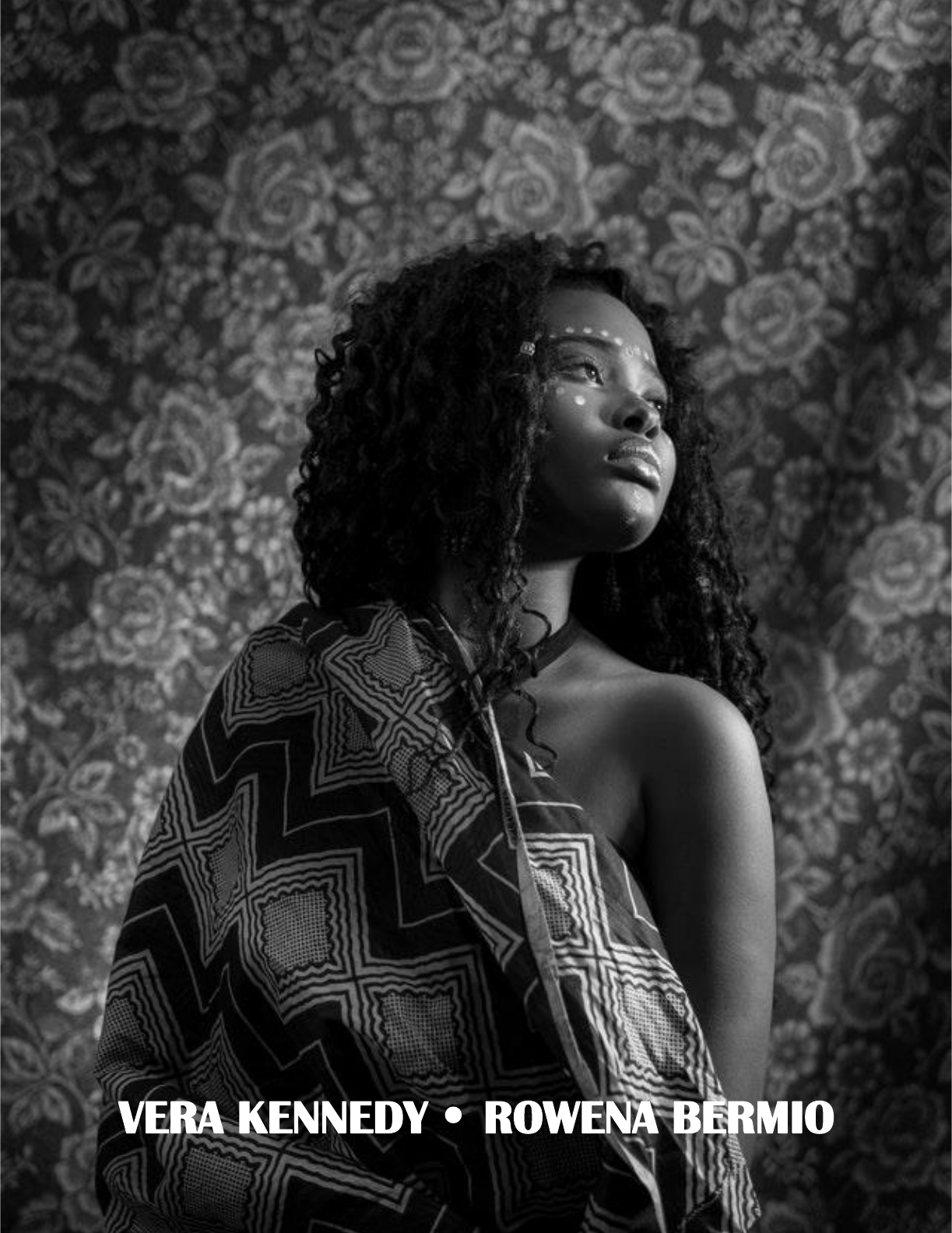
OUR LIVES: AN ETHNIC STUDIES PRIMER ii
This work is licensed under a Creative Commons Attribution-NonCommercial 4.0 International License.
CONTRIBUTING AUTHORS
Guadalupe Capozzi
Silas Cha
Daryl Johnson
EDITOR
Neomi Daniels
CONTENT REVIEWERS
Katie Conklin
Greg Kennedy
Rene Paredes
Jacqui Shehorn
Kelsey Smith
COVER IMAGE
Image by Jackson David, Pexels is licensed under CC BY 4.0
COPYRIGHT
Produced and distributed under a Creative Commons License in June 2022.
“Our Lives: An Ethnic Studies Primer” by Vera Kennedy and Rowena Bermio is licensed under
CC BY-NC 4.0.
The contents of this book were developed under an Open Textbooks Pilot grant from the Fund
for the Improvement of Postsecondary Education (FIPSE), U.S. Department of Education.
However, those contents do not necessarily represent the policy of the Department of
Education, and you should not assume endorsement by the Federal Government.

OUR LIVES: AN ETHNIC STUDIES PRIMER iii
This work is licensed under a Creative Commons Attribution-NonCommercial 4.0 International License.
TABLE OF CONTENTS
Module 1. The Significance of Ethnic Studies............................................................................... 1
Learning Objectives ................................................................................................................................... 1
Key Terms & Concepts ............................................................................................................................... 1
Introduction ............................................................................................................................................... 2
Application 1.1 Acknowledging Indigenous People’s Land ................................................................... 3
Understanding Race................................................................................................................................... 4
Application 1.2 Breaking the Illusion of Skin Color ............................................................................... 4
Race-Ethnic Relations Today...................................................................................................................... 6
Application 1.3 Leadership Development through Intergroup Dialogue ............................................. 8
Race-Ethnic Group Perceptions ................................................................................................................. 8
Explanations of Racial Inequalities .......................................................................................................... 10
Table 1. Structural Factors of Social Position & Intergroup Relations ............................................... 11
Application 1.4 Intergroup Dialogue & Social Change ........................................................................ 13
Application 1.5 Social Distancing by Race & Ethnicity ........................................................................ 15
Reality of Inequality ................................................................................................................................. 16
Table 2. Indicators of Racial Ethnic Inequality in the United States .................................................. 16
Table 3. Indicators of Racial Ethnic Inequality in the United States .................................................. 16
Application 1.6 Housing Discrimination .............................................................................................. 18
Summary .................................................................................................................................................. 18
Review Questions .................................................................................................................................... 18
To My Future Self .................................................................................................................................... 18
References ............................................................................................................................................... 19
Module 2. Our Power & Identity ................................................................................................ 21
Learning Objectives ................................................................................................................................. 21
Key Terms & Concepts ............................................................................................................................. 21
Introduction ............................................................................................................................................ 22
Collective Culture ..................................................................................................................................... 22
Social & Cultural Bonds ....................................................................................................................... 23
Biographical Reflection 2.1 When Did You Become Black? ................................................................ 25
Levels of Culture ................................................................................................................................. 26

OUR LIVES: AN ETHNIC STUDIES PRIMER iv
This work is licensed under a Creative Commons Attribution-NonCommercial 4.0 International License.
Groups & Organizations ...................................................................................................................... 26
Application 2.1 Your Regional Culture ................................................................................................ 27
Doing Culture ...................................................................................................................................... 29
Identity Formation & Politics ................................................................................................................... 30
Intersectionality .................................................................................................................................. 31
Application 2.2 The Privilege & Oppression of Intersectionality ........................................................ 32
Globalization & Identity ...................................................................................................................... 33
Identity Today ..................................................................................................................................... 34
Cultural Change & Adaptation ................................................................................................................ 35
Othering & Belonging .............................................................................................................................. 36
Biographical Reflection 2.2 One Times Three Equals One .................................................................. 38
Application 2.3 The Meaning & Impact of Your Story ........................................................................ 39
Application 2.4 Privilege & Life Chances ............................................................................................. 40
Biographical Reflection 2.3 Single Mother Gets a Bad Rap ................................................................ 41
Summary .................................................................................................................................................. 41
Review Questions .................................................................................................................................... 42
To My Future Self .................................................................................................................................... 42
References ............................................................................................................................................... 42
Module 3. Our Story: Native Americans ..................................................................................... 45
Learning Objectives ................................................................................................................................. 45
Key Terms & Concepts ............................................................................................................................. 45
Introduction ............................................................................................................................................ 45
Indigenous Peoples of the Americas ....................................................................................................... 46
Contact & Conflict with the “Old World” ................................................................................................ 46
English Colonial Period ............................................................................................................................ 47
Westward Expansion............................................................................................................................... 49
Application 3.1 Shifting Perspective: Cherokee Indians ..................................................................... 50
The 20
th
Century ...................................................................................................................................... 53
Application 3.2 Shifting Perspective: Alcatraz Proclamation .............................................................. 54
Application 3.3 Our Fires Still Burn ..................................................................................................... 55
The Recent Past ....................................................................................................................................... 55

OUR LIVES: AN ETHNIC STUDIES PRIMER v
This work is licensed under a Creative Commons Attribution-NonCommercial 4.0 International License.
Summary .................................................................................................................................................. 56
Review Questions .................................................................................................................................... 56
To My Future Self .................................................................................................................................... 56
References ............................................................................................................................................... 57
Module 4. Our Story: African Americans .................................................................................... 58
Learning Objectives ................................................................................................................................. 58
Key Terms & Concepts ............................................................................................................................. 58
Introduction ............................................................................................................................................ 59
Colonial Period to Reconstruction .......................................................................................................... 59
Application 4.1 Shifting Perspective: Benjamin Banneker .................................................................. 62
Application 4.2 Shifting Perspective: Justifying Slavery ...................................................................... 64
1877 to WWII .......................................................................................................................................... 67
Application 4.3 Shifting Perspective: What is Race? .......................................................................... 69
Civil Rights Movement of the 60s & 70s ................................................................................................. 71
Application 4.4 Shifting Perspective: Letter from Birmingham .......................................................... 72
The Recent Past ....................................................................................................................................... 73
Biographical Reflection 4.1 A Proud American, or a Proud African American? ................................. 74
Summary .................................................................................................................................................. 75
Review Questions .................................................................................................................................... 75
To My Future Self .................................................................................................................................... 75
References ............................................................................................................................................... 75
Module 5. Our Story: Asian Americans ...................................................................................... 77
Learning Objectives ................................................................................................................................. 77
Key Terms & Concepts ............................................................................................................................. 77
Introduction ............................................................................................................................................ 77
Mid 1800s to early 20
th
Century ............................................................................................................. 78
Global Conflicts & the 20
th
Century ........................................................................................................ 82
Application 5.1 Shifting Perspective: Self-Determination .................................................................. 82
Application 5.2 Shifting Perspective: Japanese Internment ............................................................... 83
New Immigrants & Expansion of Diversity .............................................................................................. 83
The Recent Past ....................................................................................................................................... 85
Biographical Reflection 5.1 Southeast Asian Refugees....................................................................... 86
Summary .................................................................................................................................................. 88

OUR LIVES: AN ETHNIC STUDIES PRIMER vi
This work is licensed under a Creative Commons Attribution-NonCommercial 4.0 International License.
Review Questions .................................................................................................................................... 88
To My Future Self .................................................................................................................................... 88
References ............................................................................................................................................... 88
Module 6. Our Story: Latinx Americans ..................................................................................... 90
Learning Objectives ................................................................................................................................. 90
Key Terms & Concepts ............................................................................................................................. 90
Introduction ............................................................................................................................................ 90
Indigenous People’s & Colonization ....................................................................................................... 91
Westward Expansion & Warfare ............................................................................................................. 92
Labor & Civil Rights ................................................................................................................................. 96
Application 6.1 Shifting Perspective: Zoot Suit Riots .......................................................................... 97
Application 6.2 Shifting Perspective: Labor & the Struggle of Migrant Farm Workers ...................... 99
The Recent Past ..................................................................................................................................... 100
Biographical Reflection 6.1 A Little Goes a Long Way ...................................................................... 101
Summary ................................................................................................................................................ 101
Review Questions .................................................................................................................................. 102
To My Future Self .................................................................................................................................. 102
References ............................................................................................................................................ 102
Module 7. Our Divisions ............................................................................................................ 103
Learning Objectives ............................................................................................................................... 103
Key Terms & Concepts ........................................................................................................................... 103
Introduction ........................................................................................................................................... 103
Cultural Hierarchies ............................................................................................................................... 104
Prejudice ................................................................................................................................................ 104
Biographical Reflection 7.1 New Home and Race Relations ............................................................. 105
Application 7.1 The Thinking Behind Prejudice ................................................................................ 109
Biographical Reflection 7.2 This is Not an Altercation ...................................................................... 110
Application 7.2 The Affect of Implicit Bias ........................................................................................ 114
Racism & Exploitation ........................................................................................................................... 114
Application 7.3 Little Acts of Discrimination ..................................................................................... 115
Application 7.4 Recognizing White Privilege ................................................................................... 116
Summary ................................................................................................................................................ 117

OUR LIVES: AN ETHNIC STUDIES PRIMER vii
This work is licensed under a Creative Commons Attribution-NonCommercial 4.0 International License.
Review Questions .................................................................................................................................. 117
To My Future Self .................................................................................................................................. 117
Application 7.5 Visual Ethnography Part 1 ....................................................................................... 118
Application 7.6 Visual Ethnography Part 2 ....................................................................................... 119
References ............................................................................................................................................. 119
Module 8. Our Way Forward .................................................................................................................. 123
Learning Objectives ............................................................................................................................... 123
Key Terms & Concepts ........................................................................................................................... 123
Introduction ........................................................................................................................................... 124
Racial & Social Justice ............................................................................................................................ 124
Biographical Reflection 8.1 The Blue Mornings ................................................................................ 125
Reducing Prejudice ........................................................................................................................... 128
Biographical Reflection 8.2 My Turn, Why Ending Prejudice Is Not a Hopeless Cause .................... 130
Building Community .............................................................................................................................. 132
Table 4. Anti-Racist & Anti-Colonial Practices .................................................................................. 132
Cultural Intelligence .......................................................................................................................... 132
Biographical Reflection 8.3 Religious & Cultural Conflict ................................................................. 134
Application 8.1 Cultural Intelligence Resources ............................................................................... 136
Conflict Resolution Strategies & Practices ........................................................................................ 137
Table 5. Five Modes of Resolving Conflict ........................................................................................ 138
Application 8.2 Conflict Reduction In Action .................................................................................... 139
Table 6. Conflict Reduction Techniques ........................................................................................... 140
Truth Telling & Social Discourse ....................................................................................................... 140
Table 7. Types of Ignorance .............................................................................................................. 141
Summary ................................................................................................................................................ 142
Review Questions .................................................................................................................................. 142
To My Future Self .................................................................................................................................. 142
Application 8.3Fostering Connections .............................................................................................. 143
References ............................................................................................................................................. 144

OUR LIVES: AN ETHNIC STUDIES PRIMER viii
This work is licensed under a Creative Commons Attribution-NonCommercial 4.0 International License.
PREFACE
Dear Student & Faculty Scholars,
This book is an introduction or primer to ethnic studies and is not a complete or comprehensive
review of the literature. We identified and included major concepts, theories, perspectives, and
voices in ethnic studies with research from anthropology, history, political science, psychology,
and sociology to offer an inclusive approach for critical inquiry.
The content was reviewed by our peers using the Academic Senate for California Community
Colleges Open Educational Resources Initiative Evaluation Rubric and Inclusion, Diversity,
Equity, and Anti-Racism (IDEA) Audit Framework.
The manuscript is openly licensed to offer our readers the opportunity to revise, remix,
redistribute, reuse, retain, and expand the literature to fit learning needs. We encourage you to
think about and consider your own family history, stories, and traditions as you explore and
build on this content.

OUR LIVES: AN ETHNIC STUDIES PRIMER ix
This work is licensed under a Creative Commons Attribution-NonCommercial 4.0 International License.
A NOTE TO OUR READERS
The American Dream. We are all familiar, right? Immigrants throughout our history have come
to the country with the belief that the opportunities are endless. For the founding fathers, it
was the “pursuit of property.” For John O’Sullivan it was the right “to [the] possession of the
homes conquered from the wilderness of their own labors and dangers,” and for Franklin D.
Roosevelt, it was the “Four Freedoms” – Freedom of Speech and worship, as well as freedom
from want or fear. For many immigrants and people of color, this American Dream was
farfetched and difficult to attain, but they continued to try – if not for themselves, but for their
children.
But they were met with resistance. Obstacles. Legislation. Discrimination. Hatred and violence.
Who is America? This question can seem simple at first glance, but then gradually becomes
more complicated as we contemplate our answer. Over the course of its history, the people of
America have changed drastically, diversifying extensively. Each group that has contributed to
this diversity has a story - a history that is both unique and sometimes similar to other groups in
America. The historical narrative presented here seeks to illustrate the people often overlooked
for their contributions to the nation that we call home.
The historical narrative was written under the framework of a few concepts. First, we followed
a general timeline that is covered in most U.S. history survey courses. The timeline allows the
reader to find some familiarity with the narrative that they have already learned in formative
years. This approach might also serve as a refresher for some students. Secondly, while the
traditional narrative and timeline was followed, some key events were given less attention, or
left out altogether. This was a choice made to diversify the historical narrative and expand the
perspectives of the traditional description to include Black, Brown, Asian, and Indigenous
peoples’ voices. Lastly, this is a primer in ethnic studies, and should serve as an opening to
widen one’s scope of knowledge with inclusivity and equity in mind.
Historically, some language used to label or categorize groups covered in this book has been
problematic. Labels and identity are deeply personal to most people and should be respected.
With those notions in mind, we have aligned our terminology with the generally accepted
academic terms of racial groups, along with current trends in accepted language.
The historical narrative presented in this book is meant to assert voices once unheard, voices
that believed and continue to believe in the possibilities of the American Dream, voices that
embody a fierce spirit of freedom and opportunity. Together, they have been an integral part of
the forging of this country. These are their stories.
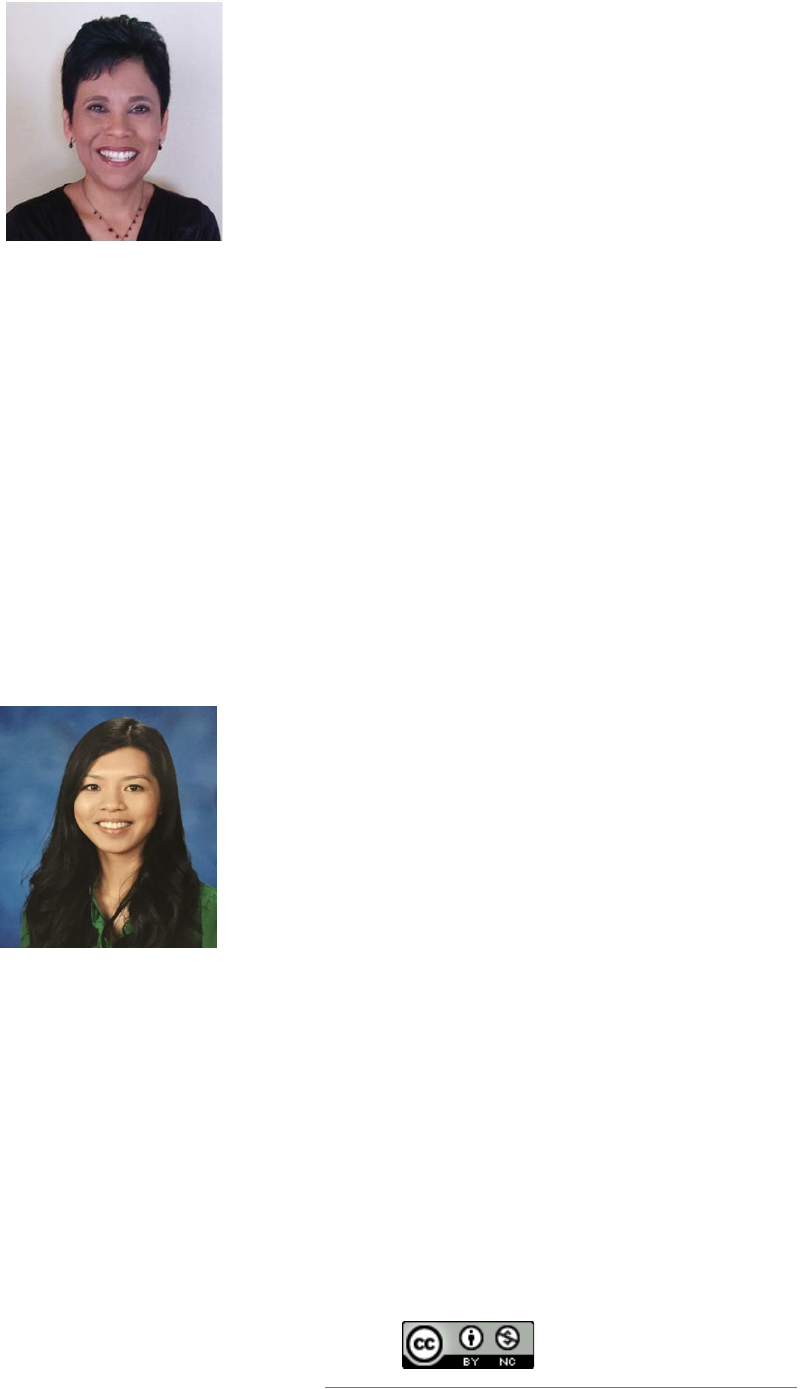
OUR LIVES: AN ETHNIC STUDIES PRIMER x
This work is licensed under a Creative Commons Attribution-NonCommercial 4.0 International License.
Vera Guerrero Kennedy was born and raised in San Joaquin Valley,
California. She received a B.A. in sociology (1995), M.P.A. in political
science with an emphasis in public administration (1999) from Fresno
State and a doctorate in education (Ed.D.) with an emphasis in
curriculum and instruction from Argosy University (2012).
Vera is a tenured faculty at West Hills College Lemoore and Lecturer at
Fresno State. Her publications include The Influence of Cultural Capital
on Hispanic Student College Graduation Rates (2012), Critical Thinking
about Social Problems (2017), Beyond Race: Cultural Influences on Human Social Life (2018),
and A Career in Sociology (2020). She is also faculty for the 2021-2022 American Association of
Colleges & Universities Institute on Open Educational Resources and recently completed
appointments as the Distance Education Program Coordinator & Pedagogical Coach at West
Hills College Lemoore (2020-21) and OER Fellow at Fresno State (2019).
Before teaching full-time, Vera was the Juvenile Justice Services Coordinator for the Fresno
Superior Court and assisted in the establishment facilitation of the Juvenile Mental Health Court
for Fresno County. She served on the Board of Directors for Comprehensive Youth Services, a
child abuse prevention agency, and was appointed by the Fresno County Board of Supervisors
to serve on the Fresno County Foster Care Oversight Committee for six years.
She and her husband, Greg, reside in Fresno, California with their Pomeranian, Otter.
Rowena Bermio is the child of Filipino immigrants that came to
California in the early 1980s. She received her master’s degree in
history from California State University Fresno and also retains a degree
in art history. For the last six years, she has taught U.S. and world
history for Fresno State, West Hills College Lemoore, and other
community colleges in the Central Valley.
At West Hills, Rowena is an active member of the Social Justice and
Equity Task Force, aiding in efforts to enhance inclusivity and equity at
the college. She has given several lectures on culture and diversity on campus with task force
goals in mind.
Rowena currently lives and teaches in the Central Valley with her partner Margaret, and their
pets Shane, Tig, and Mad Max.
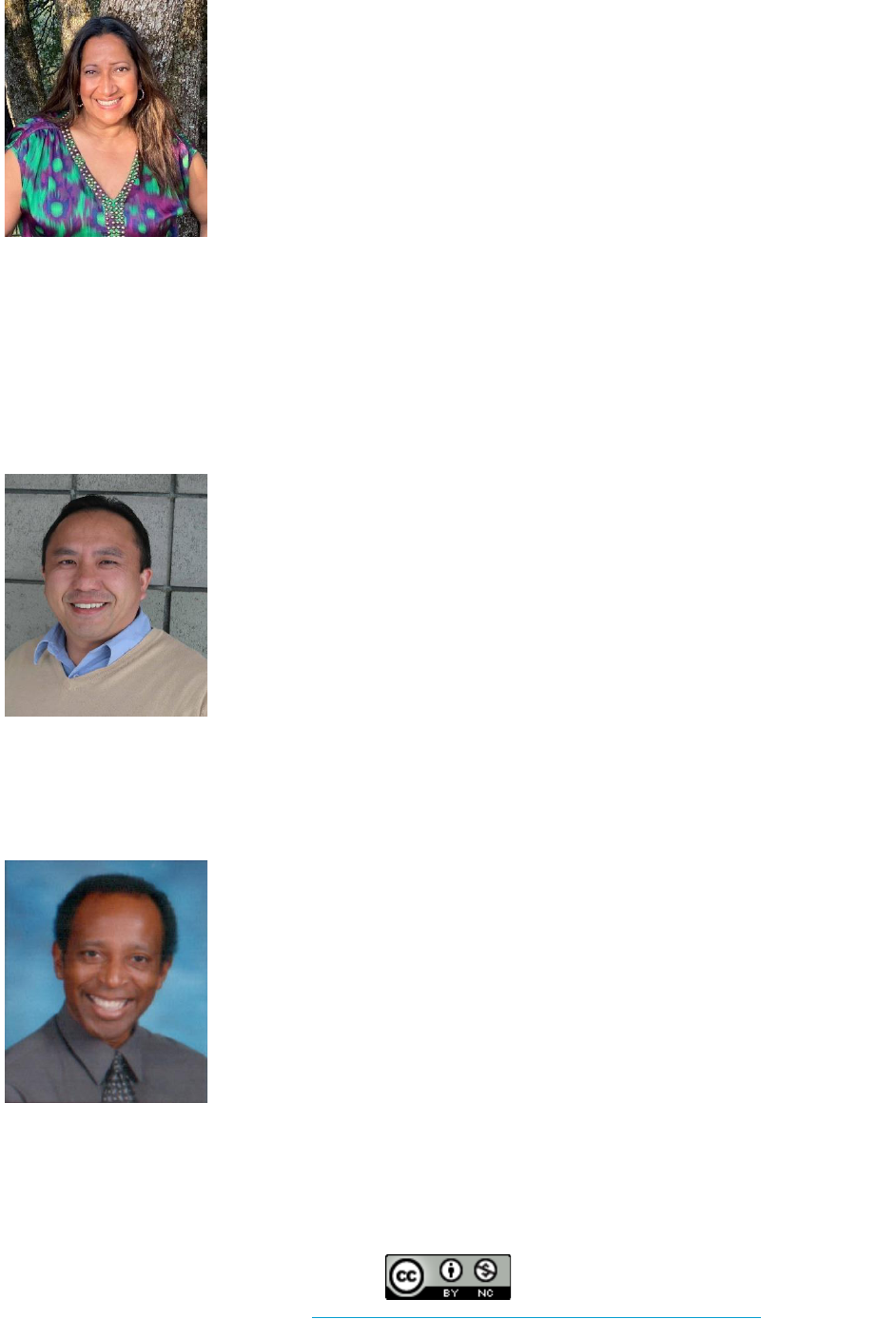
OUR LIVES: AN ETHNIC STUDIES PRIMER xi
This work is licensed under a Creative Commons Attribution-NonCommercial 4.0 International License.
Guadalupe Capozzi is a native of the Central Valley and teaches
criminal justice at West Hills College Lemoore. She started her career as
a Correctional Officer for the California Department of Corrections,
California Correctional Facility for Women in Chowchilla, California then
promoted to a Correctional Counselor at the Substance Abuse and
Treatment Facility in Corcoran, California. In 2003 she transitioned to a
Parole Agent. Most recently, she has managed two parole units in Kings
and Tulare Counties including Coalinga State Hospital. Guadalupe
earned her B.A. in criminal justice with an emphasis on restorative
justice from Fresno Pacific University in Fresno, California. She teaches Principled Policing,
Family Systems, Staff Suicide Awareness, and Diversity in the Workplace at the Basic Parole
Agent Academy and is the assistant training coordinator for the district. She previously worked
as a Communicable Disease Consultant and Investigator with the State Department of
Health. Guadalupe serves on the board of Champions Recovery of Kings County and is a
member of the Women’s Ministry at her church. She and her four children live in Lemoore,
California.
Silas Cha holds a Bachelor of Arts in philosophy from the University of
California, Berkeley and a Master of Arts in international relations from
California State University, Fresno. He teaches political science and
ethnic studies at the community college and cross-cultural job training
and business ethics at Fresno Center for New Americans, a non-profit
organization. While serving as the associate director of the non-profit
organization, Silas conducted research on Hmong, Lao, Cambodian, and
Vietnamese resettlement patterns in the Central Valley as related to
education, social and race relations, health, housing, and economic
development. In addition, Silas served as an advisory member for Valley Health Policy Institute
at Fresno State and The Fresno Bee, where he published monthly articles as a guest columnist.
Many of the issues in his columns were on cross-cultural nuances, race relations, religious and
medical conflicts, and social justice. He is married to a wonderful wife and has two daughters.
Daryl Johnson has a master’s degree in public administration and
human resources from Gate University, San Francisco, California. He
also holds an M.A. in education from Fresno Pacific University, Fresno,
California. He grew up in Washington State and received his
undergraduate degree in communications from the University of
Washington in Seattle and possesses California state certifications as a
teacher performance assessor, ESL instructor, and community college
speech instructor. He currently serves as Lead Instructor for the Fresno
Pacific University Teacher Preparation Program and is a
communications instructor at West Hills College Lemoore. Mr. Johnson is a former USAF officer
and civil servant, with service in Korea, Germany, and stateside. He designed the compensatory
education program for NATO Base Geilenkerchen, Germany’s military dependent children, and
worked for NATO as an ELD instructor. He and his family currently live in Hanford, California.

OUR LIVES: AN ETHNIC STUDIES PRIMER 1
This work is licensed under a Creative Commons Attribution-NonCommercial 4.0 International License.
MODULE 1. THE SIGNIFICANCE OF ETHNIC STUDIES
LEARNING OBJECTIVES
At the end of the module, students will be able to:
1. understand the difference between race and ethnicity
2. discuss the social construction of race
3. explain racial framing
4. compare intergroup relations in terms of racial-ethnic group conflict and tolerance
5. assess systemic racism and structural explanations for racial and ethnic inequality
6. evaluate the intersectionality of race, ethnicity and other social categories on systems of
oppression
7. provide examples of racial-ethnic stratification and inequality
8. define majority (dominant) and minority groups (subordinate)
9. interpret social indicators and data on racial and ethnic inequality in the United States
KEY TERMS & CONCEPTS
Achieved Status
Ascribed Status
Competition
Dominant Group
Double Consciousness
Egocentric
Ethnicity
Ethnocentrism
Fluid Competitive Race Relations
Genocide
Internal Colonialism
Intersectionality
Labels
Macro-level
Micro-level
Minority Groups
Multiculturalism
Otherness
Paternalistic Pattern
Patterns of Intergroup Relations
Pluralism
Population Transfer
Race
Racial Disparities and Inequality
Racial Formation
Rigid Competitive Pattern
Segregation
Social Status
Sociocentrism
Status Shifting
Stratification
Subordinate Group
Systemic Racism
Unequal Power
OUR LIVES: AN ETHNIC STUDIES PRIMER 2
INTRODUCTION
Have you ever had your experience or story misrepresented or retold in an inaccurate way?
Has anyone ever taken something of value from you without asking or providing
compensation?
The feelings and thoughts you hold about these questions are not different from other people
in the United States, particularly those who were forcible driven from their homeland,
smuggled into this country from another place, stripped of their identity, exploited for their
resources and labor, or those who have been killed or murdered for being different. The most
disturbing part of our history and the characterization of these incidences is the ongoing denial,
recognition, and reparations for the people who today remain inflicted by the
misrepresentation and injustice of our social structures, institutions, and ideologies. No one
likes their history or experience retold through fallacies, stereotypes, or lies. No one likes their
life or way of living taken from them involuntarily.
Technology and social media have made it easy to block out and change what we hear and
think about each other, our experiences, and our stories. Ironically, these tools have also made
it easier to share our lives and bring others into our world without time or borders.
Why is it important to share your experience or tell your story in an honest and accurate way?
What is the value in sharing your experience or story?
By telling our stories and sharing our experiences, we acknowledge our existence and
humanity. Because we have not retold or allowed some people to share their stories and
experiences, we deprive them of this acknowledgement. We make some people less than
human and justify it by keeping truths and facts hidden.
This book examines race and ethnicity as understood through our history and the experiences
of major underrepresented racial groups including African Americans, Asian Americans, Latinx
Americans, and Native Americans in the United States. We will explore a broad range of
sociocultural, intellectual, and historical experiences that form the construction and
intersectionality of race and ethnicity in the United States by applying macro and micro
perspectives of analysis. Furthermore, we will examine the cultural and political contexts
behind the systems of power, privilege, and inequality impacting Americans of color. Emphasis
is placed on racial and social justice with methods for building a just and equitable society.

OUR LIVES: AN ETHNIC STUDIES PRIMER 3
APPLICATION 1.1
ACKNOWLEDGING INDIGENOUS PEOPLE’S LAND
Goal
To illustrate and compose a method for acknowledging Indigenous people’s land to recognize its connection to
our lives and country.
Instructions
1. Honor Native Land
Acknowledgement is a simple, powerful way of showing respect and a step toward correcting the stories and
practices that erase Indigenous people's history and culture by inviting and honoring the truth. Naming is an
exercise in power. Who gets the right to name or be named? Whose stories are honored in name? Whose are
erased? Acknowledgement of traditional land is a public statement by naming the traditional Native
inhabitants of a place. It honors their historic relationship with the land.
We are introducing the practice of land acknowledgment to create greater public consciousness of Native
sovereignty and cultural rights, a step toward equitable relationship and reconciliation. Join us in adopting,
calling for, and spreading this practice. To participate in this activity, take a moment to research and identify
the traditional inhabitants of the land you are on today.
Here are some resources you may view online:
Wikipedia - Entries on many cities document some history of Indigenous inhabitation. Cross-check what you
find to verify accuracy.
Native Land (https://native-land.ca/) - The website provides educational resources to correct the way that
people speak about colonialism and indigeneity, and to encourage territory awareness in everyday speech and
action.
Native Languages (http://www.native-languages.org/) - The resource offers a breakdown by state, with
contact information for local tribes.
2. Amplify Your Acknowledgement
Take a moment to acknowledge the traditional inhabitants of the land you are on today. Post an image or story
about this class activity on social media where your acknowledgement was offered and tag it
#HonorNativeLand to inspire others.
3. Honor Native Land Guide
#HonorNativeLand (https://usdac.us/nativeland)
This resource provides individuals and organizations a guide on how to open public events and gatherings with
acknowledgment of the traditional Native inhabitants of the land.
4. Develop Your Acknowledgement
Formulate a statement of acknowledgment you may share at the beginning of class meetings, campus events,
or public gatherings. Craft yours after considering several levels of detail you might introduce as illustrated on
page 6 of the Honor Native Land Guide (https://usdac.us/nativeland). Be prepared to share your
acknowledgment with other scholars in class meetings.
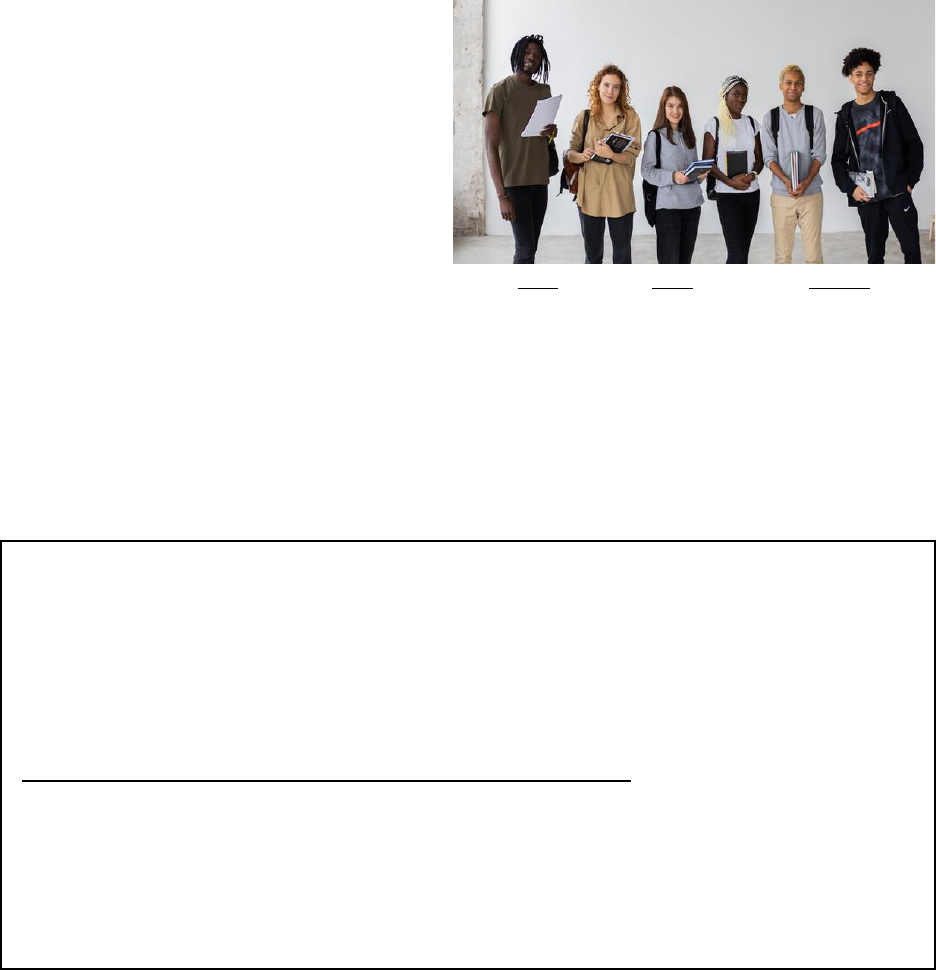
OUR LIVES: AN ETHNIC STUDIES PRIMER 4
UNDERSTANDING RACE
There are two myths or ideas about race. The first suggests people inherit physical
characteristics distinguishing race. The second insinuates that one race is superior to others or
that one “pure” race exists.
Scientific research mapping of the human genome system found that humans are homogenous
(Henslin, 2011). Race is truly an arbitrary label that has become part of society’s culture with no
justifiable evidence to support differences
in physical appearance to substantiate the
idea that there are a variety of human
species. Scientific data finds only one
human species making up only one human
race. Evidence shows physical differences in
human appearance including skin color are
a result of human migration patterns and
adaptions to the environment (Jablonski,
2012). These data underline the fact that
the concept of race is socially constructed.
Society chooses to define the basis and classification of physical characteristics. Racial terms
classify and stratify people by appearance and inherently assign individuals and groups as
inferior or superior in society based on their physical traits (Kottak & Kozaitis, 2012). This
classification and social status of race and racial groups change over time and varies from one
society to another as viewpoints, perspectives, and knowledge adapts and evolves. People use
physical characteristics to identify, relate, and interact with one another.
APPLICATION 1.2
BREAKING THE ILLUSION OF SKIN COLOR
Goal
To understand the influence of the atmosphere, environment, and adaptation on skin color.
Instructions
Watch the TED-Ed video Breaking the Illusion of Skin Color presented by Nina Jablonski
(https://ed.ted.com/lessons/nina-jablonski-breaks-the-illusion-of-skin-color). Answer the following questions
about skin color and adaptation:
1. Why does Dr. Jablonski study NASA satellite data?
2. Why and how did lightly pigmented skin develop?
3. What are the potential health problems for darkly pigmented people living in low-UV areas of the
world?
4. According to Dr. Jablonski, where did Charles Darwin go wrong?
Image by Monstera, Pexels is licensed under CC BY 4.0
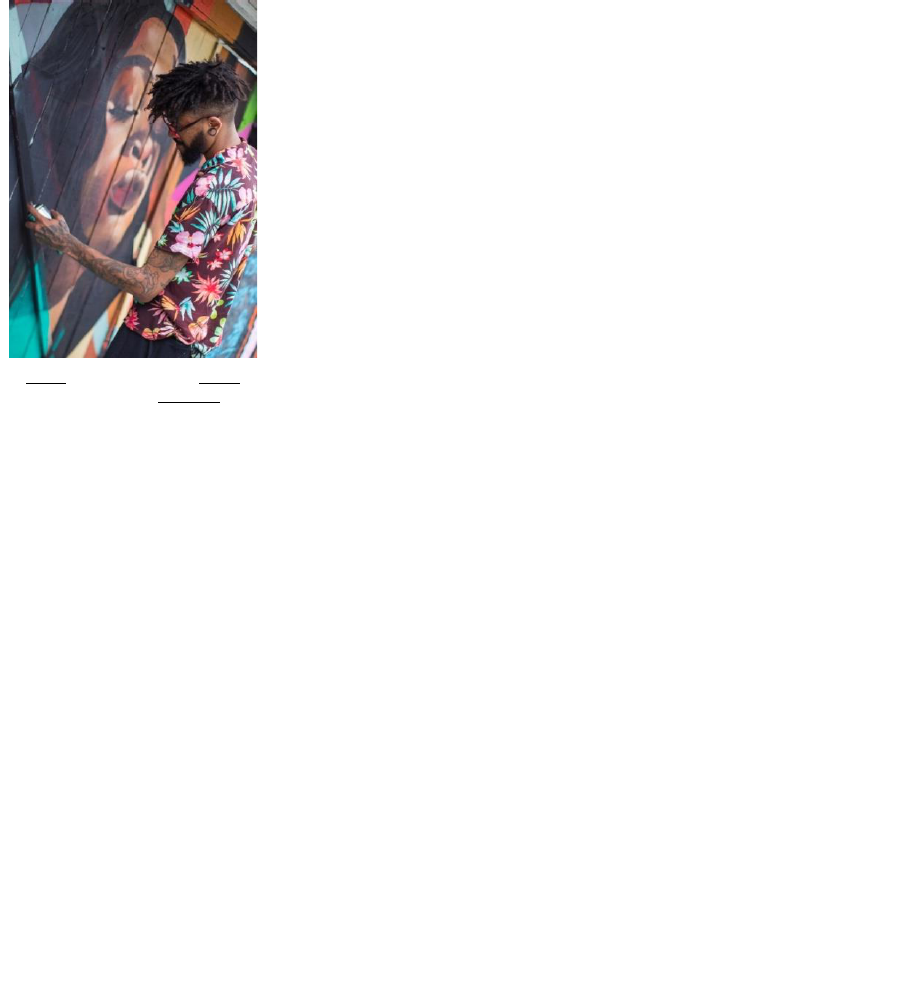
OUR LIVES: AN ETHNIC STUDIES PRIMER 5
In this book, we will discuss and use the terms race and racial group interchangeably. Even
though the concept of race is not biologically sound, people do identify with the term and are
often grouped based on the socially constructed concept of race. In reality, race and racial
group classification influences people’s life experiences and choices (Farley, 2010; Winant,
1994; Taylor, 1998; Duster, 2001).
The social process of recognizing and defining racial characteristics,
labels, and groups is known as racial formation (Omi & Winant,
1994). This process solidifies how race is understood and is
propelled by political interests. The results directly impact the
social and political consequences of people’s lives, and it is the
primary reason society recognizes race as an important
classification and why its definition and meaning transform over
time (Farley, 2010). Powerful and influential people use race to
create divisions or bring people together, whichever serves their
interests.
Ethnicity refers to the cultural characteristics related to ancestry
and heritage. Ethnicity describes shared culture such as group
practices, values, and beliefs recognized by people in and the group
itself (Griffiths et al., 2015). People who identify with an ethnic
group share common cultural characteristics (i.e., nationality, history, language, religion, etc.).
Ethnic groups select rituals, customs, ceremonies, and other traditions to help preserve shared
heritage (Kottak & Kozaitis, 2012).
Lifestyle and other identity characteristics such as geography and region influence how we
adapt our ethnic behaviors to fit the context, environment, or setting in which we live. Culture
is also central in determining how humans grow and develop including diet, food preferences,
and cultural traditions promoting physical activities, abilities, well-being, and sport (Kottak &
Kozaitis, 2012). A college professor of Mexican decent living in Central California will project
different behaviors than someone of the same ethnic culture who is a housekeeper in Las
Vegas, Nevada. Differences in profession, social class, and region will influence each person’s
lifestyle, physical composition, and health though both may identify and affiliate themselves as
Mexican.
The ethnicity of parents largely determines the ethnicity of offspring through socialization.
Ethnicity is a social characteristic, like race, that is passed from generation to generation
(Farley, 2010). For example, the California natives of the San Joaquin Valley known as Yokuts,
meaning people, were divided into true tribes each with their own name, language, and
territory (Tachi Yokut Tribe, 2021). Learning cultural traits and characteristics are important for
developing identity and ethnic group acceptance. Cultural socialization occurs throughout one’s
life course.
Image by Thiago Miranda, Pexels
is licensed under CC BY 4.0
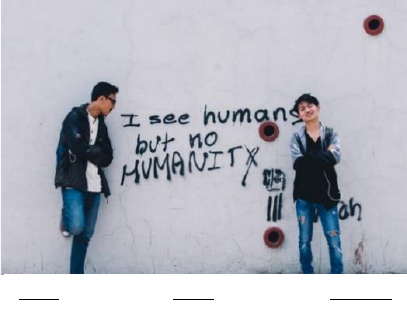
OUR LIVES: AN ETHNIC STUDIES PRIMER 6
Not all people see themselves as belonging to an ethnic group or view ethnic heritage as
important to their identity. People who do not identify with an ethnic group either have no
distinct cultural background because their ancestors come from a variety of cultural groups and
offspring have not maintained a specific culture, instead have a blended culture, or they lack
awareness about their ethnic heritage completely (Kottak & Kozaitis, 2012). It may be difficult
for some people to feel a sense of solidarity or association with any specific ethnic group
because they do not know where their cultural practices originated and how their cultural
behaviors adapted over time.
What is your ethnicity? Is your ethnic heritage very important, somewhat important, or not
important in defining who you are? Why?
RACE-ETHNIC RELATIONS TODAY
At present, people of color are now more than 80% of the world’s population and becoming the
demographic majority (Feagin, 2014). The U.S. population is more diverse than ever in its
history, and it is projected that by the year of 2040 Whites will become the statistical minority
in the United States. With these demographic changes, Americans of color will become more
influential in politics, economics, and increase societal pressure to them with greater equity and
justice.
Intergroup relations between racial-ethnic groups
are complex. Because racial-ethnic group creation
is politically motivated, people of color often
experience frustration, anger, and trauma from
ongoing conflict, discrimination, and inequality
(Farley, 2010). Our race and ethnic heritage shapes
us in many ways and fills us with pride, but it is
also a source of conflict, prejudice, and hatred.
There are seven distinct patterns of intergroup
relations between majority (powerful) and
minority (subordinate) groups influencing not only
the racial and ethnic identity of people but also the opportunities and barriers each will
experience through social interactions. Maladaptive contacts and exchanges include genocide,
population transfer, internal colonialism, and segregation. Genocide attempts to destroy a
group of people because of their race or ethnicity. “Labeling the targeted group as inferior or
even less than fully human facilitates genocide” (Henslin, 2011, p. 225). Population transfer
moves or expels a minority group through direct or indirect transfer. Indirect transfer forces
people to leave by making living conditions unbearable, whereas direct transfer literally expels
minorities by force.
Another form of rejection by the dominant group is a type of colonialism. Internal colonialism
refers to a country’s powerful dominant group exploiting the low-status, minority group for
Image by Saroj Gajurel, Pexels is licensed under CC BY 4.0

OUR LIVES: AN ETHNIC STUDIES PRIMER 7
economic advantage. Internal colonialism generally accompanies segregation (Henslin, 2011). In
segregation, minority groups live physically separate from the dominant group by law.
Three adaptive intergroup relations include assimilation, multiculturalism, and pluralism. The
pattern of assimilation is the process by which a minority or less powerful group assumes the
attitudes and language of the dominant or mainstream culture. An individual or group gives up
its identity by taking on the characteristics of the dominant culture (Griffiths et al., 2015). For
example, the original language, cultures, and family ties of African Americans were destroyed
through slavery, and any wealth or resources gained since have been challenged or taken
through White-on-Black oppression. When minorities assimilate by force to dominant
ideologies and practices, they can no longer practice their own religion, speak their own
language, or follow their own customs. In permissible assimilation, minority, low-status groups
adopt the dominant culture in their own way and at their own speed (Henslin, 2011).
Multiculturalism is the most accepting intergroup
relationship between the powerful dominant and
subordinate minority. Multiculturalism or pluralism
encourages variation and diversity. Multiculturalism
promotes affirmation and practice of ethnic
traditions while socializing individuals into the
dominant culture (Kottak & Kozaitis, 2012). This
model works well in diverse societies comprised of a
variety of cultural groups and a political system
supporting freedom of expression. Pluralism is a
mixture of cultures where each retains its own
identity (Griffiths et al., 2015). Under pluralism, groups exist separately and equally while
working together such as through economic interdependence where each group fills a different
societal niche then exchanges activities or services for the sustainability and survival of all. Both
the multicultural and pluralism models stress interactions and contributions to their society by
all ethnic groups.
Intergroup conflict has many social and political consequences affecting the life of every
American (Farley, 2010). The most unsettling aspect is the inability or unwillingness of Whites
to see and understand the racist reality in the United States. Many Whites continue to deny
histories of racism, believe racism is a thing of the past, and do not acknowledge contemporary
racial framing and discrimination (Feagin, 2014). Whites perpetuate the ideology of “intergroup
conflict and relations” to establish the perception that all racial groups have equal impact or
resources. This corroborates an image of a level playing field among all racial groups rather
than the reality of a White-dominated and controlled systemic structure. To give an example,
for over four centuries African Americans have been subordinated and exploited for their labor.
Racial oppression has reinforced anti-Black practices, political-economic power of Whites, racial
and economic inequality, and racial framing to legitimize White privilege and power in
economic, political, legal, educational, and other institutions (Feagin, 2014).
Image by Ron Lach, Pexels is licensed under CC BY 4.0

OUR LIVES: AN ETHNIC STUDIES PRIMER 8
People of color experience the social world differently from Whites. The life chances and
opportunities for Americans of color are restricted in many ways, such as, who they can marry,
where they can live, what they wear or eat, who is a member of their school’s student body,
what curriculum and instruction they receive, what jobs or careers they can obtain, how they
pray, who they pray to, who represents their political interests, and what, if any, healthcare
they receive (Feagin, 2014). The institutions and services that are readily available to Whites are
not the same or always accessible for Americans of color. The few opportunities gained by
some people of color because of circumstance or chance, does not mitigate the inequities and
injustice most Americans of color live and experience. The White majority speaks about
equality but does not practice it across racial groups. Unaddressed inequities result in
continued turmoil between the majority and minority groups in the United States.
RACE-ETHNIC GROUP PERCEPTIONS
All Americans are indoctrinated in the patriotic principles of our nation’s history and the
ideologies of equality and freedom; however, these ideologies as defined by the founding
fathers and the United States Constitution are largely free of critical examination or criticism
(Parenti, 2006). Racial framing people of color dates back to our early history of colonialism and
slavery which established the foundation for White-dominated policies and institutions that
today continue to legitimize and encourage racists practices. In the United States, racist
APPLICATION 1.3
LEADERSHIP THROUGH INTERGROUP DIALOGUE
Goal
To recognize the skills needed to successfully lead or be part of a diverse team.
Instructions
1. Listen to perspectives on intergroup dialogue from students at Syracuse University
(https://youtu.be/TZaoRNsNDJI).
2. Review quotes from “Bridging Differences Through Dialogue” by Ximena Zúñiga.
• “Intergroup dialogue is face-to-face facilitated conversation between members of two or more social
identity groups that strives to create new levels of understanding, relating, and action.”
• “Intergroup dialogue encourages direct encounters and exchange about contentious issues, especially
those associated with issues of social identity and social stratification” (the hierarchy or division of
society based on status, rank, or class).
• “Dialogue that build dispositions and skills for developing and maintain relationships across
differences and for taking action for equity and social justice.”
3. Read the following article:
Nagada, B. (Ratnesh) A. (2019). Intergroup dialogue: Engaging difference for social change leadership
development. New Directions for Student Leadership, 2019(163), 29-46.
4. Identify and create a list of skills someone can develop by facilitating and participating in intergroup
dialogue.
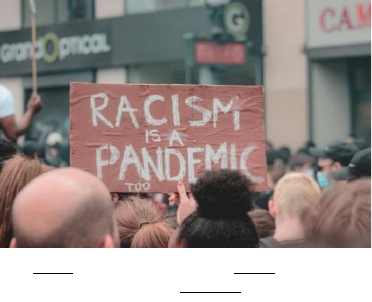
OUR LIVES: AN ETHNIC STUDIES PRIMER 9
thought, sentiments, and actions are structured into everyday life such that large portions of
the White population do not view racists words, imagery, or commentary as serious (Feagin,
2014). Racial framing is concrete and advantageous for Whites, while it constructs obstacles
and is painful for Americans of color. Everyone is directly and indirectly impacted by racial
framing.
Systemic racism in our institutions by its very definition creates and maintains racial
oppression. In the United States, systemic racism is the “culture.” The policies and norms
created by the racist system is socially reproduced like any other form of culture. What
Americans call collective culture is selective transmission of elite-dominated values (Parenti,
2006). We are socialized to understand and maintain the ideologies of our ancestors even if we
are the racial-oppressed or the racial oppressors (Feagin, 2014). The culture is embedded in our
systems we live in (e.g., economy, politics, education, religion, family, etc.) so it becomes
unconscious in our everyday lives and practices. Not everyone is aware of or sees racism
because it is a social norm.
This systemic structure of racism embodies other forms of societal differences and establishes
norms within those social categories as well. This includes formal and informal norms around
(dis)ability, age, gender, sexuality, social class, among others. These categories are
interconnected and apply to individual and group systems of disadvantage and discrimination.
The intersectionality of social categorizations creates overlapping and interdependent systems
of oppression. For example, the social markers of “Black” and “female” do not exist
independently in one’s life experience. It is the intersection of these categories that influences
the life’s opportunities or challenges, such as Black women earning $0.62 for every $1.00 by
men of all races (Center for American Progress, 2018; U.S. Census Bureau of Labor Statistics,
2019).
The ongoing denial of systemic racism has resulted in
racial disparities and inequality among Americans of
color including voter discrimination, racial profiling and
police brutality, school segregation, housing
discrimination, inequity and intolerance in college and
professional sports, discrimination against faculty and
administrators in higher education, and pro-White
favoritism in top-level employment sectors and boards
of directors (Feagin, 2014). The denial of racism stems
from the ideologies of our founding fathers designed
during the 1787 Constitutional Convention. Many
convention delegates of the time were anti-democratic in their thinking fearing the “masses.”
At least 40% of the delegation were slaveowners and many others were merchants, shippers,
lawyers, and bankers who profited from commerce in slave-produced products or supplies
(Feagin, 2014). The founding fathers were aware of how they profited from slavery, and despite
this understanding would describe their own sociopolitical condition with England as “slavery
by taxation without consent.” To this end, the Constitutional Convention built a new nation to
Image by Mathias P.R. Reding, Pexels is licensed
under CC BY 4.0
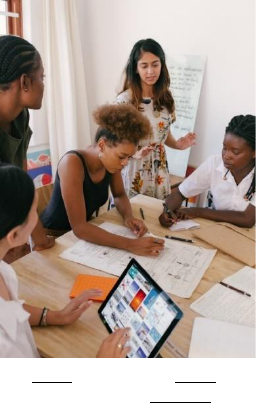
OUR LIVES: AN ETHNIC STUDIES PRIMER 10
protect the wealth of our founding fathers and those like them by defining rights using social
labels and categories such as Americans from Africa as “slaves by natural law,” indigenous
peoples as “separate nations,” or altogether excluding people, like women, by directly avoiding
inclusion. These policies and ideologies have become the foundation of American tradition.
The creation of a national racial order established at the Constitutional convention has ensued
severe consequences for centuries and yet remains the United States moral foundation. At no
point has a new Constitution or convention been held by representatives of all people to delete
the original text of racist provisions or eradicate the institutions that continue to hold
Americans of color in bondage (Douglas, 1881; DuBois, 1920; Feagin, 2014). The Constitution
created and maintained racial separation and oppression that has ensured White, elite men
would rule for centuries. Ordinary and poor Whites, even today, accept racialized order
because a White ruling class benefits White Americans and creates a positive image of
Whiteness.
Most recently, social scientists, analysts, and a new generation of Americans have argued that
there has been little attention on the racial histories, policies, and discrimination of people of
color in the United States (Feagin, 2014). There have been a variety of amendments and
resolutions by the U.S. government to acknowledge the racial injustice of our past such as the
2009 non-binding apology on the injustice of slavery and Jim Crow laws. However, these acts do
not provide real commitments or congressional actions to address the long-term impacts of
racial oppression or reduce contemporary racial discrimination (Feagin, 2014).
Considering the recent, high-profile incidents of police violence
against African Americans, what is the likelihood of racial change in
the United States? Will contemporary racial issues and social
awareness change the way Americans think? According to a Pew
Research Center survey by Horowitz, Parker, Brown, and Cox (2020),
approximately 76% of Americans note a major or minor change in
the way they think about race and racial inequality, but only 51%
believe there will be major policy changes to address racial
inequality. Results from the same survey found African Americans
(86%), Asian Americans (56%), Latinx Americans (57%), and Whites
(39%) believe when it comes to giving Black people equal rights with
White people, our country has not gone far enough. Approximately
48% of these respondents say more people participating in training
on diversity and inclusion would do a lot to reduce inequality.
EXPLANATIONS OF RACIAL INEQUALITIES
Social scientists use theories to study people. Theories help us examine and understand society
including the social structure and social value people create and sustain to fulfill human needs.
Theories provide an objective framework of analysis and evaluation for understanding the
social structure including the construction of the cultural ideologies, values, and norms and
Image by RF._.studio, Pexels is
licensed under CC BY 4.0

OUR LIVES: AN ETHNIC STUDIES PRIMER 11
their influence on thinking and behavior. Macro-level analysis studies large-scale social
arrangements or constructs in the social world. The macro perspective examines how groups,
organizations, networks, processes, and systems influences thoughts and actions of individuals
and groups (Kennedy, Norwood, & Jendian, 2017). Micro-level analysis studies the social
interactions of individuals and groups. The micro perspective observes how thinking and
behavior influences the social world such as groups, organizations, networks, processes, and
systems (Kennedy et al., 2017).
To understand the inequities in power and resources between racial-ethnic groups, we must
understand the social, political, and economic structure of society. A macro-level perspective
helps us understand the effect the social structure has on our life chances, opportunities, and
challenges. Whereas a micro-level perspective focuses on interpreting individual or personal
viewpoints and influences. Using only a micro-level perspective to understand racial-ethnic
inequality leads to an unclear understanding of the world from singular bias perceptions and
assumptions about people, social groups, and society (Carl, 2013). To study race and ethnic
relations and inequality, we must analyze groups and societies not simple individuals.
Race and ethnic identity influence social status or position in society. Social status serves as a
method for building and maintaining boundaries among and between people and groups.
Status dictates social inclusion or exclusion resulting in stratification or hierarchy whereby a
person’s position in society regulates their social participation by others. Racial-ethnic
inequality is a circumstance of stratification where inequality is based on race and ethnic
composition of the individual or group.
There are several structural factors that shape social stratification and intergroup relations in
society. According to Farley (2010), there are seven characteristics of a society that effect
majority-minority relations. The major influences include economics, politics, institutions, social
and cultural characteristics, and history.
Table 1. Structural Factors of Social Position and Intergroup Relations
Structural Factor
Description
Economic System
Type of economy (i.e., capitalist, feudal, socialist, etc.) including methods of
income and wealth distribution
Economic Production
Labor, capital, goods and services to create and distribute products
Political System
Type of politic structure, power relationships between groups, and degree of
political freedom
Fundamental Institutions
Characteristics of major institutions including family, education, and religion
Dominant Culture
Controlling and imposed ideologies and value system
Cultural & Social Characteristics
of Groups
Customs, lifestyles, values, attitudes, aesthetics, language, education,
religion, formal and informal rules, social organization, and material objects
of each group
Historical association
Past contact and interactions between racial-ethnic groups (i.e., voluntary or
involuntary immigration, colonialism, segregation, etc.)
This material (Table 1) developed from concepts introduced by John E. Farley (2010) in Minority-Minority Relations
(6
th
ed.) published by Prentice-Hall.

OUR LIVES: AN ETHNIC STUDIES PRIMER 12
People may occupy multiple statuses in a society. At birth, people are ascribed status in
alignment to their physical and mental features, race, and gender. In some societies, people
may earn or achieve status from their talents, efforts, or accomplishments (Griffiths et al.,
2015). Obtaining higher education or being an artistic prodigy often corresponds to high status.
For example, a college degree awarded from an “Ivy League” university social weighs higher
status than a degree from a public state college. Just as talented artists, musicians, and athletes
receive honors, privileges, and celebrity status.
In addition, the social, political hierarchy of a society or region designates social status.
Consider the social labels within class, race, ethnicity, gender, education, profession, age, and
family. Labels defining a person’s characteristics serve as their position within the larger group.
People in a majority or dominant group have higher status (e.g., rich, White, male, physician,
etc.) than those of the minority or subordinate group (e.g., poor, Black, female, housekeeper,
etc.). Overall, the location of a person on the social strata influences their social power and
participation (Griswold, 2013). Individuals with inferior power have limitations to social and
physical resources including lack of authority, influence over others, formidable networks,
capital, and money.
Minority groups are defined as people who receive
unequal treatment and discrimination based on social
categories such as age, gender, sexuality, race and
ethnicity, religious beliefs, or socio-economic class.
Minority groups are not necessarily numerical minorities
(Griffith et al., 2015). For example, a large group of
people may be a minority group because they lack social
power. The physical and cultural traits of minority
groups “are held in low esteem by the dominant or
majority group which treats them unfairly” (Henslin,
2011, p. 217). The dominant group has higher power
and status in society and receives greater privileges. As a result, the dominant group uses its
position to discriminate against those that are different. The dominant group in the United
States is represented by White, middle-class, Protestant people of northern European descent
(Doane, 2005). Minority groups can garner power by expanding political boundaries or through
expanded migration though both efforts do not occur with ease and require societal support
from both minority and dominant group members. The loss of power among dominant groups
threatens not only their authority over other groups but also the privileges and way of life
established by this majority.
People sometimes engage in status shifting to garner acceptance or avoid attention. DuBois
(1903) described the act of people looking through the eyes of others to measure social place
or position as double consciousness. His research explored the history and cultural experiences
of the American slavery and the plight of Black folk in translating thinking and behavior
between racial contexts. DuBois’ research helped social scientists understand how and why
Image by Mikael Blomkvist, Pexels is licensed
under CC BY 4.0

OUR LIVES: AN ETHNIC STUDIES PRIMER 13
people display one identity in certain settings and another in different ones. People must
negotiate a social situation to decide how to project their social identity and assign a label that
fits (Kottak & Kozaitis, 2012). Status shifting is evident when people move from informal to
formal contexts. Our ethnic or cultural identity and practices are very different at home than at
school, work, or church. Each setting demands different aspects of who we are and our place in
the social setting.
There are three major patterns of race and ethnic relations which influence the system of
stratification in the United States. The paternalistic, rigid competitive, and fluid competitive
intergroup relationships affect social status and life chances (Van den Berghe, 1958, 1978;
Wilson, 1973, 1978; Farley, 2010). The first paternalistic pattern is ascribed at birth, based on
racial composition, and determines one’s social status for life. Under this pattern, the roles and
status of majority and minority groups are understood and supported through a system of
“racial etiquette” with frequent contact between groups but the contact itself is unequal
(Farley, 2010). In this relationship, the minority group is dependent on the majority, and there
is no racial conflict or competition. Individuals who do not cooperate or break the norms are
severely penalized.
The second rigid competitive pattern is also ascribed at birth, based on race. However, under
this pattern majority and minority members compete in areas such as work and housing, and
racial groups are segregated. As competition threatens the majority group, discrimination
against the minority or subordinate group increases as well as intergroup conflict to instill
power and assertiveness among the majority (Farley, 2010).
Lastly, in fluid competitive race relations, majority and minority group members are ranked on
their own skills and abilities and able to pursue all in life. This pattern results in frequent
interracial contact in work and business settings though groups live separately primarily among
their own racial groups (Farley 2010). Nonetheless, most minorities have fewer resources to
start and compete with majority group members as a result of historic racism and
discrimination. The majority group dominates and controls the main systems and institutions to
APPLICATION 1.4
INTERGROUP DIALOGUE & SOCIAL CHANGE
Goal
To identify the function of intergroup dialogue in justice, equity, diversity, and inclusion.
Instructions
1. Read the following article:
Ford, K. A., & Lipkin, H. J. (2019). Intergroup dialogue facilitators as agents for change. New Directions for
Student Leadership, 2019(163), 47-56.
2. Explain how intergroup dialogue promotes communication and understanding about and across social
categories such as race, ethnicity, gender, and other social group distinctions.
3. Describe the ways intergroup dialogue can improve interracial interactions, relations, and social justice.
OUR LIVES: AN ETHNIC STUDIES PRIMER 14
serve their own interests (Farley, 2010). In addition, competition and racial group conflicts
increase when fewer resources such as jobs are available. Even when members of a minority
group attain high status, racial stratification remains present within and outside the
subordinate group.
According to Noel (1968), ethnocentrism, competition, and unequal power lead to racial-ethnic
stratification. Ethnocentrism evaluates people and their culture from the perspective of one’s
own cultural life. People tend to believe their life and way of living is the norm and judge others
from that perspective. This attitude and mindset lend itself to categorizing people or assigning
status based on the closeness and comfort to one’s own culture. The opportunity to exploit a
group by another in competition over resources further creates a framework for social
inequality. A competitive environment or atmosphere provides the opportunity for one group
to benefit from the subordination of another (Farley, 2010). When a group is powerful enough
to dominate or subordinate others, inequality further develops. A social structure of unequal
power allows the control of one group over another solidifying racial-ethnic stratification.
The natural propensity of human behavior is to focus on self and those around us (Paul & Elder,
2005). However, people do not always value others as they value self. Without guidance and
support to appreciate and respect all humans, people lose concern for others. For example, a
stratified society fortifies an egocentric ideology to win or survive at any cost. In the plight to
obtain wealth or achieve success (i.e., education, health, resources, or money, etc.), people
strategize and fight for an advantage. This thinking legitimizes prejudice, self-justification, and
self-deception driven by ideas such as “I’m right,” “I need to earn a living,” “I work hard,” “I
deserve it,” “I’m not hurting anyone,” “they don’t matter,” or “they don’t deserve it,” “they’re
worthless,” and “they don’t belong here.”
A person’s reasoning or problem-solving skills is only as strong as their experience with an
issue, topic, or situation. Life experience plays a significant role in the ability to critically think
about issues of race and ethnicity. If you have limited experiences, your thought processes will
be limited. If you are unaware or have limited knowledge about race, ethnicity, and the social
world, then much of your thinking will have a focus on self or ego which lends itself to
egocentric, ethnocentric, and sociocentric attitudes and behaviors.
Assessing other people and our surroundings is necessary for interpreting and interacting in the
social world. When we think of only ourselves, without regard for the feelings and desires of
others, we are egocentric or self-centered. The inability to understand another person’s view or
opinion may be different than your own is egocentric. This cognitive bias is inflated when we
judge others using our own cultural standards.
The practice of judging others through our own cultural lens is called ethnocentrism. This
practice is a cultural universal meaning the behavior is common to all known human cultures
throughout the world. People everywhere think their culture is true, moral, proper, and right
(Kottak & Kozaitis, 2012). By its very definition, ethnocentrism creates division and conflict
between social groups whereby mediating differences is challenging when everyone believes

OUR LIVES: AN ETHNIC STUDIES PRIMER 15
they are culturally superior, and their culture should be the standard for living. People justify or
validate egocentric and ethnocentric thinking and behavior by reaffirming they are simply
concerned with or centered on their own social group which is sociocentrism. Overall, the ego
emphasizes self and the cultural superiority of one’s social group.
APPLICATION 1.5
SOCIAL DISTANCING BY RACE & ETHNICITY
Goal
To build knowledge of and make connections about the attitudes of people towards different racial and ethnic
groups and reflect on our own perceptions.
Instructions
1. Study the Bogardus Social Distance Scale (https://en.wikipedia.org/wiki/Bogardus_social_distance_scale)
2. Use the scale from 1 to 7 to show how close you feel to the different racial-ethnic groups listed below.
1 = as close relatives by marriage
2 = as your close personal friends
3 = as neighbors on the same street
4 = as coworkers in your occupation
5 = as citizens in your country
6 = as only visitors in your country
7 = you would exclude them from your country
• Africans
• African Americans
• Americans (White)
• Arabs
• British
• Canadians
• Chinese
• Cubans
• Dominicans
• Dutch
• Filipinos
• French
• Germans
• Greeks
• Haitians
• Indians (Asians)
• Indians (Native Americans)
• Irish
• Italians
• Jamaicans
• Japanese
• Jews
• Koreans
• Mexicans
• Muslims
• Other Latinos (exc. Mexicans,
Puerto Ricans, and Dominicans)
• Polish
• Puerto Ricans
• Russians
• Vietnamese
3. Compare your results to the sample of 2,916 college students who completed a similar study by Parillo
and Donaghue (2005). A link to the research article is available at:
https://www.researchgate.net/publication/223343787_Updating_the_Bogardus_social_distance_studies
_A_new_national_survey
4. Which groups do most people surveyed feel closest? Why do you think people feel close to these groups?
5. Which groups do people feel most distant? Why do you think people feel distant to these groups?

OUR LIVES: AN ETHNIC STUDIES PRIMER 16
REALITY OF INEQUALITY
By studying the structure of social institutions, we understand how race, ethnicity, and other
social categories work as systems of power. The social world we live in is supported by
ideological beliefs that make existing power structures and discrimination appear normal
(Andersen & Collins, 2010). However, the social categories we use to label or identify people
are socially constructed and developed through historical processes and intergroup relations.
Additionally, these constructs are defined in binary terms of “either/or” (e.g., Black/White,
female/male, poor/rich, gay/straight, alien/citizen, etc.) which create “otherness” stigmatizing
minority or subordinate groups as out-groups by the majority or powerful (Andersen & Collins,
2010). Otherness directly relates to the advantages and disadvantages of individuals and groups
based on their status or location in the stratified society. Because racial formation and racism
shape everyday life, we find significant indicators of inequity for Americans of color in family
income, poverty, home ownership, education level, and employment.
Table 2. Indicators of Racial-Ethnic Inequity in the United States
1
Population
Income
Poverty
Home Ownership
2
Racial-Ethnic Group
% of U.S.
Population
Median
Family Income
($)
%
Below 100% of
Poverty
%
Home Ownership
(2020)
African American
13.4
58,518
18.8
45.3
Asian American
5.9
112,226
7.3
60.3
Latina/o/x
18.5
60,927
15.7
50.1
Native American
1.3
54,920
3
23.0
3
54.0
White
76.3
$89,663
7.3
71.3
1
Source: U.S. Census Bureau, Current Population Survey, 2020 Annual Social and Economic Supplement (CPS
ASEC).
2
Source: U.S. Census Bureau, Current Population Survey/Housing Vacancy Survey, March 9, 2021.
3
Source: 2019 American Community Survey 2019: 1-Year Estimates Selected Population Profile in the U.S.
Table 3. Indicators of Racial-Ethnic Inequity in the United States
1
Years of School Completed
Employment
3
Racial-Ethnic Group
%
High School
Diploma
%
Bachelor’s
Degree
%
Graduate
Degree
Employed
Unemployment
Rate
African American
30.5
18
9.9
57.0
7.7
Asian American
15.8
34.2
26.9
63.6
3.5
Latina/o/x
28.1
14.4
6. 5
64.3
5.1
Native American
31.5
2
10.4
2
5.7
2
53.5
8.0
White
24.3
25.6
15.7
60.0
3.9
1
Source: U.S. Census Bureau, Current Population Survey, 2020 Annual Social and Economic Supplement (CPS
ASEC).
2
Source: 2019 American Community Survey 2019: 1-Year Estimates Selected Population Profile in the U.S.
3
Source: 2019 American Community Survey 2019: 1-Year Estimates Selected Population Profile in the U.S.

OUR LIVES: AN ETHNIC STUDIES PRIMER 17
In the United States, under tribal sovereignty, indigenous
tribes have the inherent authority to govern themselves
within the nation’s borders. The U.S. recognizes tribal nations
as domestic dependent nations and reaffirms adherence to
the principles of government-to-government relations (The
United States Department of Justice, 2020). As a result, the
U.S. Census Bureau has challenges in conducting and
collecting accurate data in American Indian and Alaska Native
areas as available data for Native Americans is presented in
Table 2. Estimates conducted by the American Community
Survey administered by the U.S. Census Bureau
(https://www.census.gov/programs-surveys/acs/about/acs-
and-census.html) are shown for indicators where current data
is not available.
To help us understand the impact of systemic racism of Americans of color, let’s explore the
data collected and published by the U.S. Census Bureau.
1. According to Table 2, which racial-ethnic groups have the lowest median family
incomes?
2. In the same table, which groups have the highest poverty rates?
3. Which groups have the lowest homeownership rates?
4. According to Table 3, which groups complete the highest levels of education? Which
groups achieve the lowest levels?
5. In the same table, which groups obtain graduate (i.e., Master’s, professional, or
doctorate) degrees?
6. Which groups have the highest unemployment numbers? How does unemployment
correspond to population size by racial-ethnic group?
7. Review your analysis of the data presented in Table 2 and 3. What racial-ethnic group
patterns do you find?
Data and factual information provide relevant context to understanding racial-ethnic relations
and inequality in our social world. We cannot develop the capacity to recognize, appreciate,
and empathize with each other if we do not know all the facts of our country’s history and
experiences of all people living in it. Current psychological research has found that knowledge
of historical racism is related to own’s ability to understand contemporary racism (Feagin,
2014). Data and factual information are critically important to helping us make connections that
lead to insights and improvements in the quality of life for all Americans and all of humanity.
Everyone has an important role to play in the future of our country and our lives together.
Image by Michael Anthony, Pexels is
licensed under CC BY 4.0

OUR LIVES: AN ETHNIC STUDIES PRIMER 18
SUMMARY
In Module 1, we explored race as a social construct and ethnicity as a matter of cultural group
identity. We learned that racial formation compels how race is understood and driven by
historical, social, political, and economic interests. You were asked to demonstrate greater
consciousness about the significance of naming, land acknowledgement, and the value of
intergroup dialogue. We also examined patterns of intergroup relations and conflict between
Americans of color and the White majority. And lastly, we analyzed the racial reality of the U.S.
including racial oppression, inequality, systemic racism, and White power and privilege.
REVIEW QUESTIONS
1. Describe the terms race and ethnicity.
2. Discuss racial framing and its influence on constructing ideas and perceptions about race.
3. Explain racial-ethnic group relations in the United States. Identify maladaptive and adaptive
interactions between majority and minority groups and the three major patterns of race
and ethnic relations influencing the system of stratification in the United States.
4. Use data and factual information to illustrate the impact of racial framing, intersectionality,
otherness, and systemic racism on racial and ethnic oppression and inequality.
5. Explain why we need to participate in open and honest conversation about race and
ethnicity.
TO MY FUTURE SELF
From the module, what information and new knowledge did I find interesting or useful? How
do I plan to use this information and new knowledge in my personal and professional
development and improvement?
APPLICATION 1.6
HOUSING DISCRIMINATION
Goal
To understand how housing and geographic location shape one’s life chances and opportunities.
Instructions
1. Research and define redlining.
2. Analyze Adam Ruins Everything – The Disturbing History of the Suburbs (https://youtu.be/e68CoE70Mk8)
to illustrate systemic housing discrimination.
3. Research and define wealth and wealth inequality.
4. Analyze the socioeconomic data across racial demographics in Tables 2 and 3.
5. How do you think the differences in access to homeownership and home equity between Black and White
households contribute to the wealth inequality we see today?
6. Why do you think there is a relationship between historic redlining and neighborhood health today?
7. What inequalities exist now because of neighborhood segregation?
8. Using your new knowledge about wealth inequality, how does where you live influence how you live?

OUR LIVES: AN ETHNIC STUDIES PRIMER 19
REFERENCES
Brink, S. (2016). How is the world treating people with disabilities? National Public Radio.
https://www.npr.org/sections/goatsandsoda/2016/12/18/504964701/how-is-the-
world-treating-people-with-disabilities
Carl, J. D. (2013). Think social problems. (2
nd
ed.). Pearson Education, Inc.
Doane, A. W. (2016). Dominant group ethnic identity in the United States: The role of ‘hidden’
ethnicity in intergroup relations. The Sociological Quarterly, 38(3), 375-397.
Douglass, F. (1881). The color line. North American Review, 132(295).
DuBois, W.E.B. 1903. The soul of Black folk. Dover Publications.
DuBois, W.E. B. 1920. Dark water: Voices from within the veil. Washington Square Press.
Duster, T. 2001. Buried alive: The concept of race in science. Chronicle of Higher Education, 48,
3.
Farley, J. E. 2010. Majority-minority relations. (6
th
ed.). Prentice Hall.
Feagin, J. R. 2014. Racist America. Routledge.
Griffiths, H., Keirns, N., Strayer, E., Cody-Rydzewsk, S., Scaramuzzo, G., Sadler, T., Vyain, S., Byer,
J., & Jones, F. (2015). Introduction to sociology 2e. OpenStax College.
Griswold, W. (2013). Cultures and societies in a changing world. (4
th
ed.). Sage Publications, Inc.
Henslin, J. M. (2011). Essentials of sociology: A down-to-earth approach. (11
th
ed.). Pearson.
Horowitz, J. M., Parker, K., Brown, A., & Cox, K. (2020). Amid national reckoning, Americans
divided on whether increased focus or race will lead to major policy change. Pew
Research Center. https://www.pewresearch.org/social-trends/2020/10/06/amid-
national-reckoning-americans-divided-on-whether-increased-focus-on-race-will-lead-to-
major-policy-change/
Jablonski, N. (2012). Living color: The biological and social meaning of skin color. University of
California Press.
Kennedy, V. (2018). Beyond race: Cultural influences on human social life. West Hills College
Lemoore.
Kottak, C. P. & Kozaitis, K. A. (2012). On being different: Diversity and multiculturalism in the
north American mainstream. (4
th
ed.). McGraw-Hill Companies, Inc.

OUR LIVES: AN ETHNIC STUDIES PRIMER 20
Noel, D. L. (1968). A theory of the origin of ethnic stratification. Social Problems, 16, 157-172.
Omi, M. and Winant, H. (1994). Racial formation in the United States: From the 1960s to the
1990s. (2
nd
ed.). Routledge.
Parenti, M. (2006). The culture struggle. Seven Stories Press.
Tachi Yokut Tribe. (2021). About. Tachi Yokut Tribe. https://www.tachi-yokut-nsn.gov/about
Taylor, R. L. (1998). On race and society. Race and Society, 1, 1-3.
U.S. Census Bureau of Labor Statistics. 2019. Women in the labor force: A databook. BLS
Reports. https://www.bls.gov/opub/reports/womens-databook/2019/pdf/home.pdf
Van den Berghe, P. L. (1958). The dynamics of racial prejudice: An ideal-type dichotomy. Social
Forces, 37, 138-41.
Van den Berghe, P. L. (1978). Race and racism: A comparative perspective. (2
nd
ed.). Wiley.
Wilson, W. J. (1973). Power, racism and privilege. Free Press.
Wilson, W. J. (1978). The declining significance of race: Blacks and changing American
institutions. University of Chicago Press.
Winant, H. (1994). Racial conditions: Politics, theory, comparisons. University of Minnesota
Press.
OUR LIVES: AN ETHNIC STUDIES PRIMER 21
MODULE 2. OUR POWER & IDENTITY
LEARNING OBJECTIVES
At the end of the module, students will be able to:
1. explain the influence of culture on collective and self-identity
2. discuss how personal, social, and cultural identities shape perceptions
3. illustrate the relationship between social labels and categories on status and stratification
4. evaluate the intersectionality of race and other forms of identity
5. assess the impact of technological advances and innovation on identity
6. understand the connection between identity and the reproduction of inequality
KEY TERMS & CONCEPTS
Adaptive Culture
Affinity Groups
Alternative Subculture
Anomie
Cancel Culture
Code-switching
Coercive Organizations
Collective Consciousness
Collective Identity
Cultural Capital
Cultural Change
Cultural Generalities
Cultural Patterns
Cultural Traits
Cultural Universal
Cybersocial Interactions
Defensive Othering
Dropping Out
Gatekeepers
Global Electronic Cultural Communities
Globality
Globalization
Group
Group Dynamics
Heterogenization
Homogenization
Hustling
Ideal Culture
Identity
Idioculture
Implicit Othering
International Culture
Intersectionality
Looking Glass Self
Maladaptive Culture
Mechanical Solidarity
Model Minority
Multiple Identities
National Culture
Normative Organizations
Oppressive Othering
Organic Solidarity
Organization
Organizational Culture
Othering
Power for Patronage
Primary Groups
Racial Trauma
Sanctions
Secondary Groups
Shared Culture
Socializing Agents
Subcultures
Symbolic Power
Transnational Communities
Transnationals
Two-ness
Utilitarian Organizations

OUR LIVES: AN ETHNIC STUDIES PRIMER 22
INTRODUCTION
Socialization and culture shape who we are and how others perceive us. The history and
experiences of our lives are directly related to our identity. Our personal and social identity
have a major impact on the opportunities, challenges, and inequities we face in everyday life.
COLLECTIVE CULTURE
Among humans, there are universal cultural patterns or elements across groups and societies
regardless of racial-ethnic composition. Cultural universals are common to all humans
throughout the globe. Some cultural universals include cooking, dancing, ethics, greetings,
personal names, and taboos to name a few. Can you identify at least five other cultural
universals shared by all humans?
In thinking about cultural universals, you may have noted the variations or differences in the
practice of these cultural patterns or elements. Even though humans share several cultural
universals, the practice of culture expresses itself in a variety of ways across different social
groups and institutions. When different groups identify a shared culture, we often are speaking
from generalizations or general characteristics and common principles shared by humans. The
description of cultural universals speaks to the generalization of culture such as in the practice
of marriage. Different social groups share the institution of marriage but the process,
ceremony, and legal commitments are different depending on the culture of the group or
society.
Cultural generalities help us understand the similarities and connections all humans have in the
way we understand and live even though we may have particular ways of applying them. Some
cultural characteristics are unique to a single place, culture, group, or society. These
particularities may develop or adapt from social and physical responses to time, geography,
ecological changes, group member traits, and composition including power structures or other
phenomena.
In further examining the cultural universal of marriage, we may find commonalities in
ceremony and celebration but identify differences in the language or presentation of the
marriage ceremony and the ways and methods marriage is celebrated. Even though many of us
socially relate to understanding the concept of marriage and have
seen depictions of it in our own families and the media, it is our
differences about marriage that tend to influence our social
perceptions, attitudes, and interactions with married couples. For
example, interracial couples prompt social attitudes and practices
including racial boundaries directly impacting racial-ethnic
relations. Interracial couples, because of their racial-ethnic
composition, often witness or face racialized responses from
people within their own groups and others (Childs, 2005). Needless
to say, interracial couples create multiracial families thus changing
Image by Lucxama Sylvain, Pexels is
licensed under CC BY 4.0
OUR LIVES: AN ETHNIC STUDIES PRIMER 23
the racial dynamic of the family as an institution which in itself is the source of hostility for
some toward interracial relationships.
Social & Cultural Bonds
By living together in society, people “learn specific ways of looking at life” (Henslin, 2011, p.
104). Through daily interactions, people construct reality. The construction of reality provides a
forum for interpreting experiences in life expressed through culture.
Minimizing the experiences and contributions of African American, Asian American, Latinx
American, and Native American communities in the United States communicates that their lives
are insignificant to the history and culture of our country (Anderson & Collins, 2010). This
ongoing practice of excluding the lives and experiences of people of color from social, political,
and historical narratives legitimizes and justifies racial-ethnic conflict including the former
enslavement of African Americans, genocide of Native Americans, and laws restricting refugee
status to Asian Americans and Latinx American people. Omitting the work and involvement of
people of color in the construction of America denies equity and inclusion “as citizens”
guaranteed by the U.S. Constitution while further instilling and propagating racial prejudice and
discrimination against these groups.
Emile Durkheim (1893, 1960) believed social bonds hold people together. When people live in
small, integrated communities that share common values and beliefs, they develop a shared or
collective consciousness. Durkheim referred to this type of social integration as mechanical
solidarity meaning members of the community are all working parts of the group or work in
unity creating a sense of togetherness forming a collective identity. In this example, members
of the community think and act alike because they have a shared culture and shared
experiences from living in remote, close-knit areas.
As society evolves and communities grow, people become more specialized in the work they
do. This specialization leads individuals to work independently in order to contribute to a
segment or part of a larger society (Henslin, 2011). Durkheim referred to this type of social
unity as organic solidarity meaning each member of the community has a specific task or place
in the group in which they contribute to the overall function of the community that is spatial
and culturally diverse. In this example, community members do not necessarily think or act
alike but participate by fulfilling their role or tasks as part of the larger group. If members fulfill
their parts, then everyone is contributing and exchanging labor or production for the
community to function as a whole.
Both mechanical and organic solidarity explain how people cooperate to create and sustain
social bonds relative to group size and membership even among diverse racial-ethnic groups.
Each form of solidarity develops its own culture to hold society together and function.
However, when society transitions from mechanical to organic solidarity, there is chaos or
normlessness. Durkheim referred to this transition as social anomie meaning “without law”
resulting from a lack of a firm collective consciousness. As people transition from social
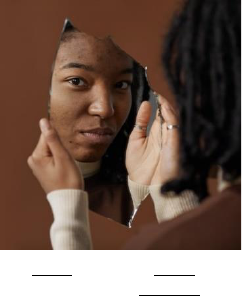
OUR LIVES: AN ETHNIC STUDIES PRIMER 24
dependence (mechanical solidarity or collective support) to interdependence (organic solidarity
or dissociation), they become isolated and alienated from one another until a redeveloped set
of shared norms arises. We see examples of this transition when there are changes in social
institutions such as employment, marriage, and religion. For example, transitions in
employment across America have shown a lack of jobs that pay a living wage; as a result, some
people become homeless or turn to criminal behavior to earn a living, both are forms of
anomie, as they move from social dependence to interdependence.
Social bonds are only formed through social acceptance and appreciation. How have people of
color garnered social acceptance even though their work and contributions have been
historically unappreciated, ignored, and rejected by American society? Is it possible to
strengthen social bonds and acceptance between people of color and White Americans when
human life in America is not equally valued? What happens to society if people continue to
perpetuate prejudice and discrimination based on racial-ethnic composition?
People develop an understanding about their culture, specifically
their role and place in society through social interactions. Charles
Horton Cooley (1902, 1964) suggested people develop self and
identity through interpersonal interactions such as perceptions,
expectations, and judgement of others. Cooley referred to this
practice as the looking glass self. We imagine how others observe us,
and we develop ourselves in response to their observations. The
concept develops over three phases of interactions. First, we imagine
another’s response to our behavior or appearance, then we envision
their judgment, and lastly, we have an emotional response to their
judgement influencing our self-image or identity (Griswold, 2013).
Interpersonal interactions play a significant role in helping us create social bonds and
understand our place in society.
The looking glass self reflects the accepted norms and roles for people to occupy within social
contexts. For people of color, the looking glass self establishes the self-consciousness of “two-
ness” or a dual identity, one accepted by the dominant group and its culture, and the other
embraced by their own native or indigenous culture (DuBois, 1903). It is through this social
development that people of color learn code-switching or double consciousness where they
anticipate accepted norms and roles based on the social setting and power dynamics of those
they will be interacting and change the way they speak, appear, behave, and express
themselves. Research shows code-switching generates hostility from in-group members for
“acting White,” depletes cognitive resources from performing or trying to avoid true culture,
and reduces authentic self-expression (McCluney et al., 2019).
What social image do you visualize when you think of yourself as an American? What social
image do people of color have to reference or emulate to develop social bonds with White
Americans? What racial-ethnic behaviors, appearances, and interactions are accepted in the
dominant culture? Which ones are rejected?
Image by ShotPot, Pexels is
licensed under CC BY 4.0

OUR LIVES: AN ETHNIC STUDIES PRIMER 25
BIOGRAPHICAL REFLECTION 2.1
WHEN DID YOU BECOME BLACK?
This picture makes me smile. I love my twin brother. Through the challenges of our
childhood, it was a blessing to have a twin. Our father is African-American and
Italian, and our mother is Mexican. As a result, our racial identity was ambiguous.
Many times, as children, my twin brother and I would be in public together and
people would comment on the disparity of our looks. As you can see by the photo,
my twin brother is very fair in comparison to me. People would comment, “He is
adorable with his curly hair and big eyes, and what happened to her?” To say I felt
ugly is an understatement. I hated being dark.
How could a four-year-old already feel this way? Four-year-old children are the
cutest and sweetest people walking the planet. I felt that way because I was constantly bombarded with the White
America standard of beauty. A standard that even the Hispanic community adopted- light skin, light eyes, and
blond hair, was beautiful.
As a child, I strictly identified with being Mexican as coached by my maternal grandfather and my mother. He
would say in a demanding tone, “You are NOT Black, you are Hispanic. Your skin is dark, but there are lots of dark
Mexicans, and your hair is not kinky, you have Mexican hair.” I would adopt this message as my own, and I would
not tell people that I was African-American until I developed a deep sense of who I really was.
I left California and went to Alabama A&M University (a Historical Black College) for a year. It was the biggest
culture shock of my life, in the most beautiful way. I loved the African American culture: the food, the music, the
soul, the faith, and the deep sense of community. The Southern African American culture was very different than
my limited experience with the African American community in California. Most of my professors were African-
American and my best friend, Bonita, had a sister who is a dentist. It was stunning to see progressive, educated,
faith filled, illustrious of people who embraced me as beautiful. According to their standard of beauty, I fit in. My
Spanish professor, Senor Goggins, was funny, smart, world traveled, and a kind man. He was not what I was
socialized to believe that African-Americans were, none of my newfound community was.
I found faith at this point in my life. The kind of faith that sees the beauty in all people. I learned how broken
people are and how what you see in others reveals so much about who you are.
When I came back to California, my mother could not stand that I had a new identity that included embracing
being an African American as well as a Latina. “When did you become Black?” she asked. It would take years
before I could answer this question in a way that she could understand.
Today, I identify with being an African-American, Latina. I have a deep love affair with culture of all kinds. My
family is a multi-racial family that embraces every aspect of who we are. We go to church on Sunday and make
tamales for the holidays and gumbo for the New Year. We listen to Los Tucanes de Tijuana and Aretha Franklin.
I was recently having lunch with a group of girlfriends that I’ve been friends with for over 35 years. We were
discussing what we love the most about each other. Then the question became, what physical characteristic do
you like about yourself the most? My answer… “My skin.”
This story “When Did You Become Black?” by Guadalupe Capozzi is licensed under CC BY NC ND 4.0
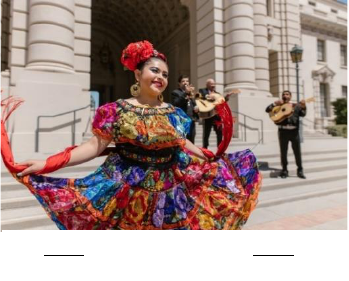
OUR LIVES: AN ETHNIC STUDIES PRIMER 26
Levels of Culture
There are three recognized levels of culture in society (Kottak & Kozaitis, 2012). Each level of
culture signifies particular cultural traits and patterns within groups. International culture is
one level referring to culture that transcends national boundaries. These cultural traits and
patterns spread through migration, colonization, and the expansion of multinational
organizations (Kottak & Kozaitis, 2012). Some illustrations are evident in the adoption and use
of technology and social media across continents. For example, computers and mobile devices
allow people to live and operate across national boundaries enabling them to create and
sustain an international culture around a common interest or purpose (e.g., Olympics, United
Nations, etc.).
In contrast, cultural traits and patterns shared within a country are national culture. National
culture is most easily recognizable in the form of symbols such as flags, logos, and colors as well
as sound including national anthems and musical styles. Think about American culture, which
values, beliefs, norms, and symbols are common only among people living in the United States?
How is national culture developed? Which social group has the status and power to create and
sustain U.S. culture? How does this group maintain its power and influence?
Subcultures, another level of culture, are subgroups of
people within the same country (e.g., doctors, lawyers,
teachers, athletes, African Americans, Asian Americans,
Latinx Americans, Native Americans, White Americans,
etc.). Subcultures have shared experiences and common
cultural distinctions, but they blend into the larger
society or cultural system. Subcultures have their own
set of symbols, meanings, and behavioral norms, which
develop by interacting with one another. Subcultures
develop their own idioculture or self-culture that has
significant meaning to members of the group and creates social boundaries for membership
and social acceptance (Griswold, 2013). Think about social cliques whether they be categorized
as jocks, nerds, hipsters, punks, or stoners. Each group has a particular subculture from the
artifacts they wear to the values and beliefs they exhibit. All groups form a subculture resulting
in group cohesion and shared consciousness among its members.
Groups and Organizations
The term group refers to any collection of at least two people who interact frequently and
share identity traits aligned with the group (Griffiths et al., 2015). Groups play different roles in
our lives. Primary groups are usually small groups characterized by face-to-face interaction,
intimacy, and a strong sense of commitment. Primary groups remain with us throughout our
lifetime (Henslin, 2011). Secondary groups are large and impersonal groups that form from
sharing a common interest.
Image by RODNAE Productions, Pexels is
licensed under CC BY 4.0

OUR LIVES: AN ETHNIC STUDIES PRIMER 27
Different types of groups influence our interactions, identity, and social status. George Herbert
Mead (1934) suggested specific expectations of influential people in a person’s life are
conceptualized as “significant” others, and common social expectations by being a member of a
group as termed “generalized” others. Mead’s theories explain that primary groups or
significant others develop specific expectations or roles for us to learn for social acceptance.
Whereas secondary groups define general expectations for acceptance. Someone who
identifies as African American may be expected to acknowledge and celebrate Kwanzaa
(primary group norm) and Christmas (secondary group norm).
Different types of groups influence our interactions, identity, and social status. Group dynamics
focus on how groups influence individuals and how individuals affect groups. The social
dynamics between individuals play a significant role in forming group solidarity. Social unity
reinforces a collective identity and shared thinking among group members thereby constructing
a common culture (Griswold, 2013). Commonalities of group membership are important for
mobilizing individual members. When people attempt to create social change or establish a
social movement group, solidarity helps facilitate motivation of individuals and framing of their
actions. The sense of belonging and trust among the group makes it easier for members to align
and recognize the problem, accept a possible solution, take certain actions that are congruent
and complementary to the collective identity of the group (Griswold, 2013). People accept the
group’s approach based on solidarity and cohesiveness that overall amplifies personal
mobilization and commitment to the group and its goals.
An organization refers to a group of people with a collective goal or purpose linked to
bureaucratic tendencies including a hierarchy of authority, clear division of labor, explicit rules,
and impersonal (Giddens et al., 2013). Organizations function within existing cultures and
produce their own. Formal organizations fall into three categories including normative,
coercive, and utilitarian (Etzioni, 1975). People join normative or voluntary organizations
APPLICATION 2.1
YOUR REGIONAL CULTURE
Goal
To connect socio-cultural identities with uniform characteristics of a geographic region.
Instructions
The place someone lives influences his or her value system and life. Describe the geographic location you live
and the culture of your community. What values and beliefs do the social norms and practices of your
neighborhood instill or project among residents? What type of artifacts or possessions (i.e., truck, luxury car,
recreational vehicle, fenced yard, swimming pool, etc.) do people living in your community seek out, dismiss, or
condone? Do you conform to the cultural standards where you live or deviate from them? Explain how the place
you live influences your personal and social perceptions, choices, and life.
Source
Kennedy, V. (2018). Beyond race: Cultural influences on human social life. West Hills College Lemoore.

OUR LIVES: AN ETHNIC STUDIES PRIMER 28
based on shared interests (e.g., club or cause). Coercive organizations are groups that people
are coerced or forced to join (e.g., addiction rehabilitation program or jail). People join
utilitarian organizations to obtain a specific material reward (e.g., private school or college).
When we work or live in organizations, there are multiple levels of interaction that effect social
unity and operations. On an individual level, people must learn and assimilate into the culture
of the organization. All organizations face the problem of motivating its members to work
together to achieve common goals (Griswold, 2013). Generally, in organizations small group
subcultures develop with their own meaning and practices to help facilitate and safeguard
members within the organizational structure. Group members will exercise force (peer pressure
and incentives), actively socialize (guide feelings and actions with normative controls), and
model behavior (exemplary actors and stories) to build cohesiveness (Griswold, 2013). Small
groups play an integral role in managing individual members to maintain the function of the
organization. Think about the school or college you attend. There are many subcultures within
any educational setting and each group establishes the norms and behaviors members must
follow for social acceptance. Can you identify at least two racial-ethnic subcultures on your
school campus and speculate how members of these groups are pressured to fit in to the
dominant culture?
On a group level, symbolic power matters in recruiting
members and sustaining the culture of a group within the
larger social culture (Hallet, 2003). Symbolic power is the
power of constructing reality to guide people in
understanding their place in the organizational hierarchy
(Bourdieu, 1991). This power occurs in everyday
interactions through unconscious cultural and social
domination. Like in society, the dominant group of an
organization influences the prevailing culture and
provides its function in communications forcing all groups
or subcultures to define themselves by their distance
from the dominant culture (Bourdieu, 1991). The
instrument of symbolic power is the instrument of domination in the organization by creating
the ideological systems of its goals, purpose, and operations. Symbolic power not only governs
the culture of the organization but also manages solidarity and division between groups. We
see examples of symbolic power in U.S. institutions (i.e., banks, schools, prisons, military, etc.),
and each has a hierarchy of authority where administrators serve as the dominate group and
are responsible for the prevailing culture. Each institution socializes members according to their
position within the organization to sustain the establishment and fulfill collective goals and
maintain functions.
There are external factors that influence organizational culture. The context and atmosphere of
a nation shapes an organization. When an organization’s culture aligns with national ideology,
they can receive special attention or privileges in the way of financial incentives or policy
changes (Griswold 2013). In contrast, organizations opposing national culture may face
suppression, marginalization, or be denied government and economic support. Organizations
Image by Kindel Media, Pexels is licensed under
CC BY 4.0

OUR LIVES: AN ETHNIC STUDIES PRIMER 29
must also operate across a multiplicity of cultures (Griswold, 2013). Culture differences
between organizations may affect their operations and achievement of goals. To be successful,
organizations must be able to operate in a variety of contexts and cultures. Griswold (2013)
suggested one way to work across cultural contexts is to maintain an overarching organizational
mission but be willing to adapt to insignificant or minor issues. Financial and banking
institutions use this approach. Depending on the region and demographic composition, banks
offer different cultural incentives for opening an account or obtaining a loan. In the state of
Michigan, affluent homeowners may acquire a low interest property improvement loan, while
low-income homeowners are restricted to grants for repairing, improving, or modernizing their
homes to remove health and safety hazards.
Working across organizational cultures also requires some dimension of trust. Organizational
leaders must model forms and symbols of trust between organizations, groups, and individuals
(Mizrachi et al., 2007). This means authority figures must draw on the organization’s internal
and external diversity of cultures to show its ability to adapt and work in a variety of cultural
and political settings and climates. Organizations often focus on internal allegiance forgetting
that shared meaning across the marketplace, sector, or industry is what moves understanding
of the overall system and each organization’s place in it (Griswold, 2013). The lack of cultural
coordination and understanding undermines many organizations and has significant
consequences for accomplishing their goals and ability to sustain themselves.
Doing Culture
All people are cultured. You have culture. Social
scientists argue all people have culture comprised of
values, beliefs, norms, expressive symbols or language,
practices, and artifacts. This viewpoint transcends the
humanities perspective that suggests someone must
project refined tastes, manners, and have a good
education as those exhibited by the elite class to have
culture. The perspective of social scientists reinforces
the ideology that culture is an integrated and patterned
system and not simply desired characteristics of the
ruling or dominant group.
Cultural patterns are a set of integrated traits transmitted by communication or social
interactions (Kottak and Kozaitis, 2012). Consider the cultural patterns associated with housing.
Each cultural group or society maintains a housing system comprised of particular cultural traits
including kitchen, sofa, bed, toilet, etc. The cultural traits or each individual cultural item is part
of the home or accepted cultural pattern for housing.
Not only do people share cultural traits, but they may also share personality traits. These traits
are actions, attitudes, and behaviors (e.g., honesty, loyalty, courage, etc.). Shared personality
traits develop through social interactions from core values within groups and societies (Kottak
Image by William Fortunato, Pexels is licensed
under CC BY 4.0

OUR LIVES: AN ETHNIC STUDIES PRIMER 30
and Kozaitis, 2012). Core values are formally (legally or recognized) and informally (unofficial)
emphasized to develop a shared meaning and social expectations. The use of positive (reward)
and negative (punishment) sanctions helps in controlling desired and undesired personality
traits. For example, if we want to instill courage, we might highlight people and moments
depicting bravery with verbal praise or accepting awards. To prevent cowardness, we could
show a deserter or run-away to depict weakness and social isolation.
Doing culture is not always an expression of ideal culture. People’s practices and behaviors do
not always abide or fit into the ideal ethos we intend or expect. The Christmas holiday is one
example where ideal culture does not match the real culture people live and convey. Christmas
traditionally represents an annual celebration of the birth of Jesus Christ; however, many
individuals and families do not worship Christ or attend church on Christmas day but instead
exchange gifts and eat meals together. The ideal or public definition of Christmas does not
match the real or individual practices people express on the holiday. Throughout history, there
have always been differences between what people value (ideal culture) and how they actually
live their lives (real culture) regardless of racial-ethnic background.
IDENTITY FORMATION & POLITICS
Trying to figure out who you are, what you value and believe, and why you think the way you
do is a lifelong process. In the first chapter of Thinking Well, Stewart E. Kelly (2000)
suggests, “we all have lenses through which we view reality, and we need to know what our
individual lens is composed of and how it influences our perception of reality.” Take a moment
to reflect and hypothetically paint a picture of yourself with words. Try to capture the core of
your being by describing who you are. Once you have formulated a description of yourself,
evaluate what you wrote. Does your description focus on your personal characteristics or your
socio-cultural characteristics you learned from other people in your life (i.e., family, friends,
congregation, teachers, community, etc.)?
Identity, like culture itself, is a social construct. The values, beliefs,
norms, expressive symbols, practices, and artifacts we hold develop
from the social relationships we experience throughout our lives.
Not only does personal identity make us aware of who we are, but it
also defines what we stand for in comparison to others. Identity is
relational between individuals, groups, and society meaning
through culture people are able to form social connections or
refrain from them. It is real to each of us with real social
consequences.
We develop our identity through the process of socialization and
enculturation. Socializing agents including family, peers, school,
work, and the media transmit traditions, customs, language, tools,
and common experiences and knowledge. The passage of knowledge and culture from one
generation to the next ensures sustainability of a particular way of life by instilling specific
Image by Andrea Piacquadio,
Pexels is licensed under CC BY 4.0
OUR LIVES: AN ETHNIC STUDIES PRIMER 31
traits, attitudes, and characteristics of a group or society that become part of each group
member’s identity.
Identity shapes our perceptions and the way we think about and categorize people. Our
individual and collective views influence our thinking. Regardless of personal, cultural, or
universal identity people naturally focus on traits, values, attitudes, and practices or behaviors
they identify with and dismiss those they do not.
Generations have collective identity or shared experiences based on the time period the group
lived. Consider the popular culture of the 1980s to today. In the 1980s, people used a landline
or fixed line phone rather than a cellular phone to communicate and went to a movie theater to
see a film rather than downloaded a video to a mobile device. Therefore, someone who spent
his or her youth and most of their adulthood without or with limited technology may not deem
it necessary to have or operate it in daily life. Whereas someone born in the 1990s or later will
only know life with technology and find it a necessary part of human existence.
Each generation develops a perspective and identifies from the time and events surrounding
their life. Generations experience life differently resulting from social and cultural shifts over
time. The difference in life experience alters perspectives towards values, beliefs, norms,
expressive symbols, practices, and artifacts. Political and social events often mark an era and
influence generations. The ideology of White supremacy reinforced by events of Nazi Germany
and World War II during the 1930s and 1940s instilled racist beliefs in society. Many adults
living at this time believed the essays of Arthur Gobineau (1853-1855) regarding the existence
of biological differences between racial groups (Biddis, 1970). It was not until the 1960s and
1970s when philosophers and critical theorists studied the underlying structures in cultural
products and used analytical concepts from linguistics, anthropology, psychology, and sociology
to interpret race discovering no biological or phenological variances between human groups
and finding race is a social construct (Black & Solomos, 2000). Scientists found cultural likeness
did not equate to biological likeness. Nonetheless, many adults living in the 1930s and 1940s
held racial beliefs of White supremacy throughout their lives because of the ideologies spread
and shared during their lifetime. Whereas modern science verifies the DNA of all people living
today is 99.9% alike and a new generation of people are learning that there is only one human
race despite the physical variations in size, shape, skin tone, and eye color (Smithsonian, 2018).
Intersectionality
As we explore the aspects of identity formation, it becomes evident that we are more than our
racial-ethnic composition. By examining the influence of culture on our lives, we can
understand how other identity labels or categories operate together in people’s lives and affect
our values, attitudes, norms, and practices. There are many elements of our identity that work
simultaneously and intersect that impact our understanding of ourselves and others as well as
influence our experiences, social interactions, and relationships.

OUR LIVES: AN ETHNIC STUDIES PRIMER 32
Race-ethnicity with class, gender and other identity labels or categories
of sexuality, religion, spirituality, national origin, immigration or refugee
status, ability, tribal citizenship, sovereignty, language, and age intersect
within a social context creating stratified social arrangements and
systems of power. The interconnected nature of social categories
overlap and have a cumulative effect on our lives. Your identity or social
location in a society can shape what you know, what others know about
you, how you are treated, and how you experience life (Anderson &
Collins, 2010). Social labels and categories we use to define identity such
as race, ethnicity, class, and gender matter because they are and
continue to be the basis for systems of power and inequality. As people
are stratified into social categories along identity lines, the persistent
reality of inequality is evident.
The dominant group has historically served as the gatekeeper to resources, opportunities, and
knowledge in the United States. Intersectionality exists within a matrix of domination or social
structure with multiple, interlocking levels of power and control that stem from race-ethnic
relations, gender, class and other social categories (Anderson & Collins, 2010). Those who
identify and are accepted as members of the dominant group have access and privileges
associated with their power and status, whereas others do not.
Examine each of the identity labels or social categories that intersect in our lives, are you able
to determine which label or identity-type is associated with dominance, power, and status? For
instance, explore gender identity. Describe the power and status of those who identify as male
in comparison to those who identify as female? Now, evaluate the identity label for those who
are non-binary. How is power and status different for non-binary people as compared to those
who identify as male or female? How is social dominance, power, and inequality apparent and
APPLICATION 2.2
THE PRIVILEGE & OPPRESSION OF INTERSECTIONALITY
Goal
To summarize the concept of intersectionality and articulate your own intersectional identities.
Instructions
Please take a moment to view Kimberlé Crenshaw's TED Talk, The Urgency of Intersectionality
(https://youtu.be/akOe5-UsQ2o). This video introduces the concept of intersectionality. As you watch the
video, think about the different ways your identities intersect and how this impacts your ability to reach your
educational and life goals. Once you have viewed and reflected on the video, answer the following questions:
1. What does intersectionality mean in simple words? What is an example of intersectionality?
2. How does social and cultural context influence our perceptions of identity?
3. How do your social identity labels or categories intersect and overlap? How do these labels or categories
empower and/or oppress your life experience?
4. Do you think about social identity, privilege, and oppression often? Why or why not?
Image by Jean-Baptiste
Burbaud, Pexels is licensed
under CC BY 4.0
OUR LIVES: AN ETHNIC STUDIES PRIMER 33
understood based on gender identity? How are life experiences different based on gender
identity? Now consider gender and race. How is dominance, power, and status understood and
how do gender and race labels intersect to influence life experience?
Globalization and Identity
With the advancements in technology and communications, people are experiencing greater
social forces in the construction of their cultural reality and identity. The boundaries of locality
have expanded to global and virtual contexts that create complexities in understanding the
creation, socialization, adaptation, and sustainability of culture.
Globalization is typically associated with the creation of world-spanning free markets and the
global reach of capitalist systems resulting from technological advances (Back et al., 2012).
However, globalization has the unintended consequences of connecting every person in the
world to each other. In this era, everyone’s life is connected to everyone else’s life in obvious
and hidden ways (Albrow, 1996).
Globalization lends itself to cultural homogenization that is the world becoming culturally
similar (Back et al., 2012). However, the cultural similarities we now share center on capitalist
enterprises including fashion and fast food. Social researchers also recognize patterns of
cultural heterogenization where aspects of our lives are becoming more complex and
differentiated resulting from globalization. Our social relationships and interactions have
become unconstrained by geography (Back, et al.). People are no longer restricted to spatial
locales and are able to interact beyond time and space with those sharing common culture,
language, or religion (Giddens, 1990; Kottak & Kozaitis, 2012). People can travel across the
globe within hours but also connect with others by phone or the Internet within seconds. These
advancements in technology and communications alter what people perceive as close and far
away (Back et al., 2012). Our social and cultural arrangements in an era of globalization are
adapting and changing the way we think and act.
Globalization also influences our identity and affinity groups. Technology allows us to eliminate
communication boundaries and interact with each other on a global scale. Today people are
able to form and live across national borders. Advances in transportation and communications
give people the opportunity to affiliate with multiple countries as transnationals. At different
times of their lives or different times of the year, people may live in two or more countries.
We are moving beyond local, state, and national identities to broader identities developing
from our global interactions forming transnational communities. A key cultural development
has been the construction of globality or thinking of the whole earth as one place (Beck, 2000).
Social events like Earth Day and the World Cup of soccer are examples of globality. People
associate and connect with each other in which they identify. Today people frame their thinking
about who they are within global lenses of reference (Back et al., 2012). Even in our global and
virtual interactions, people align themselves with the affinity groups relative to where they
think they belong and will find acceptance. Think about your global and virtual friends and peer
OUR LIVES: AN ETHNIC STUDIES PRIMER 34
groups. How did you meet or connect? Why do you continue to interact? What value do you
have in each other’s lives even though you do not have physical interaction?
With the world in flux from globalization and technological advances, people are developing
multiple identities apparent in their local and global linkages. Identity is becoming increasingly
contextual in the postmodern world where people transform and adapt depending on time and
place (Kottak & Kozaitis, 2012). Social and cultural changes now adapt in response to single
events or issues. The instant response and connections to others beyond time and place
immediately impacts our lives, and we have the technology to react quickly with our thoughts
and actions.
People can now live within global electronic cultural communities and reject cultural meta-
narratives (Griswold, 2013). Postmodern culture also blurs history by rearranging and
juxtaposing unconnected signs to produce new meanings. We find references to actual events
in fictional culture and fictional events in non-fictional culture (Barker & Jane, 2016). Many U.S.
television dramas refer to 9/11 in episodes focusing on terrorists or terrorist activities.
Additionally, U.S. social activities and fundraising events will highlight historical figures or icons.
The blurring of non-fiction and fiction creates a new narrative or historical reality people begin
to associate with and recognize as actual or fact.
Identity Today
All forms of media and technology influence identity including values, norms, language, and
behaviors by providing information about activities and events of social significance (Griffiths et
al., 2015). Media and technology socialize us to think and act within socio-cultural appropriate
norms and accepted practices. Watching and listening to people act and behave through media
and technology shows the influence this social institution has on things like family, peers,
school, and work on teaching social norms, values, and beliefs.
Technological innovations and advancements have influenced social interactions and
communication patterns in the twenty-first century creating new social constructions of reality.
These changes, particularly in information technology, have led to further segmentation of
society based on user-participant affinity groups including racial-ethnic groups (Kottak &
Kozaitis, 2012). The internet and web-based applications link people together transecting local,
state, and national boundaries centered on common interests. People who share interests,
ideas, values, beliefs, and practices are able to connect to one another through web-based and
virtual worlds. These shared interests create solidarity among user-participants while
disengaging them from others with differing or opposing interests meaning racial-ethnic groups
can easily develop cohesion among like members across borders and inflate antagonism for
others. Cybersocial interactions have reinforced affinity groups creating attitudes and
behaviors that strongly encourage tribalism or loyalty to the social group and indifference to
others.

OUR LIVES: AN ETHNIC STUDIES PRIMER 35
Even though there are so many media, news, and information outlets available online, they are
homogenous and tell the same stories using the same sources delivering the same message
(McManus, 1995). Regardless of the news or information outlets one accesses, the coverage of
events is predominantly the same with differences focusing on commentary, perspective, and
analysis. Shoemaker and Vos (2009) found this practice allows outlets to serve as gatekeepers
by shaping stories and messages into mass media-appropriate forms and reducing them to a
manageable amount for the audience. Fragmentation of stories and messages occurs solely on
ideology related to events rather than actual coverage of accounts, reports, or news.
People no longer form and take on identity solely from face-to-
face interactions; they also construct themselves from online
communication and cybersocial interactions. Approximately 73
percent of adults engage in some sort of online social networking
extending their cultural identity to virtual space and time (Pew
Research Center, 2011). Technological innovations and
advancements have even led some people to re-construct a new
online identity different from the one they have in face-to-face
contexts. Both identities and realities are real to the people who
construct and create them as they are the cultural creators of
their personas.
Technology like other resources in society creates inequality
among social groups (Griffiths et al., 2015). People with greater
access to resources have the ability to purchase and use online services and applications.
Privilege access to technological innovations and advancements depend on one’s age, family,
education, ethnicity, gender, profession, race, and social class (Kottak & Kozaitis, 2012). Signs
of technological stratification are visible in the increasing knowledge gap for those with less
access to information technology. People with exposure to technology gain further proficiency
that makes them more marketable and employable in modern society (Griffiths et al., 2015).
Inflation of the knowledge gap results from the lack of technological infrastructure among
races, classes, geographic areas creating a digital divide between those who have internet
access and those that do not.
CULTURAL CHANGE & ADAPTATION
People biologically and culturally adapt. Cultural change or evolution is influenced directly (e.g.,
intentionally), indirectly (e.g., inadvertently), or by force. These changes are a response to
fluctuations in the physical or social environment (Kottak and Kozaitis 2012). Social movements
often start in response to shifting circumstances such as an event or issue in an effort to evoke
cultural change. People will voluntarily join for collective action to either preserve or alter a
cultural base or foundation.
The fight over control of a cultural base has been the central conflict among many civil and
human rights movements. On a deeper level, many of these movements are about cultural
Image by Marcus Aurelius, Pexels is
licensed under CC BY 4.0
OUR LIVES: AN ETHNIC STUDIES PRIMER 36
rights and control over what will be the prevailing or dominant culture. For example, the cancel
culture or call-out movement aims to ostracize individuals out of social and professional circles
as a form of boycotting or shunning someone who has acted or spoken in an unacceptable
manner. Individuals ostracized call out the expression “cancel culture” or “cancelled” to protest
their free speech and censorship.
The “call-out” culture developed in 2014 as part of the #MeToo movement and gave victims of
sexual abuse and harassment the ability to publicly call out their abusers and be heard
particularly for sex crimes committed by powerful individuals. The Black Lives Matter
movement applied the same method to call-out police who killed Black men to highlight the
racism and discrimination against Black communities by law enforcement. The hashtag
“#cancel” was inspired by activist Suey Park when she called out the Twitter account of The
Colbert Report for a racist tweet about Asians. The use of the hashtag generated outrage and
debate, and the practice became widespread on Black Twitter to stop supporting a person or
work. By 2019 the phrase “cancel culture” became popular to recognize accountability for
offensive conduct. Recently, political conservatives in the United States have adopted the term
to deflect reactions or judgements for using politically incorrect speech.
Changes in culture are either adaptive (better suited for the environment) or maladaptive
(inadequate or inappropriate for the environment). During times of distress or disaster such as
the COVID-19 pandemic, people made cultural changes to daily norms and practices such as
wearing a mask and getting vaccinated for health, safety, and survival. The pandemic forced
adaptive cultural changes in medicine (vaccines), healthcare (emergency preparedness), and
online sectors and services (videoconferencing and education). However, not all cultural
changes were helpful or productive such as social distancing and the lockdowns during COVID.
These changes resulted in maladaptive behaviors and financial stress. Many people continue to
suffer mental health and substance issues as a result of social isolation during the pandemic
and the economy remains in recovery from government, business, and school closures during
peak waves of illness. People adjust and learn to cope with cultural changes whether adaptive
or maladaptive in an effort to soothe psychological or emotional needs.
Though technology continues to impact changes in society, culture does not always change at
the same pace. There is a lag in how rapidly cultural changes occur. Generally, material culture
changes before non-material culture. Contact between groups diffuses cultural change among
groups, and people are usually open to adapt or try new artifacts or material possessions
before modifying their values, beliefs, norms, expressive symbols (i.e., verbal and non-verbal
language), or practices. Influencing fashion is easier than altering people’s political or religious
beliefs.
OTHERING & BELONGING
Like racial formation, identity labels and categories are socially constructed by the dominant
group. Othering is the process of inventing labels and defining characteristics of people into
inferior group categories (Schwalbe et al., 2000). Symbolic language is directly and indirectly
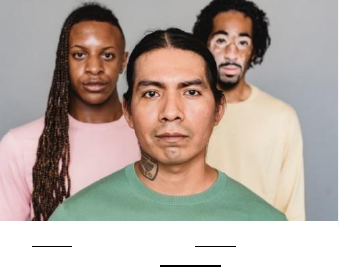
OUR LIVES: AN ETHNIC STUDIES PRIMER 37
used to label and categorize inferior group members who form their own collective identity of
belonging.
The dominant group defines the existence of inferior
groups by practicing othering in three forms. Oppressive
othering occurs when the dominant group seeks advantage
by defining a group as morally and/or intellectually inferior
(Schwalbe et al., 2000). Race classification schemes are an
example of oppressive othering by overtly or subtly
asserting racial difference of non-White as a deficit.
Implicit othering uses dramaturgical fronts of power where
White elites or would-be elites take on or portray powerful
self-images and implicitly create inferior others (Schwalbe
et al., 2000). Politicians and corporate executives often engage in implicit othering by shaping
their public personas and performances to show strength and masculinity. Defensive othering
is practiced by individuals seeking belonging into the dominant group or by those wanting to
deflect stigma experienced by the inferior or subordinate group (Schwalbe et al., 2000). This
type of othering involves accepting the devalued identity imposed by the dominant group
reproducing social inequality. When inferior group members seek safety or advantage by
othering those within their own group, the dominant group’s claim to superiority is reinforced
by their actions.
Cultural attributes within social networks build community, group loyalty, and personal and
social identity. People must learn to develop the social and cultural knowledge they need to
belong, garner support, and feel embraced by their community and society at large. A person’s
social status or composition dictates one’s admittance into a group or society to access cultural
knowledge, information, and skills.
Sociologists find cultural capital or the social assets of a person (including intellect, education,
speech pattern, mannerisms, and dress) promote social mobility (Harper-Scott & Samson,
2009). People who accumulate and display the cultural knowledge of a society or the dominant
group may earn social acceptance, status, and power. Bourdieau (1991) explained the
accumulation and transmission of culture is a social investment from socializing agents
including family, peers, and community. People learn culture and cultural characteristics and
traits from one another; however, social status effects whether people share, spread, or
communicate cultural knowledge to each other. A person’s social status in a group or society
influences their ability to access and develop cultural capital.
Cultural capital provides people access to cultural connections such as institutions, individuals,
materials, and economic resources (Kennedy, 2012). Status guides people in choosing who and
when culture or cultural capital is transferable. Bourdieu (1991) believed cultural inheritance
and personal biography attributes to individual success more than intelligence or talent. With
status comes access to social and cultural capital that generates access to privileges and power
among and between groups. Individuals with cultural capital deficits face social inequalities
Image by Armin Rimoldi, Pexels is licensed
under CC BY 4.0

OUR LIVES: AN ETHNIC STUDIES PRIMER 38
(Reay, 2004). If someone does not have the cultural knowledge and skills to maneuver the
social world they occupy, then they will not find acceptance within a group or society to access
support and resources.
BIOGRAPHICAL REFLECTION 2.2
ONE TIME THREE EQUALS ONE
Being a person of color in particular African-American, does carry a social imbalance on the ladder to success.
Educated in Middle-class, Catholic schools in the sixties and seventies for my entire first 12 years of school, I had to
learn through the years that being Black meant that I was to be seen by others in ways I was unaware of, ways that
signified that I was seen differently than my Caucasian counterparts. I really had no idea how true that came to be.
In 1968 I was a high school freshman at one of those aforementioned Parochial schools, and I received my first
lesson in ethnic studies from a most unlikely mentor. His name was Father Kieran Cunningham, a White immigrant
from Ireland. One day the two of us were out walking, and he told me of his last days in Ireland and his first
moments in the airport after landing in New York. Fr. Kieran mentioned the moment he saw the first Black person
in his life that first day in New York, and he related how he couldn’t keep from staring. I could only hope that the
person he was eyeballing was unaware of it for both his and Father Kieran’s benefit.
I honestly wasn’t sure where this conversation was going. Then Father Kieran turned to me and said a sentence
that has remained with me my entire life. “Daryl, to be a success in life you are going to have to work three times
harder than the average White person, do you understand that?”
“No, I don’t understand that at all,” I thought. As far as I was concerned, why would I have to work harder than the
next guy? But this very wise man was right, and time would prove him out. I have been successful professionally,
but at times my expectation bar was higher than others. As a former Air Force officer, I was told by a superior that,
in addition to showing leadership to all the 100-plus airmen assigned to me, I was to also show “Black leadership.”
“What was the difference between that and regular leadership?” I thought.
Later on, in my early years as an elementary educator, parents removed their children from my class roster the
first day of school when they found out I was Black, and told my principal to support their decision, in not very nice
words of reference to me. A student teacher requested to be removed from my supervision the minute she laid
eyes on me and realized I was not her race. She refused to be mentored by me. Some of my own students sent
racial slurs my way when I corrected them for misbehavior. It was of course unpleasant, but I also wondered why
pre-teen kids thought they had license to address their adult teacher in that manner. I was a bit naïve then, even I
will admit.
And yes, Fr. Kieran was right, there were certain challenges that, as an African American I experienced that let’s
face it—were due to the fact that I am African American. And it remains almost surreal to me that I first heard of
this inequity not from a fellow African American, but a wise, well-meaning white immigrant from Ireland.
I don’t know if I have had to work two, three, or four times harder than Caucasians to achieve the same goal, but I
will admit with some regret, that part of my success as a professional has been because I have been seen as a
“specially gifted African American,” and not simply a gifted man, period. And as long as one needs to stand out
from within an ethnic group, that individual will always begin from a starting point of deficit.
Do you think Fr. Kieran had a right to tell the writer what he told him? Did it help the writer, or maybe cause more
harm? Do you believe that minorities really have to work harder than whites, in the same situation? Have you felt
that you were seen as a “special” member of your demographic group, that deserved more than the “average”
member of your group?
This story “One Times Three Equals One” by Daryl Johnson is licensed under CC BY NC ND 4.0

OUR LIVES: AN ETHNIC STUDIES PRIMER 39
Obtaining social and cultural acceptance for people of color in the U.S. often results in mental
and emotional injury from living in a system of White supremacy where historically racists
ideas, norms, and practices have been passed down through generations. On a daily basis,
people of color face racial bias, microaggressions, ethnic discrimination, racism, and hate
crimes. This racial trauma or race-based traumatic stress (RBTS) lead to symptoms like those of
post-traumatic stress disorder (PTSD) such as depression, anger, reoccurring thoughts related
to a traumatic event, physical ailments, hypervigilance, low self-esteem, and psychological
distancing from traumatic events (Mental Health America, 2021).
Ellis Cose (1993) illuminated the experiences of successful African Americans in their struggle
with issues of racial fairness. His work documents the anger and pain associated with those who
pursued and obtained the American dream. Regardless of how similar backgrounds and
personal attributes align, Blacks and Whites live fundamentally different lives (Cose, 1993).
Middle-class Blacks have been labeled a model minority or law-abiding productive citizens, but
they have not garnered the same socio-economic respect and treatment as middle-class
Whites. For model minorities, success does not carry the same social meaning or equal the
same life experiences and opportunities as Whites.
APPLICATION 2.3
THE MEANING & IMPACT OF YOUR STORY
Goal
To access how identities inform our experiences, values, beliefs, attitudes, and behaviors to understand diversity
and make connections with others.
Instructions
The primary dimensions of identity including age, race, ethnicity, disability, gender, sexual identity, social class,
and religion serve as core elements and shape our self-image and perspective. They help form our core
expectations of others in our personal and professional life. The secondary dimensions of identify including
education, income, beliefs, relationship/parental status, geographic location, and work experience serve as
independent influences on our self-esteem and self-definition. This influence varies with who we are, our stage
of life, and changes we have experienced. These dimensions of identity affect the way we view and interact
with the world, but we rarely take time to carefully examine them. When we tell our own story, we have a
powerful sense of agency. Too often, however, the stories we hear about others are not individual stories, but
rather dominant stereotypes that subtly shape our ideas about groups of people. Novelist Chimamanda Adichie
tells the story of how she found her authentic cultural voice -- and warns that if we hear only a single
story about another person or country, we risk a critical misunderstanding. Please watch The Danger of a
Single Story by Chimamanda Ngozi Adichie (https://youtu.be/D9Ihs241zeg). As you watch this video think
about the ways you diminish some people to a single story. Think of five dimensions that highlight your
identity. Review the primary and secondary dimensions above for ideas.
1. Write a story about who you are that reflects the dimensions you identified.
2. Describe which identities are the least comfortable for you to share with others.
3. Discuss the identities you are most conscious or mindful about and explain why.
4. Analyze what your responses to items # 1 thru 3 mean to you.
5. Reflect and explain how the information you learned about in this exercise impacts you, your social
interactions, and relationships with others.

OUR LIVES: AN ETHNIC STUDIES PRIMER 40
African Americans continue to face the burdens of racial discrimination regardless of social
status and wealth. The most common issues experienced by people of color in achieving social
and economic success are the inability to fit in, lack of respect, low expectations, faint praise,
maintaining true racial-ethnic identity, self-censorship on sensitive race topics not to upset
Whites, collective guilt for lack of achievement of those within our own race, and exclusion
from the dominant or ruling class group (Cose, 1993). The experiences of being a model
minority show people of color must acculturate and develop cultural capital for social mobility
and success but still face discrepancies in earning recognition and achievement in comparison
to Whites.
There are four distinct ways inferior groups or people of color adapt to inequality. One way is
trading power for patronage or simply stated accepting it for recompense. This method gains
compensatory benefits from relationships with dominant group members by accepting their
demeaning and disempowering practices in exchange for approval, protection, compensation,
or autonomy from close supervision and control (Schwalbe et al., 2000).
People who share inferior status sometimes collaborate to create alternative subcultures
outside the fringes of mainstream or dominant culture including the urban drug trade.
Schwalbe et al. (2000) found alternative subcultures to be simultaneously subversive and
APPLICATION 2.4
PRIVILEGE & LIFE CHANCES
Goal
To analyze and evaluate the influence of socio-cultural identity and experiences on quality of life.
Instructions
1. Research You-Tube user-created videos on privilege and life chances such as the following:
• What is Privilege by BuzzFeedYellow (https://youtu.be/hD5f8GuNuGQ)
• Recognizing Privilege: Power to All People by Michael Yates (https://youtu.be/t2-RvClIZdE)
2. Complete the Test Your Life Chances exercise and answer the following questions
(https://drive.google.com/file/d/1pOTdOaqjy0LB9PkhwxIt0uBPIhBfzJYQ/view):
a. What barriers or issues are you able to identify with after completing the exercise?
b. What advantages or opportunities are you able to distinguish about yourself?
c. Were there any statements you found more difficult or easier to answer? Explain.
d. Were there any challenges or obstacles that you have faced that are missing in the exercise? Explain.
e. Were there any life privileges you have experienced that are missing in the exercise? If so, explain.
f. Did you answer untruthfully on any of the statements? If you are comfortable sharing, explain which
one(s)? Why did you not answer truthfully?
g. How do barriers and opportunities influence people's lives? What connections do you see among
success and identity (i.e., racial-ethnic, gender, class, disability, language, and sexuality)?
Source
Kennedy, V. (2018). Beyond race: Cultural influences on human social life. West Hills College Lemoore.

OUR LIVES: AN ETHNIC STUDIES PRIMER 41
reproductive of inequality by creating their own hierarchies, forms of power, and ways to earn
a living. A problem with seeking success outside of the mainstream is the conflict generated
with the dominant group making success economically, politically, and psychologically tenuous.
Some inferior group’s members adapt or survive inequality by hustling or exploiting the
vulnerable such as the jobless, elderly, uneducated, and addicted (Schwalbe et al., 2000). Other
people of color respond to inequality by dropping out of mainstream society such as the
homeless. Research shows inferior groups and people of color undergo a variety of strategies to
cope with the deprivations of othering, racial trauma, and inequality.
BIOGRAPHICAL REFLECTION 2.3
SINGLE MOTHER GETS A BAD RAP
The role of being a single mother has moments of pride. Pride in knowing that I worked hard in providing a loving,
safe, and faith filled environment for my children. It also has its moments of insecurities. Insecurities of being seen
as having a life that statistically suggests that I’m broke and unhappy.
Why would I feel so insecure about this subject? I am a strong, proud, Latin/African American woman that feels
confident in the roles that I embody. The uneasiness is directly related to the overwhelming feeling I get when
discussions about roles of women in communities of color come up. I read data that points to single motherhood
as the culprit for delinquency of children and ultimately their life of crime. Being a single mother of color often
comes with treatment that is less than respectful with a stigma that pins us as “contributing to the degradation of
society.”
I contribute to society. I have never been on welfare as an adult. I was not going to be a statistic, and I was going to
provide the best life possible for my children. I have been gainfully employed my entire adult life and sometimes
have worked two full time jobs. I am educated, pay taxes, care for my children, volunteer my time for my church,
and sit on the board of a local non-profit drug treatment program, while being a single mother. I didn’t choose the
life of being a single parent; somehow it feels like it chose me.
The insecurity of being a woman of color who is a single mom fueled me to lean in and make sure that my sons had
a parent that was visible. There were so many times that I was dealing with coaches that did not extend the same
respect and consideration to me and my child as they did to the athletes who had fathers present.
I think of the dichotomy in the way single fathers are embraced. They experience hero status when they announce
that they are single dads who have primary custody of children. When asked by other parents at sporting events or
performances, “You’re a single mom?” I answer, “Yes.” Then there is a drag that I feel in my chest as if though I’m
a victim in some way, and my life is incomplete.
The truth is my family and I have a beautiful life. Single motherhood is not the culprit.
This story “Single Mother Gets a Bad Rap” by Guadalupe Capozzi is licensed under CC BY NC ND 4.0
SUMMARY
In Module 2, we examined the influence of culture on collective and individual identity. We
learned how identity shapes our perceptions including the way we think about and label
people. You were asked to consider how your identity informs your experiences, values, beliefs,
attitudes, behaviors and connections to others. We also explored intersectionality as a source
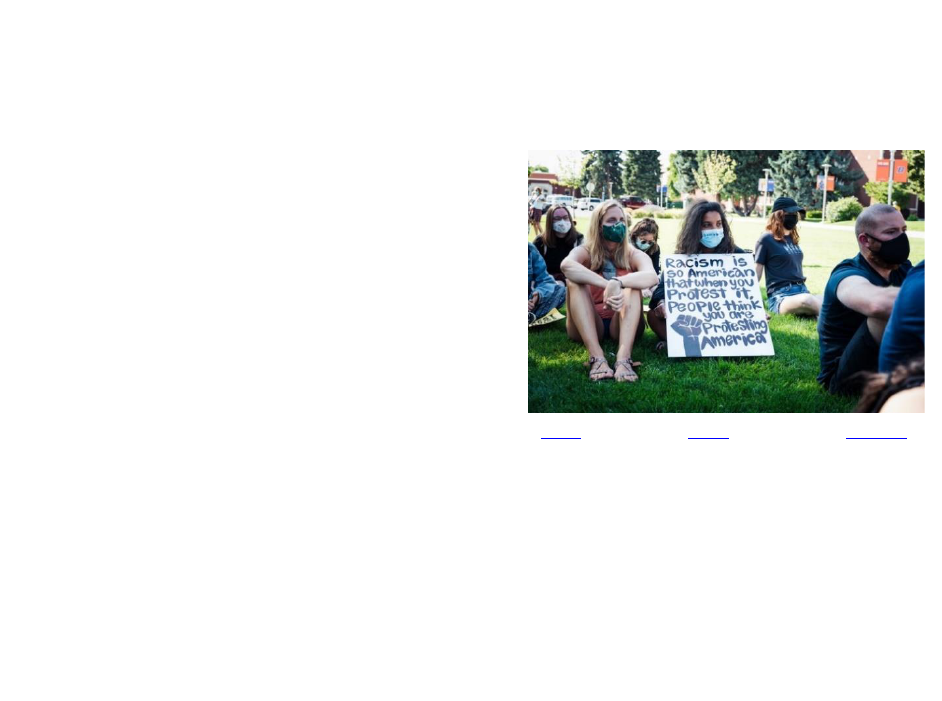
OUR LIVES: AN ETHNIC STUDIES PRIMER 42
for systems of power and inequality. And lastly, we considered the impact of othering on racial
trauma and the ongoing reproduction of inequality.
REVIEW QUESTIONS
1. Discuss how culture and identify shape people’s
observations and assessments about others.
2. Describe the ways intersectionality of race and
other forms of identity persuade people’s
perceptions, status, and access to resources in
society.
3. Explain the influence of technology on collective
and individual identity.
4. Analyze the impact of social labels and
categories on identity, racial trauma, othering,
and inequality.
5. Why might people of color keep certain aspects of their identity private? What aspects of
your identity do you hide or change to fit in or be accepted by others?
TO MY FUTURE SELF
From the module, what information and new knowledge did I find interesting or useful? How
do I plan to use this information and new knowledge in my personal and professional
development and improvement?
REFERENCES
Albrow, M. (1996). The global age. Polity Press.
Back, L., Bennett, A., Edles, L. D., Gibson, M., Inglis, D., Joacobs, R., & Ian Woodward. (2012).
Cultural sociology: An introduction. Wiley-Blackwell.
Barker, C. and Jane, E. A. (2016). Cultural studies: Theory and practice. (5
th
ed.). Sage
Publications Ltd.
Beck, U. (2000). What is globalization? Polity Press.
Biddiss, M. D. (1970). Father of racist ideology: Social and political thought of Count Gobineau.
Weybright and Talley, Inc.
Black, L. and Solomos, J. (2000). Theories of race and racism: A reader. Routledge.
Bourdieu, P. (1991). Language and symbolic power. Polity Press.
Image by Brett Sayles, Pexels is licensed under CC BY 4.0

OUR LIVES: AN ETHNIC STUDIES PRIMER 43
Childs, E. C. (2005). Navigating interracial borders: Black-White couples and their social worlds.
Rutgers University Press.
Cooley, C. H. (1902, 1964). Human nature and the social order. Schocken.
Cose, E. (1993). The rage of a privileged class. HarperCollins Publishers.
DuBois, W.E.B. (1903). The soul of Black folk. Dover Publications.
Durkheim, E. (1893, 1960). The division of labor in society (G. Simpson, Trans.). Free Press.
Etzioni, A. (1975). A comparative analysis of complex organizations: On power, involvement,
and their correlates. Free Press.
Giddens, A., Duneier, M., Applebaum, R. P., & Carr, D. (2013). Essentials of sociology. (4
th
ed.).
W.W. Norton & Company, Inc.
Griffiths, H., Keirns, N., Strayer, E., Cody-Rydzewsk, S., Scaramuzzo, G., Sadler, T., Vyain, S., Byer,
J., and Jones, F. (2015). Introduction to sociology 2e. OpenStax College.
Griswold, W. (2013). Cultures and societies in a changing world. (4
th
ed.). Sage Publications, Inc.
Hallet, T. (2003). Symbolic power and organizational culture. Sociological Theory, 21, 128-149.
Harper-Scott, J. P. E. & Samson, J. (2009). An introduction to music studies. Cambridge
University Press.
Henslin, J. M. (2011). Essentials of sociology: A down-to-earth approach. (11
th
ed.). Pearson.
Kennedy, V. (2012). “The Influence of Cultural Capital on Hispanic Student College Graduation
Rates.” EDD dissertation, College of Education, Argosy University.
Kennedy, V. (2018). Beyond race: Cultural influences on human social life. West Hills College
Lemoore.
Kottak, C. P. & Kozaitis, K. A. (2012). On being different: Diversity and multiculturalism in the
north American mainstream. (4
th
ed.). McGraw-Hill Companies, Inc.
McCluney, C. L., Robotham, K., Lee, S., Smith, R. & Durkee, M. (2019). The Costs of Code-
Switching. Harvard Business Review. https://hbr.org/2019/11/the-costs-of-
codeswitching
McManus, J. (1995). A market-based model of news production. Communication Theory, 5, 301-
338.

OUR LIVES: AN ETHNIC STUDIES PRIMER 44
Mead, G. H. (1934). Mind, self and society. University of Chicago Press.
Mizrachi, N., Drori, I. & Anspach, R. R. (2007). Repertoires of trust: The practice of trust in a
multinational organization amid political conflict. American Sociological Review, 72, 143-
165.
The National Academies Press. (1992). Democratization in Africa: African Views, African Voices.
The National Academy of Sciences. https://www.nap.edu/read/2041/chapter/4
Pew Research Center. (2011). Demographics of Internet Users. Pew Internet and American Life
Project. http://www.pewinternet.org/Trend-Data/Whos-Online.aspx
Reay, D. (2004). Education and cultural capital: The implications of changing trends in education
policies. Cultural Trends, 13(2), 73-86.
Schwalbe, M., Godwin, S., Holden, D., Schrock, D., Thompson, S. & Wolkomir, M. (2000).
Generic processes in the reproduction of inequality: An interactionist analysis. Social
Forces, 79(2), 419-452.
Shoemaker, P. & and Vos, T. (2009). Media gatekeeping. In D. Stacks & M. Salwen (Eds.), An
integrated approach to communication theory and research (pp. 75–89). Routledge.
Smithsonian Natural Museum of History. (2018). What Does It Mean to Be Human? Smithsonian
Institution. http://humanorigins.si.edu/evidence/genetics/one-species-living-worldwide
OUR LIVES: AN ETHNIC STUDIES PRIMER 45
MODULE 3. OUR STORY: NATIVE AMERICANS
LEARNING OBJECTIVES
At the end of the module, students will be able to:
1. summarize the development of indigenous peoples across the Americas during pre-colonial
times
2. explain the process of European contact and colonization in North America
3. explore the process of American westward expansion
4. understand the political and legal processes that Americans utilized to control and
subjugate Native Americans
5. describe aspects of the American Indian Movement of the 1960s
6. explore the issues of the late 20
th
and early 21
st
century and how they have impacted Native
Americans
KEY TERMS & CONCEPTS
American Indian Movement
American Indian Religious Freedom Act
Americanization
Bering Strait
Blood Quantum
Cahokia
California v. Cabaz
Christopher Columbus
Dakota (Sioux) Uprising of 1862
Dawes Act of 1887
Doctrine of Discovery
Eurocentrism
Indian Citizenship Act of 1924
Indian Education Act of 1972
Indian Relocation Act
Indian Removal Act of 1830
Indian Reorganization Act (IRA) of 1934
King Phillip’s War
Long Walk
Manifest Destiny
Meriam Report
Occupation of Alcatraz
Proclamation Line of 1763
Pan-Indian
Pequot Massacre
Reconquista
Red Power movement
Sand Creek Massacre
Seven Years’ War
Trail of Tears
Worcester v. Georgia
INTRODUCTION
Native Americans are unique to the American story, for they were indigenous to these lands
before they were even named the Americas. Once the “New World” was discovered,
indigenous peoples had to grapple with foreigners colonizing their land. The Native Americans
functioned in two different modes over the course of American history: by resistance to power
and attempts to work within the framework of the U.S. government.
This is their story.
OUR LIVES: AN ETHNIC STUDIES PRIMER 46
INDIGENOUS PEOPLES OF THE AMERICAS
The peoples of the Americas arrived approximately 12,000 years ago, during the Paleolithic
Age. A “small” ice age left the Bering Strait frosted over, which allowed for people to cross from
the continent of Asia into modern day Alaska. Over many decades, small groups of nomadic
peoples traveled long distances and spread throughout the Americas, some migrating all the
way to South America.
As the decades passed, the nomadic peoples settled all throughout the lands, and began
farming and sedentary living approximately 8,000 - 9,000 years ago. From there, they
developed into vastly different tribal groups, some creating massive civilizations that were fairly
advanced for their times. These civilizations include that of Cahokia rooted along the
Mississippi river, who in the height of their power had a population of up to 30,000 and trade
networks that reached modern day Mexico.
For many decades, up until the arrival of Europeans, Native Americans lived in North America in
relative peace and harmony. Each tribe developed a unique society based on their surrounding
terrain and climate as well as familial alliances. Conflict between tribes was typically based on
border disputes, but rarely large-scale political warfare.
CONTACT AND CONFLICT WITH THE “OLD WORLD”
For centuries, Native Americans lived, cultivated, and developed the lands in the Americas. The
lands would not see significant changes until European contact in the late 15
th
century. Most
readers would attribute the first European to come in contact with indigenous peoples to be
renowned explorer Christopher Columbus. This is generally true, even though Norse explorer
Leif Eriksson landed in Newfoundland in the 12
th
century.
Columbus was one of many skilled explorers of the 15
th
century dared to venture out into open
ocean, first making their way down the African coast, then planning to sail out further into the
Atlantic. Columbus, although an Italian in origin, gained a commission from the Spanish
monarchy to explore and colonize new lands. The Spanish were highly motivated by the
Reconquista, the campaign to “reconquer” Spain from the Muslims that had occupied their
native lands for decades. In 1492, they accomplished their Reconquista and were eager for
more victories. Due to Ottoman expansion, historic routes to the east were no longer viable,
and Europeans were looking for another access point to eastern spices and other exotic goods.
Columbus was hired by the Spanish monarchs to find a new trade route to Asia in order to
access highly coveted commodities.
When the Spanish made landfall in the Americas, not Asia as they planned, they sought to
explore the Americas, searching for gold and other lucrative natural resources. Upon discovery,
the indigenous peoples were dubbed “Indians,” for Columbus and his shipmates believed that
they landed in the East Indies. The Spanish utilized the papal principle of the Doctrine of
OUR LIVES: AN ETHNIC STUDIES PRIMER 47
Discovery which sanctioned the colonization of the Americas and declared indigenous peoples’
non-Christian enemies that deserved the brutal conquest of their lands.
In Columbus’s journal, he recorded his observations of the indigenous people. He stated:
It appeared to me to be a race of people very poor in everything…
They should be good servants and intelligent, for I observed that they quickly took in
what was said to them, and I believe that they would easily be made Christians, as it
appeared to me that they had no religion.... (Columbus, 1492)
Columbus shows an obvious superiority to the people he encountered by calling them poor,
assuming they were without religion since they were not Christian, and declaring them to be of
service to others like him. He shows intent to abuse and enslave, and this is the sentiment that
many other Europeans would take as they began to colonize the Americas. From here on
forward, Europeans set a precedence of Eurocentrism, the interpretation of non-European
world civilizations in comparison to European culture. In these cases, European men like
Columbus viewed the indigenous peoples as different and inferior, thus justifying abusive and
malicious behavior. Spanish Conquistadors continued to explore in the Caribbean, Central, and
South America, trading, warring, and colonizing regions. It was the Spanish who set the
precedent to establish colonies in the New World for the sole purpose of monetary benefit to
its mother country. Eventually they established very lucrative settlements with systems that
forced indigenous peoples and imported African slaves to work against their will. Soon other
Europeans ventured into the New World with the hopes of establishing their own profitable
settlements.
ENGLISH COLONIAL PERIOD
English explorers intended to take the same routes into the west as the Spanish but were most
successful in the settlement of North America. Two primary colonies were established in what
is now the American east coast – the colonies of New England, now mainly Massachusetts, and
Virginia. In each of these regions, English settlers also encountered indigenous peoples;
however, the English approach was initially different than the Spanish. The English sought to
forge alliances with Natives, learn the territory, and convert the Natives to Christianity.
Eventually, the desire for expanding territories, along with the general beliefs of White
superiority, would break down attempts of coexisting.
However, we must not assume that indigenous peoples had no agency or free will. As the
English began to populate North America to form colonies that would become America itself,
they encountered Natives that saw opportunities for trade with the light skinned newcomers
(Lepore, 1998). Evidence shows that the weapons Europeans welded were coveted by some
tribes to give them power over tribal disputes. Native Americans also traded with the English
for glass beads that they considered valuable, but the English viewed as meaningless. These
trinkets circulated amongst the tribes as currency.

OUR LIVES: AN ETHNIC STUDIES PRIMER 48
As the English flooded into the eastern seaboard of North America, they quickly became the
dominant colonial power. Settlement was difficult and intermittent conflict with Native
Americans kept the English close to their fortified settlements. At times, Native Americans
worked with colonists as exemplified in the story of Squanto, who was said to have been
present during the first Thanksgiving feast. Squanto was a man who had already had some
exposure to the English and could communicate with the colonists. This brief period of harmony
would be short lived in the New World.
When the English came and settled, the fundamental
changes to the land and its people were significant.
First, the impact of disease has to be considered. Native
Americans had no immunities to diseases that the
Europeans brought with them, and their communities
were tragically impacted. These diseases included
smallpox, influenza, and plagues that decimated Native
populations. Next, there was a culture clash that caused
many problems. The English brought herding animals
like cattle and sheep that were not native to the
Americas and needed land to graze. These wandering
animals often disrupted Native life and the forest
ecosystems. Trees were also felled to create space for planting crops, sustenance for the influx
of colonists in the lands. Over time, the settlers would need more and more land to spread out,
and territorial lines would be both fought over and ignored. In certain areas, finite resources
and trade disputes occurred, resulting in a need for revenge and retaliation.
One of the more significant was the Pequot Massacre, which occurred in May of 1637.
Exhibiting the land lust of the colonists, a militia of soldiers from New England stormed into the
region they referred to as Mystic and attacked the Pequots. The village was set on fire, and any
Pequots attempting to escape were shot. Survivors were sold into slavery, and the whole affair
was justified by the will of God, as the colonists were Christians. This was viewed as a triumph
for the English, and more land was used to settle upon.
Tensions continued to mount in the New England region until all-out war broke out. The body
of an Englishman named John Sassamon was found and suspicion turned quickly to the
Wampanoags, the prominent tribe in the area. The Native American’s men suspected of the
murder were put to trial, found guilty of the crime, and executed. The Wampanoags retaliated
and killed nine English colonists. This violence would escalate into a violent and bloody conflict
called King Phillip’s War. The Native American leader Metacom, known to the English as King
Philip, led a coalition of Natives in the attack of several Puritan townships. Metacom had
previously maintained a modicum of peace, and even small conflicts were negotiated by both
parties. The execution of the three Natives proved a step too far and showed that the colonists
were overstepping their boundaries. The colonists, however, viewed the Native Americans as
godless savages and an impediment to English success and growth in the new world. It was
widely believed that natives were inferior to Europeans and were not using the land to its full
"Wampanoag" by Wikimedia is in the Public
Domain, CC0
OUR LIVES: AN ETHNIC STUDIES PRIMER 49
potential. With these ideas in mind, war was easy and simple. War waged for months as the
English attempted to chase Metacom and their supporters in lands they did not know well.
Finally, the sachem Metacom was captured and put to death. The war was over, and the English
remained dominant.
One weakness in the eyes of the English was the fact that the Native Americans seemed
fractured and easily manipulated. This was due to the numerous tribes that existed in North
America, each with varied culture, loyalty, and territory. Although the natives might have
appeared the same to the English, they were not united. These tribal differences were often
exploited by the colonists, and their loyalties were traded and bought by the different groups in
colonial times. This is best exemplified during the French and Indian War, sometimes also called
the Seven Years’ War. In the colonies, this conflict was fought between the French and the
English, each with their own Native American allies. One of the boons of this war was the area
known as the “middle ground” or the Ohio River Valley territory. Again, we can observe another
instance of colonists wanting to spread and continue to settle westward. The end of the war
resulted in victory for the English; however, Parliament also passed the Proclamation Line of
1763, an act that prevented the colonists from settling past the territorial line along the
Appalachian Mountains and the far eastern boarders of the English colonies. Essentially, the
English colonists did not gain control of the Ohio Valley as they hoped. Despite the boundary
set by Parliament, many colonists ignored the law. Violations were common, and even General
George Washington himself crossed this territorial divide.
Throughout the colonial period into the formation of the United States, Native Americans saw
their lands taken over by English settlers. Once the revolution ended and the Americans
achieved freedom from the British, the Americans looked to the west to expand their
territories. Some attempts of pan-Indian alliances were forged to fight against the American
aggressors. The term Pan-Indian refers to a coalition of Natives from different tribes working in
unity against a common enemy. These attempts were led by Native Americans such as
Tecumseh during the War of 1812, who sought to use force to defend and take back their lands.
Tecumseh asserted that their land once “belonged to red men” and had “since made miserable
by the White people” (Tecumseh, 1810). Although Native Americans were treated as sovereign
nations when signing treaties, the respect for Natives was often ignored when they were
regarded as inferior and unable to maintain control of their lands. The American government
repeatedly reneged on treaties, and new states formed as populations expanded. When U.S.
citizenship was established, Native Americans were not extended the rights of other White
Americans, not for more than 100 years later.
WESTWARD EXPANSION
Most of the 19
th
century was a time of great turmoil and despair for Native Americans. The U.S.
government approached relations with Natives in two different ways, first removal and
relocation; then land redistribution and assimilation.

OUR LIVES: AN ETHNIC STUDIES PRIMER 50
Between the 1820s up through the 1880s, Native
Americans were continually uprooted and relocated to
reservation lands. These actions were legitimized by
the passage of the Indian Removal Act of 1830, under
President Andrew Jackson. This act passed with
President Jackson’s approval and was later carried out
under his predecessor Martin Van Buren. President
Jackson claimed that Native Americans were
“uncontrolled possessors” of their lands, and therefore
would only be allowed to occupy lands that were given
to them by their conquerors (Jackson, 1829; Richter,
2001). The act allowed for the removal of five different
tribes from their ancestral lands to relocate to
reservation territory in modern day Oklahoma. The
former lands would later be settled by White Americans.
In a shift of tactics, instead of using force to combat the removal process, one of the five tribes,
the Cherokee, sought to work within the U.S. legal system to sue for their rights to their land.
This was an uphill battle, especially after Georgians discovered gold in Cherokee territory in
1829, making their territory highly coveted. After tumultuous court battles, in Worcester v.
Georgia, the Supreme Court upheld Cherokee rights to their lands. Unfortunately, even this
court ruling was not enough to protect the tribes, and over the course of several years, the five
tribes: Chicksaw, Choctaw, Seminole, Creek, and the Cherokee were forced from their
homelands to a territory west of the Mississippi River. The removal process took several years
and was later named the Trail of Tears. The reason for the name was because the relocated
Natives took the forced journey on foot, many of them dying of exposure, disease, and
starvation. Men, women, children, the elderly, the infirm – they were all forced to walk with
their possessions, no wagons, no horses, tents, or provisions. One in three died on the journey,
and they barely made it to their destination.
APPLICATION 3.1
SHIFTING PERSPECTIVE: CHEROKEE INDIANS
Goal
To understand the experiences of the Cherokee Indians in protesting Indian Removal policies.
Instructions
Read the Cherokee Petition Protesting Removal, 1836 (http://www.americanyawp.com/reader/manifest-
destiny/cherokee-petition-protesting-removal-1836/). Answer the following questions:
1. What reasons does the speaker use to protest removal?
2. What kinds of language does the speaker use to describe U.S. policies?
"Five Civilized Tribes
Portraits" by Wikimedia is in the Public
Domain, CC0

OUR LIVES: AN ETHNIC STUDIES PRIMER 51
The interactions between the Americans and Native Americans during the 19
th
century were
justified by a concept that was coined into words by John O’Sullivan in the 1840s – Manifest
Destiny. O’Sullivan successfully illustrated a concept that was already ingrained in the minds
Americans since the initial settlement of this country. Manifest destiny was the belief that
Americans had a destiny, a calling that could not be changed. That destiny was to inhabit the
lands of North America from the Atlantic coast to the Pacific coast. Additionally, O’Sullivan was
clear that this “destiny” was dictated by God, underpinning this concept with the most
prevalent religion in America of the time, Protestant Christianity. By giving this concept a name,
O’Sullivan gave Americans a justification to continue to settle and occupy all the lands in North
America, continually pushing westward no matter what was in their way because it was their
destiny. What he really conceptualized were the beliefs and desires of even the earliest
colonists, who had journeyed west across the Atlantic Ocean so long before him. In this era,
Manifest Destiny was not merely about colonial settlement, but American domination of land,
resources, and societal order.
This maltreatment continued amidst the American civil war. Even as the country was torn by
armed conflict, American citizens kept a steady pace on their quest for westward expansion. In
what is Minnesota today, the Dakota tribes fought for their rights to remain in control of their
lands in a conflict called the Dakota (Sioux) Uprising of 1862. Because of the severe depletion
of buffalo herds, which was the tribe’s main food source, the Dakota tribes resorted to farming,
which was not working out well. The tribes were then forced to resort to asking the state
government for aid, or buying food on credit, or else their people would starve. Local
authorities refused to comply and tensions rose. A group of Dakota men killed five White
settlers, and violence continued to escalate into war with the Dakotas. By the time local militias
ended the violence, hundreds of Dakotas were taken prisoners and held accountable in courts
of local authorities where murder, rape, and atrocities took place. Officially, 303 Dakota tribal
members were sentenced to be hanged, until President Lincoln stepped in and commuted most
of the sentences to 38 individuals. This was the largest mass execution by hanging in U.S.
history. The remaining members of the local Dakota tribes were chased into the hills, hunted,
killed, and starved out.
After the events of the Dakota Uprising, more and
more violent incursions occurred. In 1864, the
Arapahoe and Cheyenne tribes attempted to protect
their lands in Colorado. However, when gold was
discovered on their lands, Americans sought to gain
access. The tribes sought peace negotiations, but
Colorado militiamen forged a different path. In a
violent attack called the Sand Creek Massacre, a
White militia openly attacked the tribes at Sand
Creek, killing over 200, forcing those survivors onto
reservations. In 1886, former Union soldiers forced
the Navajo into a similar trek as the Five Civilized
Tribes in the Long Walk, wherein thousands perished
"Portrait of Black Kettle or Moke-Tao-To &
Delegation of Cheyenne & Arapaho Chiefs 28 SEP
1864" by Wikimedia is in the Public Domain, CC0
OUR LIVES: AN ETHNIC STUDIES PRIMER 52
on their way to reservation lands from their New Mexico homelands. Any tribal members that
resisted were shot.
Driven by a so-called campaign of peace, President Ulysses Grant attempted a different
approach, closing this era of removal and relocation. In a post-war effort, Grant instituted a
‘Peace Plan’ to “conquer through kindness.” This plan was called the Dawes General Allotment
Act or the Dawes Act of 1887. The goal falsely presented as a plan to redistribute and protect
land rights but turned out to be another process of denial of land rights. The Dawes Act revoked
collective land ownership from the tribes and redistributed the land in smaller plots to
individuals within the tribes. Tribal members would be given the deed to those plots of land
after they had lived on that land for 25 years. Only after the 25 years of probation would the
individuals receive the land titles, and some would even be granted citizenship.
This legislation had multiple issues. First, it denied the traditional communal land use that
generally, Native Americans had practiced. Customarily, no individual owned land, but they
utilized it as a collective unit. Second, it assumed that tribes were not capable of holding a land
deed. This part of the act was intended to defend Natives from criminal land prospectors or
sneaky investors, but it also assumed that tribal members were too inexperienced and
unintelligent to recognize unfair deals. Next, much land was taken during the allotment era,
never released by the government to Native Americans. Lastly the law withheld land titles for
the span of a generation on purpose, to award the lands to the next generation of children that
had most likely gone through Indian boarding schools meant to Americanize or assimilate
Native American children into American culture. The last point leads to the next issue at hand –
education.
Native American education in the U.S. during the 19
th
century was similar to other marginalized
groups such as immigrant communities. For Native Americans, the outcome was much more
detrimental to the culture. Education for these groups was tailored towards one goal –
assimilation into American culture, also known as Americanization. This is the process of
deemphasizing the original culture of a group and indoctrinating students to what was
generally acceptable American culture. For example, language was a prevailing tactic to shift
children towards American culture by forcing children to speak English rather than their Native
language. For children of immigrants, this was problematic but practical, for they could remain
bilingual, speaking one language at school and another at home. For Native Americans, this was
cultural erasure, for the elder tribal members were continually being eradicated through
warfare and the children were being forced to forget their native language. Through the
Americanization process, the loss of Native American culture and custom was paramount.
There was no home country where their languages and customs still existed because they were
still in it. Their culture was just simply being erased.
The 19
th
century was extremely damaging to Native Americans – due to the breaking of
treaties, erasure of culture, and outright genocide. The future of Native Americans was
uncertain, and the next century would prove to be just as tumultuous.

OUR LIVES: AN ETHNIC STUDIES PRIMER 53
THE 20
TH
CENTURY
In the next phase of Native American history, the government took yet another approach to
relations with Native Americans. This shift was likely a response to Native participation during
World War I (Treuer, 2019). First came the Indian Citizenship Act of 1924 which officially
recognized Native Americans as citizens, even though legally, under the 14
th
amendment,
Natives already had birthright citizenship. Next was the Meriam Report, a comprehensive
evaluation of Native reservation conditions, hospitals, schools, and other agencies. The push for
the report came from Native American advocates that identified the failures of Native American
policies and possibilities for progress. Men such as Peter Graves and John Collier called out the
policy issues of the Dawes Act as well as the denial of religious freedoms that Natives endured.
Progress during the 1930s was difficult, especially during the economic crisis of the Great
Depression. Nevertheless, Collier was able to negotiate the Indian Reorganization Act (IRA) of
1934, sometimes also called the Indian New Deal, because it was passed under President
Roosevelt and his New Deal agenda. This act allowed for Native American lands to remain in
their control and distributed amongst tribal members as well as the ability to self-govern.
Although this was a step towards granting of freedoms, the IRA was problematic within Indian
reservations for ambiguities.
Along with the IRA came the reintroduction of a colonial practice called blood quantum. This
was known as the process of determining the fraction of Indian blood or ancestry. For instance,
if one of your grandparents was full blood Choctaw, that made you ¼ Choctaw. This practice
was reintroduced to verify access to tribal land ownership under the IRA. Blood quantum is still
used today to determine tribal membership, although the requirements vary depending on the
tribe.
Then, in 1956, the government took a different tactic in the implementation of the Indian
Relocation Act. This legislation was passed to encourage young American Indians to leave
reservations for urban areas to further the assimilation into American society. Financial
assistance, vocational training, and other support was guaranteed for those that took up the
opportunity. The result was often disastrous because the support that was guaranteed under
this legislation was not consistently fulfilled. Many suffered from culture shock, homelessness,
and poverty due to the failures of the policy.
While the IRA improved the lives of Native Americans to
some degree, Native Americans still endured racial
discrimination and hardships due to decades of
mistreatment in America. The civil rights movements of
the 1960s inspired many groups to push for equality and
among those rose the Red Power movement. The
movement was led by mostly young American Indians that
sought policies to bring aid to Native American
communities, maintain and protect land ownership, and
"Flag of the American Indian Movement
V2" by Wikimedia is in the Public Domain, CC0
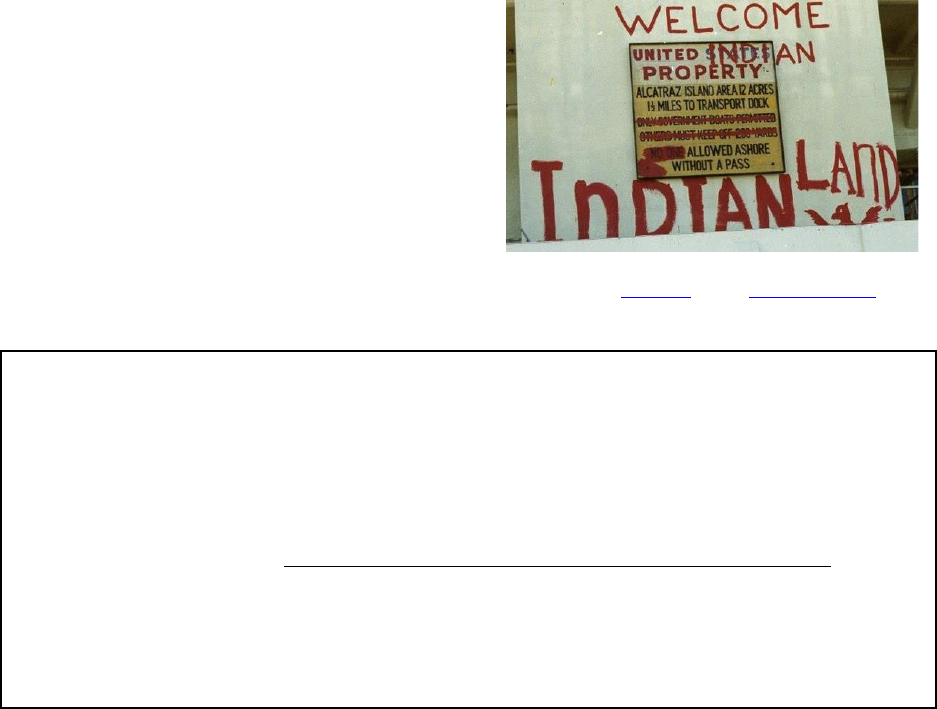
OUR LIVES: AN ETHNIC STUDIES PRIMER 54
reverse the termination of tribal recognition. Taking the cue of the African American protests of
the time, participants of the Red Power movement engaged in non-violent protests and
demonstrations to bring attention to their cause.
Additionally, the American Indian Movement (AIM) was founded in 1968. The supporters of
this movement were largely the results of the failures of relocation. These Native Americans
banned together in cities to create pan-Indian groups, this one growing into AIM. In November
of 1969, AIM and other supporters carried out a 19-month long Occupation of Alcatraz. The
federal facility lay dormant since 1963, and in a symbolic protest, Native American protesters
made landfall on the island, claiming the land theirs for the taking, much like the European
colonizers of the distant past. Occupants and supporters felt that reclaiming federal land from
the government sent a clear message to the
American public. For months, numerous Natives
occupied the island, contacting the mainland
primarily through a supply ship that would ferry
people and supplies back and forth during
occupation. Eventually the occupation ended due
to the government forcing their removal, but the
movement caught the brief attention of the
media lending sympathy towards their cause. To
this day, the graffiti on walls and structures
painted by the occupants is still present.
By the 1970s and 80s, some real changes were on the horizon. This began with the Indian
Education Act of 1972 that granted funds to increase graduation rates, curricular issues, and
support services of Native Americans. These policies continued to expand, exemplified in the
establishment of the first tribal college in the nation, the Navajo Community College. Some
schools even began to implement lessons on Native American culture and history.
Additionally, the American Indian Religious Freedom Act was passed in 1978 under the Carter
administration. For so long, Native Americans were compelled to suppress their culture and
APPLICATION 3.2
SHIFTING PERSPECTIVE: ALCATRAZ PROCLAMATION
Goal
To examine a Native American protest statement during the 1960s.
Instructions
Read the Alcatraz Proclamation (https://www.foundsf.org/index.php?title=ALCATRAZ_Proclamation). Answer
the following questions:
1. What is the tone of the Proclamation?
2. How does the speaker define “Indian Reservation”?
3. Were the actions of the Native American occupiers illegal, or justified?
"Alcatraz Occupation Welcome to Indian Land
graffiti" by Wikimedia is in the Public Domain, CC0

OUR LIVES: AN ETHNIC STUDIES PRIMER 55
assimilate into American society. Those that chose to hold on to religious traditions had to do
so in secret (Treuer, 2019). After this act was passed, Native Americans not only practiced their
beliefs in the open but were able to pass their traditions down to the youth who never
experienced them.
THE RECENT PAST
Beginning in the 1980s, the pseudo-reparations that Native Americans were awarded by the
government came in the form of Indian Gaming operations. In a landmark case, California v.
Cabazon, the Cabazon and Morongo Mission Indians won the right to run gaming facilities on
tribal lands. After this ruling, gambling operations arose in other reservation lands across the
nation. The late 80s witnessed legislation to tax and regulate Indian gaming, but otherwise,
APPLICATION 3.3
OUR FIRES STILL BURN
Goal
To develop knowledge and appreciation for indigenous people and the intrinsic relationship between social
movements and social change.
Instructions
1. Read the film review of Our Fires Still Burn: The Native American Experience.
(https://ijme-journal.org/index.php/ijme/article/download/999/988)
2. Watch the film Our Fire Still Burn: The Native American Experience: The Native American Experience Dance
Performance, Film Screening, and Panel Discussion.
(https://youtu.be/46jMgKMgQaI)
In preparation for class discussion, answer the following questions:
a. In what ways do you think the loss of Native American culture has directly or indirectly contributed to the
current social issues and conditions in Native Nations (ex. diabetes, heart disease, suicide rates, and
addiction)? Discuss actions Native people are taking today to reverse the effects of this cultural loss?
b. A section of the film examines the economic changes that were brought to the Isabella Indian Reservation
by introducing casinos and Indian Gaming. The pros and cons of this subject are debated across Native
Nations. Explore and discuss what you think the pros and cons are.
c. Levi Rickert says it is important for Native Americans to tell their own stories since their history and stories
are important to all individuals. As a class we will conduct our own oral history project. Use their phone
recorder or computer to interview a family member and gather a story. Then write a short response paper
on what you learned and how it your own understanding or perspective about your family, culture,
community, or racial-ethnic group.
Source
Adapted from Lee, J. (2014). Our fires still burn: The Native American experience viewer discussion guide. Vision
Maker Media funded by the Corporation for Public Broadcasting. https://visionmakermedia.org/wp-
content/uploads/2021/04/edu_vdg_ofsb.pdf

OUR LIVES: AN ETHNIC STUDIES PRIMER 56
these establishments allowed tribes to generate wealth for their communities. Profits and
distribution of profits vary from tribe to tribe. Currently, blood quantum continues to be the
defining factor of tribal membership and to be a member after the rise of Indian gaming carried
much more significance.
The 21
st
century continued to bring more cultural awareness to Americans. The myth of
Columbus and his “discovery” has been broken, and the violence and political policies of the
19
th
and early 20
th
centuries are included in the historical narrative. Indigenous Day has been
added to the calendar, the rediscovery of American Indian culture continues, and stereotypes
of Native Americans are disappearing from logos and mascots. However, there is still much
progress to be made. Native Americans still have remarkably low degrees in higher education,
and an average low median income compared to other racial and ethnic groups. COVID-19
severely impacted reservation communities. Chief Joseph, a leader of the Nez Perce once said,
"Good words do not last long unless they amount to something." As Americans, it is important
that we stand by the promises of the Declaration of Independence, equality, life, liberty, and
happiness.
SUMMARY
Native Americans once lived relatively peaceful. Once Europeans made initial contact, they
identified indigenous peoples as inferior, savage, and unworthy of the land they cultivated for
countless years. Once the U.S. was established, Americans embarked on a campaign of
conquest, removal, and relocation of Native Americans. After tribes were decimated by disease
and war, the U.S. government shifted policies to assimilation. Now, in the modern era, Native
Americans are attempting to recover their culture and heritage, still working within U.S.
institutions to reclaim tribal land and wealth.
REVIEW QUESTIONS
1. What kinds of societies existed in the Americas in pre-colonial times?
2. Describe the initial interactions between Europeans and indigenous peoples. Where they
positive or negative? Who benefitted from these interactions?
3. How did American westward expansion impact Native American populations?
4. What ways did Native Americans assert their civil liberties during the civil rights protests of
the 20
th
century?
5. How has the government sought to repair and restore relations with Native Americans in
modern times?
TO MY FUTURE SELF
From the module, what information and new knowledge did I find interesting or useful? How
do I plan to use this information and new knowledge in my personal and professional
development and improvement?

OUR LIVES: AN ETHNIC STUDIES PRIMER 57
REFERENCES
Columbus, C. (1492). Journal of Christopher Columbus, 1492. The American Yawp Reader.
http://www.americanyawp.com/reader/the-new-world/journal-of-christopher-
columbus/
Foner, E. (2014). Voices of freedom: A documentary history: Volume 1. (4
th
ed.). W.W. Norton &
Company.
Foner, E. (2014). Voices of freedom: A documentary history: Volume 2. (4
th
ed.). W.W. Norton &
Company.
Lee, J. (2014). Our fires still burn: The Native American experience viewer discussion guide. Vision
Maker Media funded by the Corporation for Public Broadcasting.
https://visionmakermedia.org/wp-content/uploads/2021/04/edu_vdg_ofsb.pdf
Lepore, J. (1998). The name of war: King Philip’s war and the origins of American identity.
Vintage.
Locke, J. & Wright, B. (2019). The American yawp. Stanford University Press.
http://www.americanyawp.com/index.html.
Richter, D. K. (2001). Facing east from Indian country: A native history of early America. Harvard
University Press.
Rothenberg, P. S. (2016). Race, class, and gender in the United States: An integrated study.
(10
th
ed). Macmillan.
Takaki, R. (1993). A different mirror: A history of multicultural America. Back Bay Books.
Treuer, D. (2019). The heartbeat of Wounded Knee: Native America from 1890 to the present.
Riverhead Books.
OUR LIVES: AN ETHNIC STUDIES PRIMER 58
MODULE 4. OUR STORY: AFRICAN AMERICANS
LEARNING OBJECTIVES
At the end of this module, students will be able to:
1. describe the transatlantic slave trade and formation of the colonial slave system in North
America
2. explore the development of the U.S. economy in terms of its reliance and use of slave labor
3. identify justification of Black slave labor from the Antebellum period to the Civil War
4. examine the effects of the Reconstruction period and the rise of the Lost Cause ideology
5. describe the 19
th
and 20
th
century development of segregation, Jim Crow laws, and
racialized violence
6. explain key people and events of the civil rights movement in the 1960s
7. explore the issues and impact of the late 20
th
and early 21
st
century on African Americans
KEY TERMS & CONCEPTS
Abolitionists
Abraham Lincoln
American Colonization Society
Bacon’s Rebellion
Booker T. Washington
Brown v. Board of Education
Civil Rights Act Of 1964
Claudette Colvin
Congress of Racial Equity (CORE)
Colonization
Dr. Martin Luther King Jr.
Dred Scott v. Sanford
Emancipation Proclamation
Executive Order 8802
Freedom Riders
Great Migration
Harlem Renaissance
Harriet Beecher Stowe
Indentured Servants
Jim Crow
John Rolfe
Juneteenth
Ku Klux Klan
Lost Cause
Lynching
Manumission
March on Washington D.C.
Massive Resistance
Minstrel Shows
National Association for The Advancement of
Colored People (NAACP)
Non-Violent Protests
Paternalism
Plessy v. Ferguson
Popular Sovereignty
Redlining
Rosa Parks
Sarah Keyes
Separate but Equal
Sit-In Protests
Slave Codes
Slave Resistance
Slavery
Stono Rebellion
Three-Fifths Clause
Transatlantic Slave Trade
Tulsa Massacre Of 1921
Underground Railroad
William Lloyd Garrison
Watts Riots Of 1965
W.E.B. Dubois
Voting Rights Act
OUR LIVES: AN ETHNIC STUDIES PRIMER 59
INTRODUCTION
The history of people of African descent in this country is complex and long, dating back to the
foundations of this country. For most of that history, the lives of African Americans have been
wrought with oppression and racism, but despite countless barriers, have contributed so much
to the nation’s history and its development.
The major events of African American history are best told in different phases – colonial
America to 1877, and 1877 to present – similar to how the study of U.S. history is structured in
schools. The historical narrative is also broken down into subphases, the Civil Rights era into
the 1990s, then the most recent past. This is intentional, since Black history is very much
American history, just as most other racial and ethnic groups.
This is their story.
COLONIAL PERIOD TO RECONSTRUCTION
Most historians begin the discussion of Black history in 1619 when the first slaves were sold in
Virginia. However, it is more effective to begin this history with the moment when free people
of African descent arrived in the Americas. Spanish colonizers arrived with the first free Africans
in 1492. Free Blacks existed in the Americas before enslaved ones did.
In North America, the first recorded peoples of African descent arrived in Jamestown in 1619.
These men and women were sold by Dutch traders as slave laborers to English settlers.
Slavery, the practice of forced labor without pay, was not a practice exclusive to the New
World, or even to Europeans. Slave labor had been utilized in many civilizations over the course
of human history. However, the system of colonization and the trans-Atlantic trade changed
the practice of slave labor for the next few centuries.
Colonial Virginia was in its early stages of development in 1619. When Virginia was settled, the
colony struggled with acclimation, starvation, and population growth. But things started to take
a turn for the better when John Rolfe brought tobacco planting to the colony. This crop was the
colony’s saving grace, for it became the cash crop upon which to build a powerful nation.
Tobacco was a difficult crop to harvest. Typically, the arduous labor required for this crop was
carried out by indentured servants - poor White contract laborers who obtained their ticket to
the new world by signing away 7-10 years of their life to investors in the colonies. But over
time, circumstances changed, and the White laborers proved to be problematic, provoking a
shift to African slave labor. The change in circumstances including general human progress
towards individual freedoms and the need to fulfill goals of opportunity and land ownership
that were typical of voluntary transatlantic migrants. In these early colonial times, there were
no clear rules as to how to regard Black slaves, nor was the concept of race clearly defined.
Generally, there was little regard for people of African descent, and Black slaves were treated
as less than human.
OUR LIVES: AN ETHNIC STUDIES PRIMER 60
In the early 15
th
century, Portuguese explorers established “slave factories”, or trading centers
on the western coasts of Africa, and began exchanging goods with African leaders for slave
laborers. Approximately four million Africans were transported and sold from the western coast
across the Atlantic for labor, forming the transatlantic slave trade. Slave traders justified their
practice of human trafficking by treating these men, women, and children not as human beings,
but as chattel, mere commodities to be sold for a profit. Slave ships were outfitted to maximize
profits, by chaining up the slaves laying down, side-by-side with little room to move or even
breathe. When Olaudah Equiano recalled the Middle Passage, the name for the journey across
the Atlantic, he recounted feeling “suffocated,” laying in “filth” and “horror” (Equiano, 1789).
Many of the enslaved peoples perished during the long and arduous journey from disease,
starvation, or even suicide. Tightly packed in the bowels of ships, Africans were dehumanized,
fed only enough to stay alive on the journey across the Atlantic, which could take anywhere
from 4 to 8 weeks (Foner, 2020). Many of these individuals were sold into the Caribbean and
South America, and only a small percentage would be sold into North America.
As Virginia continued to develop into a successful and lucrative colony due to tobacco, English
settlers started to get restless. They wanted to continue to expand westward, but English
authorities had signed treaties with nearby Native American tribes preventing them from
infringing on their territory. A new settler, Nathaniel Bacon, harnessed the discontent of the
White settlers to wage a rebellion against the local leadership spearheaded by William
Berkeley. Bacon’s rebellion uncovered many class issues of the colony, including the
discontent of poor Whites and former indentured servants. After months of protest and armed
conflict, Bacon was dead, his supporters hanged, and Jamestown was burned to the ground.
The groups that were the most disadvantaged after the conflict were the Native Americans,
whose lands were continually taken away from them, and Black slaves, who would be utilized
for labor more heavily than White European settlers, regardless of class.
While Bacon’s rebellion helped define colonial settlers need for manual labor, early slave codes
were responsible for definition of people of African descent in the colonies. The earliest colonial
years would experience some ambiguity between poor Whites and Black colonists – some
colonists even married and had biracial children. But as concepts of race were being further
defined by scholars and society in general, Virginia again was at the forefront of creating legal
parameters of race relations. Virginia established the first Slave Codes, a list of laws and
regulations to define punishments, legal status, and property rights regarding Black slaves.
These codes were most likely created because of problems that arose due to the lack of
precedence for racialized slave labor in European colonies. Most of these codes were written to
regulate crime and punishments, but one very pivotal code created the basis for the institution
of slavery in America for the next few hundred years.
That 1662 code stated “that all children borne in this country shall be held bond or free only
according to the condition of the mother.” This legal definition created the rule that made the
condition of slavery one that was acquired at birth. Over the course of human history, in many
of the civilizations that practiced slavery, the condition of slavery was not genetic, nor acquired
at birth. Slaves were typically prisoners of war or working off debt. At this point in colonial

OUR LIVES: AN ETHNIC STUDIES PRIMER 61
Virginia, English colonists created a new precedent for slave laborers that would be explicitly
tied to Black slave laborers. Individuals were born into slavery, and it was rare to escape
slavery.
The enslaved experience also varied depending on region, period, and owner; but typically,
slaves’ lives were harsh with meager living provisions and physical punishments if a slave
disobeyed orders. Slaves were considered the property of slave owners, property that could be
bought, sold, punished, or even killed. Colonies each had different codes and laws to dictate
slaves’ lives, but there were few, if any limits to regulate the physical abuse or even murder of
slaves.
The narrative of the enslaved peoples has gotten very much distorted over the course of
American history. Some students wonder why they were complacent to forced labor, and for
much of this nation’s history, many people believed the Blacks were simply incapable of
resisting. This is simply not true.
Slave resistance sometimes occurred even aboard the dreaded slave ships. Many slaves were
shipped off to the Americas because they were prisoners of tribal war conflicts in Africa.
Resistance on slave trade ships proved futile, but it still occurred. Upon arrival in the Americas,
many different modes of resistance were common. Some were subtle, like working slow or
feigning sickness. Others were more overt like running away from their captors. See the
advertisement below meant to help the slave owner “find” their runaway slave.
1769 Virginia Gazette Advertisement
Ad placed in the Virginia Gazette in 1769.
RUN away from the subscriber in Albemarle, a
Mulatto slave called Sandy, about 35 years of age,
his stature is rather low, inclining to corpulence, and
his complexion light; he is a shoemaker by trade, in
which he uses his left hand principally, can do coarse
carpenters work, and is something of a horse jockey;
he is greatly addicted to drink, and when drunk is
insolent and disorderly, in his conversation he
swears much, and in his behaviour is artful and
knavish. He took with him a white horse, much
scarred with traces, of which it is expected he will
endeavour to dispose; he also carried his
shoemakers tools, and will probably endeavour to
get employment that way. Whoever conveys the said
slave to me, in Albemarle, shall have 40 s. reward, if
taken up within the county, 4 l. if elsewhere within
the colony, and 10 l. if in any other colony,
from THOMAS JEFFERSON
"1769 Virginia Gazette Advertisement" by Wikimedia is in
the Public Domain, CC0

OUR LIVES: AN ETHNIC STUDIES PRIMER 62
Running away was the most common form of resistance to slave owners, and one that they
vehemently tried to fight against, whether by physically punishing slaves or creating laws to
sanction that violence. The other form of resistance that was much feared by slave owners was
armed rebellion. While this was not very common, when it occurred, armed rebellion was met
with harsh punishments and severe consequences.
The earliest organized rebellion to take place in North America was the Stono Rebellion.
During this rebellion, slaves that had military experience were able to coordinate this rebellion
through their training and shared language. They killed several White colonists in the process
and conspired to make their way to Spanish controlled Florida, where there were Indians who
harbored escaped slaves. One important detail is that as the slave rebels were briefly free, they
moved about the town by shouting, “Liberty!” Up to this point, English authorities
characterized enslaved Blacks as if they were incapable of understanding concepts of freedom
and liberty like those that were so popular in the age of revolution. This incident in South
Carolina proved contrary to their beliefs, reinforcing fears of slave rebellion on the scale of that
that had just occurred in the nearby nation of Saint Domingue, now a free Black nation known
as Haiti. From that point on, slave rebellion would be the most feared circumstances that slave
owners could imagine, and they would do anything in their power to stop one from occurring.
As a reaction to this rebellion, harsher codes were established, ones that would prevent a
future rebellion. New slave codes were introduced such as preventing slaves from leaving the
property, congregating in groups, or even learning how to read and write. All of these were
established, reinforced, and adopted in similar slave-based economies in southern colonies in
order to control slave populations.
For most of the colonial period, contributions of those of African descent to the historical
narrative was mostly tied to slave labor. There were few outliers to the story of hardships, racial
violence, and victimization. However, men like Benjamin Banneker should be highlighted. He
APPLICATION 4.1
SHIFTING PERSPECTIVE: BENJAMIN BANNEKER
Goal
To understand the perspective of an intelligent, free Black man of the early republic.
Instructions
Read Black scientist Benjamin Banneker demonstrates Black intelligence to Thomas Jefferson, 1791
(http://www.americanyawp.com/reader/the-early-republic/black-scientist-benjamin-banneker-demonstrates-
black-intelligence-to-thomas-jefferson-1791/). Answer the following questions:
1. Why is Banneker eager to prove his intelligence to Thomas Jefferson?
2. How does Banneker use language to convey his intelligence to Jefferson?
3. Was Banneker successful in asserting his intelligence?
OUR LIVES: AN ETHNIC STUDIES PRIMER 63
was born free and self-educated and managed to catch the attention of Thomas Jefferson in an
exchange of letters. There is also the early case of Elizabeth Key, who was born of an interracial
union and sued for her freedom and inheritance from her White kin. Hers was one outlying
story of success where others were not as fortunate.
Also notable are the individuals who fought in the American Revolution. After the British openly
recruited Black slaves to fight for the Crown to gain their freedom, General Washington was
urged to open enlistment for Black soldiers in the Continental Army. This is one instance of
early American history wherein Blacks and Whites fought in integrated regiments against a
common enemy. America would not see this level of integration until the Vietnam War, nearly
200 years later. These are the real stories of Americans, who impacted American history small
and big ways, notable against much adversity.
After the American revolution, as the early republic of America ratified the constitution and
created its foundational laws, southern lawmakers saw fit to include provisions to ensure their
interests would be protected. In doing so, these lawmakers also redefined the legal parameters
of Blacks in America. As a compromise to include Black slave populations in the count to
determine representation in Congress, the founding fathers included the Three-Fifths Clause in
the Constitution. This law determined that for every five White men, three Black men would be
counted in the state’s population. Southern lawmakers advocated for this clause to ensure
maximum political representation on a federal level, while still diminishing Black slaves as
property, not free citizens of the country. At this point in the nation’s history, citizenship was
defined as your ability to vote, which was exclusively granted in most states to only White,
property-owning men.
As North America continued to be organized into states, a delicate balance was established.
Agriculturally based economies of the south allowed the practice of slavery in their states,
which garnered the label “slave state.” In the north, where states later focused on industrial
development, mostly outlawed slavery. These states were called “free states.” The U.S.
government made the choice to keep a balance of both free and slave states as they continued
to expand westward, to keep a balance of different political ideologies and economic interests
were represented in government.
The African American experience from colonial times to the 1850s varied depending on region,
time period, and of course slave or free status. Different factors over time, including ambiguity
in colonial laws and manumission – the practice of voluntarily releasing one’s slaves from
ownership, led to a significant number of free slaves in America by the mid-19
th
century. The
majority of these former enslaved resided in northern states, but there were some in the south
as well. Virtually all African Americans, whether enslaved or not, suffered racial discrimination.
Years and years of Eurocentrism and White supremacy created an environment of racial
oppression regardless of being “free.” Despite these hardships, being a free Black person in
America was certainly preferable to being enslaved.
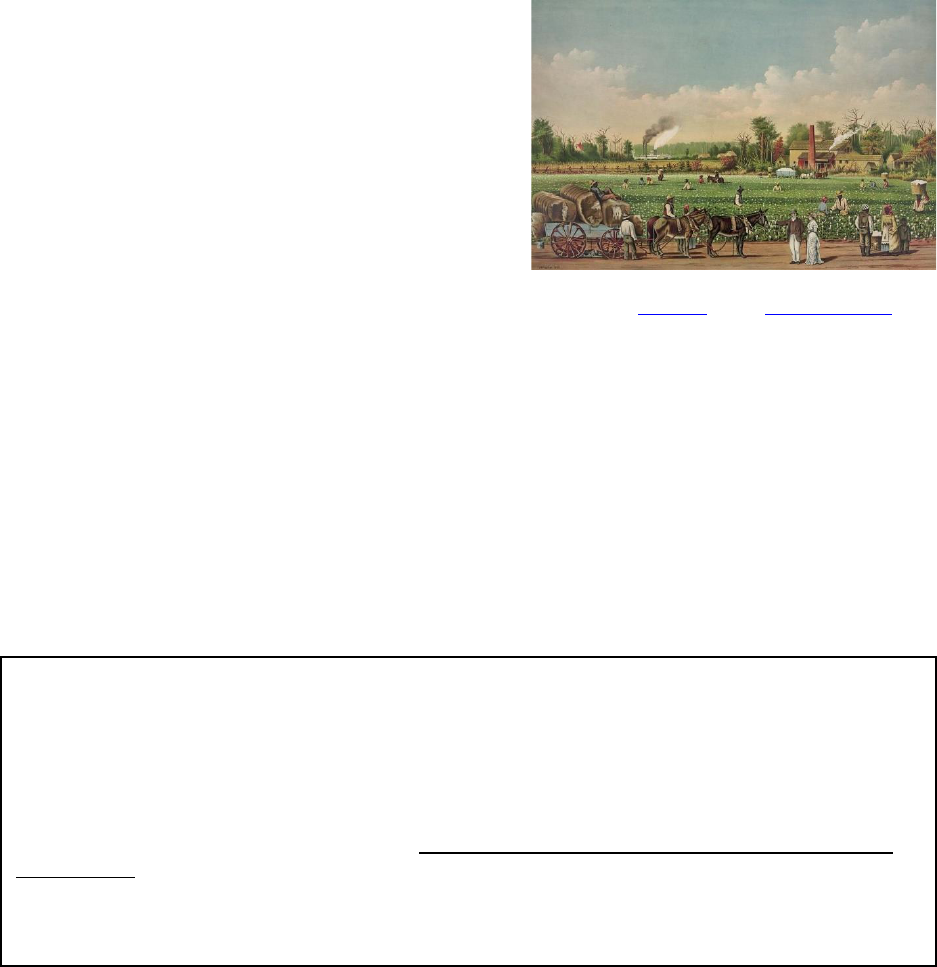
OUR LIVES: AN ETHNIC STUDIES PRIMER 64
Despite the transatlantic slave trade being closed to the U.S. in 1808, slave populations
continued to grow exponentially in the south. This was largely due to the precedent of the slave
code of passing the condition of slavery through the matrilineal line. As Americans continue to
expand into the west, slave population did as well, continuing to labor away on plantations
across the south. Initially, colonial Americans held slaves in bondage as a necessity, a labor
force that aided in building wealth and stability in the country. By the 1830s, use of Black slave
labor was an integral part of the economy in the U.S. Between slave traders, auctioneers,
investment bankers, and the planters themselves, most parts of the U.S. economy relied on the
continued use of Black slave labor.
By the early 19
th
century there were a variety of
ways slave owners justified continuing the practice.
First, slave owners used the concept of paternalism
to keep the practice. This concept argued that Black
slaves were simply mentally incapable of taking care
of their own well-being, therefore must remain in
the care of their owners, who gave themselves the
role of parent or guardian to a Black slave. George
Fitzhugh, a pro-slavery advocate, claimed that
“slaves are all well fed, well clad, have plenty of
fuel, and are happy” (Fitzhugh, 1854). He asserted
that without the efforts of slaver owners, “crime
and pauperism” would increase; therefore, slave owners were also doing a service to the
nation. Paternalism not only reinforced ideas of White superiority but masked the institution
with the idea that slave owners were carrying out a noble service to the country.
Other justifications of continuing the use of Black slave labor included references to Biblical
passages that referred to social hierarchy and obedience as well as references to ancient
societies. For instance, because ancient peoples like the Romans practiced slavery, Americans
remarked that they built that empire and their advancements in arts and sciences because they
were not occupied with difficult labor that the slaves were doing for them.
APPLICATION 4.2
SHIFTING PERSPECTIVE: JUSTIFYING SLAVERY
Goal
To explore the ways in which pro-slavery advocates justified the continued use of slave labor.
Instructions
Read Slavery a Positive Good by John C. Calhoun (https://teachingamericanhistory.org/document/slavery-a-
positive-good/). Answer the following questions:
1. List the reasons that Calhoun provides to assert that slavery is a “positive good.”
2. Why would Calhoun write this statement to defend his position?
"Cotton Plantation on the Mississippi_
1884" by Wikimedia is in the Public Domain, CC0
OUR LIVES: AN ETHNIC STUDIES PRIMER 65
Although there were many Americans that advocated for the continued use of slave labor,
some decided that the enslaved should be set free. Abolitionists were people that believed that
slavery should be legally abolished and rose out of an era of reform movements of the early
1800s. Abolitionists gained much support from the most pious individuals; many of which
believed that the progression of America was inextricably tied to social reforms. Most
abolitionists believed in ending the practice of slave labor altogether. However, there were
some that believed in the concept of colonization. Colonization was the idea that Black slaves
would be freed, but they could not remain in the U.S. In 1816, the American Colonization
Society was formed to carry out this plan. A track of land called Liberia was purchased in Africa.
This region would be the place that the freed slaves would be transferred to, instead of living
free in America. This concept reflected the inherent racism that ran deep within American
society, since even though they rejected the practice of forced labor, they still denied African
Americans a place in society. Certainly, equality for Black men and women that were born in
the country and participated and contributed to the nation was not an option for many
Americans at this time. Although support for colonization was not widespread, there were still a
few thousand Blacks that were freed and moved to Liberia under this plan.
Famous abolitionists during this period ranged from men and women, both White and Black.
One of the most notable White abolitionists was William Lloyd Garrison, who published an
abolitionist newspaper, The Liberator, which communicated the ideals of emancipation and
freedom to the public. Similarly, a woman named Harriet Beecher Stowe published a book
called Uncle Tom’s Cabin, a narrative based loosely on a slave’s life. Both individuals used their
voices to carry a message to the American public about the moral wrongs of slavery and its
continued use in the U.S.
Even more significant were the Black abolitionists voices of the time. Fredrick Douglass was
perhaps one of the most notable of the time, for he was a self-educated runaway slave. A
skilled orator, Douglass spoke passionately about many issues plaguing the U.S. of the time,
chief of which was slavery. Most Americans would also recognize the name Harriet Tubman, for
she was known not only as a runaway slave, but a woman who helped many others runaway
from enslavement and hide in the North. To her own risk, Tubman made several trips back and
forth over the Underground Railroad, a nickname for a series of trails and safehouses that led
slaves to safety in the North. While Tubman successfully traveled from Maryland into
Pennsylvania, the Underground Railroad network had routes into other areas in the North and
also Canada and even Mexico.
By the 1850s, the political debate regarding the institution of slavery had affected lawmakers in
significant ways. First, after the Mexican American War, the U.S. acquired a wide swath of land
– land that would eventually be organized into states. The potential for additional states in the
Union meant the disruption of the delicate balance of free and slave states. The debates that
raged amongst lawmakers was how to determine the status of these states. The Missouri
Compromise of 1820 stated that any territory above the 36 30 parallel could not be designated
slave states. However, some politicians argued that new territories petitioning for annexation
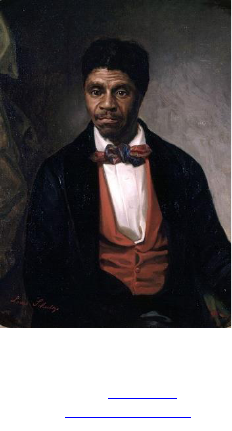
OUR LIVES: AN ETHNIC STUDIES PRIMER 66
as a state should utilize popular sovereignty for determining status. Popular sovereignty meant
that the residents of a state should vote on whether the state enters the Union as ‘free’ or
‘slave.’ Again, this meant the potential disruption of balance between free and slave states, also
tipping the balance of power in Congress.
Additionally, a pivotal case was tried in the courts in 1857. Dred Scott
v. Sanford regarded a slave who was petitioning for his freedom. Dred
Scott was a slave that was relocated with his owner to the state of
Illinois, a free state. Scott believed that since he was living for several
years in a free state that must mean he was no longer a slave.
However, the U.S. Supreme court ruled against Scott. In his statement
after the ruling, Chief Justice Taney declared that Scott was not a U.S.
citizen; he was property, “not entitled as such to sue in its courts,” and
that his lawsuit was invalid. Additionally, Chief Justice Taney made
statements regarding the inferiority of Black slaves, and that the
“negro…be reduced to slavery for his benefit....” The decision of the
court determined the legality of ‘free’ and ‘slave’ state distinctions.
Effectively, Taney’s statement made it unconstitutional to ban slavery
in any state, inflaming the slavery debate across the country, and
deepening the sectional divide of the time (Taney, 1857).
To further deepen divisions in the U.S., a presidential election was at hand in 1860. South
Carolina leaders went public with statements threatening to secede from the Union if candidate
Abraham Lincoln was to become president. Southern political leaders feared that if the
Republican party lead by Lincoln was to gain more power, the party would threaten states’
rights to uphold the institution of slavery. Once Lincoln was elected, southern states one by one
voted to secede from the Union. Only after civil war would the country become whole once
again.
The American Civil War continued to stretch the limitations of race relations in America. As the
Confederacy pitted itself against the Union, thousands of Americans were killed. Initially,
African Americans from all over the nation were eager to join the fight. White Union soldiers
joined the fight for many reasons - abolition, draft, patriotic duty and more. For Blacks, joining
in the war effort meant that they were fighting for their freedom. However, for the initial years
of the war, Blacks were prevented from enlistment. Only after the Emancipation Proclamation
was issued were Blacks allowed to fight. Even when enlisted, these men were segregated from
White soldiers, trained and led by White men, and paid less than their White counterparts at
the same ranks. Contrary to popular belief, the proclamation did not free all the slaves. The
Emancipation Proclamation freed the enslaved who resided in states that had seceded from
the Union. There were still some slave states where slavery remained untouched. Slavery
would not be officially abolished in America until the passage of the 13
th
amendment in 1865.
As President Lincoln promised, a “new birth of freedom” (Lincoln, 1863) was made possible
after the dust settled from the Civil War. The Reconstruction era promised much hope for
"Dred Scott Oil Canvas by
Louis
Schultze" by Wikimedia is in
the Public Domain, CC0
OUR LIVES: AN ETHNIC STUDIES PRIMER 67
newly emancipated slaves. Although slavery was officially abolished in January of 1865 and war
ended in April of the same year, Juneteenth – June 19, 1865, is traditionally the day that was
declared Freedom Day for African Americans in the U.S. For the formally enslaved, freedom did
not just mean the end of slavery, but it meant the opportunities that most did not have access
to before 1865. First and foremost, Black communities wanted access to land and voting rights.
Since the revolution, these have been the hallmarks of American freedom. Other freedoms
came with being newly freed in the U.S. like being reunited with lost loved ones after being sold
away, access to education and medical care, the ability to buy a weapon, and for some, even
running for political office.
Only these freedoms were not guaranteed in the era of Reconstruction. Although the 13
th
, 14
th
,
and 15
th
amendments protected the rights of most African Americans, this legislation was not
easily accepted by southerners who sought to maintain White supremacy. Very quickly,
vigilante groups were formed to prevent Blacks from Constitutional freedoms, especially those
that attempted to run for office, buy land, and even cast their votes. Groups like the Ku Klux
Klan formed to enact violence and intimidation in communities that attempted to exercise their
rights. Eventually, Congress issued measures to allow military occupation of former confederate
states to protect Black communities. Additionally, legislation was enacted to root out and
suppress KKK and other vigilante groups from operating.
Eventually, political pressures led to a compromise that ended military occupation in the south
as well as drawing back on pressures to maintain peace. During the election of 1876,
Republican candidate Rutherford B. Hayes’s victory was at question due to a very narrow
margin of victory. In order to secure enough support to maintain a Republican in the White
House, political leaders made a compromise to secure Hayes’s victory but vowed to withdraw
federal troops from southern territories. Effectively, Northerners waning interest in supporting
measures of racial equality in the U.S., coupled with a danger of political power, equaled the
end of Reconstruction.
1877 TO WWII
After the failures of Reconstruction, the southern leaders reasserted their White supremacy in
politics and society. As the south began to industrialize, agriculture remained at the center of
most state economies. Tenant farming or sharecropping was one of the ways to suppress the
economic progress of southern Blacks. Banks, politicians, and others worked together to
prevent Blacks from purchasing land for farming, whether it be with aggressive intimidation or
simple denial of bank loans (Coates, 2017). Relegating Blacks to sharecropping kept them under
the control of White landowners, while also preventing economic growth.
Other forms of oppression included voter suppression. Measures were adopted in many
counties across the south to prevent African Americans from registering to vote. These
measures included poll taxes and literacy tests. Most of these measures were directed solely to
African American communities.
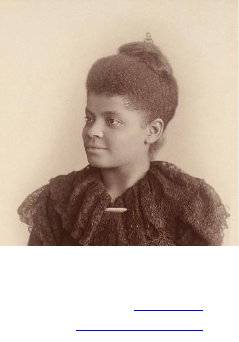
OUR LIVES: AN ETHNIC STUDIES PRIMER 68
Post-Reconstruction, the so-called New South also adopted a concept called the Lost Cause.
This concept rewrote the events of the Civil War for southerners, elevating and romanticizing
the war to make former Confederate soldiers’ heroes to their cause – defenders of the south
and states’ rights. Monuments were built to glorify southern military leaders, Confederate flags
were flown on state buildings, all meant as a reminder of the glorified Confederate past. Many
regarded these actions as a reinforcement of White supremacist power in the south (Kytle &
Roberts, 2018). This was a reinforcement of racial hierarchy and each symbol of the
Confederacy signaled fear and intimidation in the hearts and minds of African Americans for
several more generations.
Additionally, in 1890, a monumental case was tried in the supreme court that would impact the
south for the next few decades. This case regarded a man who was descended from both White
and Black ancestry named Homer Plessy. Plessy was arrested for sitting in a rail car designated
for only Whites according to the Louisiana Separate Car Act. After the case was tried in the U.S.
Supreme Court, the justices ruled that the segregation law was constitutional, and from then
on, the “separate but equal” clause established racial segregation laws in many southern
states. This clause meant that if separate facilities for Whites and Blacks were deemed “equal,”
but only designated for use by skin color, racial segregation was Constitutional. Plessy v.
Ferguson became the basis for racial segregation in state institution and public places like
schools, restaurants, water fountains, and more.
The Plessy verdict marked the beginning of an era known as the Jim Crow South, an era that
would not end until the 1960s. Any state that adopted racial segregation laws after the Plessy
verdict was considered a Jim Crow state. Jim Crow refers to a character portrayal of a Black
slave from the mid-19
th
century. This caricature was often found in minstrel shows, racist
shows that contained skits and mini plays that portrayed the Black slave as unintelligent,
subservient, lazy, and almost clown like. Usually, White performers would wear blackface –
painting their faces black to play these roles. These types of shows continued in popularity well
into the 20
th
century.
Along with Jim Crow laws arose an unspoken code of racial norms that were adopted in much
of the south. These racial norms stemmed from the slave to master relationship of the distant
past. These societal rules dictated that African Americans should
always show deference to Whites in society, regardless of age, sex,
or any other differential factors. Examples of this deference would
be offering a White person a seat on public transportation, moving
aside to let a White person pass, or even avoiding eye contact with
a White person.
Another element of White supremacy and reinforcement of power
in the Jim Crow South was racialized violence in the form of
lynching. Lynching was the act of carrying out extralegal
punishments on individuals without fair trial. These violent, racial
attacks were mostly doled out to Black men under the suspicion of
"Ida B. Wells-Barnett
Photograph by Mary Garrity
from c. 1893" by Wikimedia is
in the Public Domain, CC0

OUR LIVES: AN ETHNIC STUDIES PRIMER 69
violating social norms. Many of these public executions were provoked by the supposed attack
or offense to a White woman. The range of violence in lynching was wide, some public
hangings, others included harsh corporal punishments and torture, often committed by
multiple individuals. Some lynching acts were carried out as spectacles, wherein the victim of
the punishments was held until a crowd could build up in number to watch. This vigilante
justice maintained the structure of White power especially in the deep south for much of the
early 20
th
century.
Despite all the elements of subjugation that the African American communities throughout the
nation endured, many notable figures prevailed in uplifting and advocating for Black civil rights.
For instance, Booker T. Washington was born from slavery but still advocated for Black rights.
Washington believed that African Americans should support each other in building businesses
and wealth within their own communities. This would be accomplished by becoming educated,
especially in a trade skill. Washington sought to work within White systems and institutions to
accomplish his goals.
W.E.B. DuBois was another man who pushed the envelope further. DuBois believed in pushing
against the status quo by challenging racial inequalities in America. It was DuBois that helped
established the National Association for the Advancement of Colored People (NAACP) in 1909.
Because of the increased racial violence and discrimination in the Jim Crow South, many African
Americans fled from the deep south for larger more metropolitan cities like New York City,
Detroit, and Chicago. Beginning in about 1916, this movement of African Americans was called
the Great Migration. Moving out of the rural deep south not only meant distance from racial
segregation laws but more job opportunities.
In New York during the 1920s, African Americans thrived during a period dubbed the Harlem
Renaissance. The arts, in different forms, music, literature, poetry, and more were cultivated
and explored by Black artists during this time period of explosive creativity. Jazz music as well as
blue is attributed to Black communities. Notable authors like Langston Hughes and Alain Locke
inspired one another as well as other writers in the community.
APPLICATION 4.3
SHIFTING PERSPECTIVE: WHAT IS RACE?
Goal
To recognize Dubois’s opinion of race and race relations during his lifetime.
Instructions
Read The Conservation of Races (https://teachingamericanhistory.org/document/the-conservation-of-races/).
Answer the following questions:
1. How does Dubois define race?
2. What is the significance of race according to Dubois?
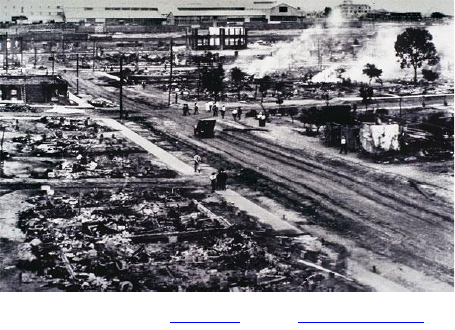
OUR LIVES: AN ETHNIC STUDIES PRIMER 70
And although the 1920s was a thriving post-
war period of culture and wealth, Black
communities were never far from racial
violence and oppression. In 1921, Tulsa,
Oklahoma saw one of the most violent attacks
motivated by race in the country. The Black
community of Greenwood was a thriving,
economically successful community. This area
was known as the “Black Wall Street” due to its
economic success. The Tulsa Massacre of 1921
was inspired by an alleged attack upon a White
woman named Sarah Page by Dick Rowland.
Rowland was taken into custody and a lynching was said to have been planned. Members of the
Black community attempted to stop this lynching, and a violent altercation erupted into a riot.
This riot devolved into a full-fledged massacre and destruction of Greenwood. Bands of White
attackers descended into Greenwood to attack and kill Black men of the community, as well as
loot and burn businesses. This attack only ended when state authorities instituted martial law.
The details of this attack had been obscured over the years, mostly downplayed by White
authorities. There was little to no justice served for any of the crimes committed. The number
of deaths is still unknown and property damage was extensive.
Wartime, for African Americans, provided opportunities for people of color who would not
normally have opportunities. Depending on the period of history, war provided Blacks the
opportunity to express patriotism, earn a fair wage, or participate as an American, even when
they were not granted the rights and privileges of other Americans. African Americans fought in
every armed conflict in this nation’s history, beginning with the American Revolution. By WWI,
Blacks continued to serve in the military, despite being paid less, being segregated from Whites,
and disrespected as returning veterans.
World War II signaled a different opportunity for African Americans. As the working class was
drafted into war, factories were left to hire amongst the pool of Americans that were left. This
meant employment opportunities for those who did not have prior access to well-paying
industrial jobs – people like women and African Americans. However, racial discrimination still
provoked companies from allowing Blacks access to these jobs. Only after A. Phillip Randolph
threatened a large-scale protest in Washington D.C. did President Roosevelt issue Executive
order 8802. This order prohibited employers from racial discrimination when hiring employees
in defense industry jobs. Although this was a wartime provision, this order opened the door for
African Americans to continue their push for racial equality in the near future.
Gainful employment and better wages during and just after the war only meant incremental
changes for African Americans. To uphold the status quo of White superiority, the practice of
redlining became common in the U.S. Redlining is the discriminatory practice of denial of
services, usually bank loans, to individuals that lived in areas deemed “hazardous” or poor.
"Tulsa Aftermath" by Wikimedia is in the Public Domain, CC0
OUR LIVES: AN ETHNIC STUDIES PRIMER 71
These redlined areas were usually populated with people of color. In practice, this was the
prevention of allowing African Americans and other racial minorities from leaving these
redlined areas, despite their financial status. This denial of opportunity was often extended to
other areas such as better education and health care.
CIVIL RIGHTS MOVEMENT OF THE 60S & 70S
The Cold War era is the period that further inspired African Americans to mobilize against
issues of racial segregation and demand racial equality. The end of WWII left the U.S. promising
to promote self-determination of politically weak nations and the protections of humanitarian
rights throughout the world. But if Americans could uphold these commitments for foreigners,
what about the inequities at home? African Americans and other racially minoritized groups
were asking these questions, which led to the civil rights movement of the 1960s.
There were many hallmarks of the African American civil rights movement, and here are just a
few significant events. The first hurdle to cross for the movement was to undo the years of
segregation laws that prevented African Americans from exercising their fundamental rights as
citizens of this country. The monumental court case to overturn racial segregation began with
children attending schools, specifically Oliver Brown and his daughter Linda. She had to walk six
blocks to catch a bus to attend an all-Black school; however, a White school was located much
closer to their residence. Brown and other parents formed a class action lawsuit against the
Board of Education to challenge segregation in schools. This case made it to the U.S. Supreme
court, and the result was monumental. Brown v. Board of Education both gave momentum to
the civil rights movement and took a great step forward in the fight for racial equality. In a
single opinion statement given by Chief Justice Earl Warren, the court overturned the “separate
but equal” clause of 1890, ending racial segregation in schools. Read the monumental decision
below.
Other strides were made to challenge segregation laws in Jim Crow states. To challenge
segregation in public transportation, individuals like the infamous Rosa Parks, Claudette Colvin,
and Sarah Keyes either refused to give up their seats, or remained sitting in ‘White’ sections of
the bus until they were arrested. The consequential Montgomery Bus Boycott left buses in
Alabama vacant for months, until racial segregation on buses was declared a violation of civil
rights under the law. Later, the Freedom Riders, both Black and White members of the
Congress of Racial Equity, or CORE, continued this work by checking the compliance of
desegregation on buses. The activists that defied long held racial norms were met with strong
opposition, often turning brutally violent. Eventually, the Interstate Commerce Commission
complied with desegregation laws.
Beginning in 1960, more young organizers staged sit-in protests in restaurants and diners.
Again, the sit-ins were meant to challenge segregation laws in these businesses that separated
White and Black customers. Sit-in protesters would sit in ‘Whites only’ sections, attempting to
be served. Again, the sit-in activists were subject to taunts, food thrown at them, and even

OUR LIVES: AN ETHNIC STUDIES PRIMER 72
beatings by Whites who wanted to maintain the dominant power structure. These protests
began in North Carolina and later spread to other major cities.
Regarding racial protests and organizing, there were no other famous figures of the Black civil
rights movements other than Dr. Martin Luther King Jr. Dr. King was key to grassroots
organizing in this era, forming the Southern Christian Leadership Conference, or the SCLC. King
and his supporters committed to non-violent protests – civil disobedience. The strategy was to
create social change by disrupting civil order but also rejecting violent acts of opposition. King
staged many marches and protests using this strategy, including the famous March on
Washington D.C. in August of 1963. The “I have a dream” speech has been made famous since,
but in the moment, inspired many to support racial equality.
Eventually, all this organizing and demonstrating would
result in legislative change. Under President Johnson, the
Civil Rights Act of 1964 was passed. This act outlawed all
discrimination in public facilities based on color, religion,
sex, and national origin. Later, after further demonstrations
that unraveled into violence, the Voting Rights Act was
passed in 1965, outlawing the denial of suffrage to African
Americans through literacy tests, poll taxes, or any other
means of disenfranchisement. Voting rights, a touchstone of
American democracy and freedom, was finally within the
reach of Black voters, with legislative measures to protect
their rights as American citizens.
Despite these various strides forward in the civil rights movement, at every step participants
were met with aggressive and oftentimes violent opposition. The Freedom Rider buses were
attacked and firebombed. Marchers in Alabama were met with attack dogs, fire hoses, and
arrests despite their commitment to non-violence and the presence of children. In a devasting
bombing of the historic Black church, the 16
th
Street Baptist Church was attacked, resulting in
numerous injuries and the tragic deaths of four young girls. During the efforts to integrate
APPLICATION 4.4
SHIFTING PERSPECTIVE: LETTER FROM BIRMINGHAM
Goal
To understand Dr. King’s stance on social reform.
Instructions
Read the Letter from Birmingham Jail (https://teachingamericanhistory.org/document/letter-from-
birmingham-city-jail-excerpts/). Answer the following questions:
1. How does Dr. King define a “non-violent campaign”?
2. Why does Dr. King emphasize the concept of waiting?
"Bloody Sunday Officers Await
Demonstrators" by Wikimedia is in
the Public Domain, CC0
OUR LIVES: AN ETHNIC STUDIES PRIMER 73
schools, children were met with organized opposition in the Massive Resistance movement.
Southern White politicians, school boards, and White parents worked together to stop
desegregation. In some cases, they even closed schools down to prevent schools from
becoming integrated.
By the end of the decade, the movement became somewhat fragmented. With the
assassination of Dr. King in 1968, and numerous other protests and domestic turmoil
throughout the nation, the movement lost some focus. In the case of the Watts Riots of 1965, a
traffic stop of a Black man devolved into days long riots in the Los Angeles area resulting in
numerous deaths and millions in property damage. The end of the decade found conservative
lawmakers characterizing the civil rights movement as part of a nationwide issue of unrest and
the rise of criminal behavior. The push for law and order, as well as the rise of the conservative
right brought the civil rights era to a definitive close with the election of Reagan in 1980.
THE RECENT PAST
In the final decades of the 20
th
century, African Americans continued to push against racial
oppression. They continued to face issues like wage inequality, racial profiling, general racial
discrimination and more. Measures like affirmative action attempted to address racial
inequities but were debated and rejected.
Jesse Jackson was heralded as a symbol for change as he embarked on a Democratic
Presidential nomination in 1984 and 1988. Numerous other Black politicians entered public
service offices. Of course, the most recent and notable Black politicians in American history is
Barack Obama, who was voted president in 2008 and served until 2017.
Popular entertainment would also see the successes of comedians like Eddie Murphy and
Whoopie Goldberg, actors like Denzel Washington and Viola Davis, musicians like Michael
Jackson and Whitney Houston, and of course, Oprah as an arbiter of culture.
Despite these successes, the underbelly of race relations in the U.S. is exemplified in the various
deaths of many Black men and some women, mostly at the hands of the police or White
citizens. Trayvon Martin, Michael Brown, Philando Castile – as well as most recently Breonna
Taylor, Ahmaud Arbery, and George Floyd are just some of the names of controversial deaths in
recent years. The Floyd murder at the hands of the police spurred another surge in the social
movement Black Lives Matter, a movement that advocates against police brutality and racially
motivated violence. In 2020, protests erupted nationwide objecting to systemic racism that
permeates American society. Supporters of the movement seek to undo racial inequities in
education, employment, and other walks of American life.
Although the debates for racial justice, solutions for racial inequities are still ongoing, there is
much to learn and reevaluate about African American historical narratives. African American
history is American history as much as any other racial and ethnic group in this country and
should be recognized for the role and place they have in the nation’s history.

OUR LIVES: AN ETHNIC STUDIES PRIMER 74
BIOGRAPHICAL REFLECTION 4.1
A PROUD AMERICAN OR A PROUD AFRICAN AMERICAN?
That is a question for the ages. We all have an identity. The question is, is the identity framed from within, or is it
assigned to us? I think about that a lot, and I believe I have come to an answer of sorts, even if not all will agree
with me. As a man of color in America, I am also an American who incidentally happens to be a man of color.
What’s the difference you say? Well, read on friend, then you can tell me.
I grew up in a mixed neighborhood, where all the primary races were present within a three-block radius, any
direction you looked. And I attended a parochial school where less than one percent of the student body was of
color. Each day I stood and proudly said the Pledge of Allegiance. I didn’t notice that my being African-American
meant anything more than the student next to me being a Caucasian-American. Race was not discussed openly. In
a very real sense, I was color-blind.
I was quite proud of my father who was in the Army, a veteran of both the Korean and Vietnam Wars. My mother
worked as a civilian contractor for the military, at one point elevating to Regional Director for the Contracting
Division in Fort Lewis, Washington. I have every reason to be proud of my parents. They served the American
military community very well. They served America well.
And I myself am a veteran, having served four tours as an Air Force Officer and language development instructor
for military dependents.
I am happy, and to be plaintive—very proud to have served the United States of America. I stand on the shoulders
of men and women of color who served, died, and survived wars spanning the past 80 years. They were often
mistreated by their peers and supervisors even as they served because they were people of color. They were
overlooked for military honors, they were placed on the front lines of danger in disproportionate numbers, as they
were considered “expendable.” Others worked hard to qualify for high-profile military positions and after
qualifying, were designated as cooks or custodians. These actions were prevalent, unfair, and a shameful stain on
the proud record of service that all veterans share.
But it cannot be doubted that these minorities did serve America, regardless of how they were treated. I, for one,
consider them proud Americans, period. Many will say to me, “What’s wrong with being a proud African-
American?” My answer: not a thing.
But at the end of the day, I know I still salute the American flag that I served. Oh yes, I am proud to be an African-
American, but that is actually saying that there is nothing at all wrong with being an African-American. My racial
pride hinges on the fact that others need to be reminded that I have nothing to be ashamed of for being Black.
Being Black is not a noteworthy accomplishment, it is quite simply what I was born to be. I thank the many that
have fought to preserve my racial dignity, and I will never forget what they did to pave the way for my success in
life.
But what I have personally accomplished in life as a military veteran, college professor, etc. is a result of living in a
country that allowed me to be those things.
So, for me, I am more than content to be known as an American whom God created with African ethnicity, living in
this great country called America.
What does the author mean by “American” as opposed to “African American?” Do you agree with the author’s
point of view? Why or why not? Do you think the issue the author discussed is as important today as it was 20
years ago?
This story “Proud American Or A Proud African American?” by Daryl Johnson is licensed under CC BY NC ND 4.0

OUR LIVES: AN ETHNIC STUDIES PRIMER 75
SUMMARY
African Americans are an integral part of U.S. history, despite being enslaved, discriminated,
abused, and disregarded for so long. They came to this country by use of force, and with their
agricultural labor, built up American wealth and institutions. Despite the constraints of chains
and physical abuse, they fought for their freedom and helped rebirth the nation with new ideas
of liberty and democracy. However, again being suppressed and segregated in the 20
th
century,
Black communities arose again to lead civil rights movements of the 1960s to redefine freedom
once again. Now in the modern era, the fight for equity continues as racial minoritized groups
continuously call out and dismantle systems of oppression, pushing for American progress.
REVIEW QUESTIONS
1. How did the trans-Atlantic slave system contribute to the development of colonial America?
2. How and why did Virginia shift from indentured servitude to slavery?
3. What reasons did 19
th
century slave owners use to justify the use of Black slave labor?
4. Why did Reconstruction end, and what effect did it have on free Black communities?
5. What are Jim Crow laws? Why were they adopted in many southern states?
6. Explain key events and figures of the civil rights movement. How did the movement
develop?
TO MY FUTURE SELF
From the module, what information and new knowledge did I find interesting or useful? How
do I plan to use this information and new knowledge in my personal and professional
development and improvement?
REFERENCES
Blight, D. W. (2001). Race and reunion: The civil war in American memory. Harvard University
Press.
Foner, E. (2014). Voices of freedom: A documentary history: Volume 1. (4
th
ed.). W.W. Norton &
Company.
Foner, E. (2014). Voices of freedom: A documentary history: Volume 2. (4
th
ed.). W.W. Norton &
Company.
Kytle, E. J. & Roberts, B. (2018). Denmark vesey’s garden: Slavery and memory in the cradle of
the confederacy. The New Press.
Locke, Joseph & Wright, B. (2019). The American yawp. Stanford University Press.
http://www.americanyawp.com/index.html.
OUR LIVES: AN ETHNIC STUDIES PRIMER 76
Ortiz, P. 2018. An African American and Latinx history of the United States. Beacon Press.
Rothenberg, P. S. (2016). Race, class, and gender in the United States: An integrated study.
(10
th
ed). Macmillan.
Takaki, R. (1993). A different mirror: A history of multicultural America. Back Bay Books.
OUR LIVES: AN ETHNIC STUDIES PRIMER 77
MODULE 5. OUR STORY: ASIAN AMERICANS
LEARNING OBJECTIVES
At the end of this module, students will be able to:
1. describe the typical immigration patterns of Asians throughout U.S. history
2. identify key legislation that prevented Asians from migrating to America and accessing the
naturalization process
3. explore the various forms of xenophobic behavior of Americans regarding Asian immigrants
4. explain the civil rights efforts of the Asian American communities during the 1960s and
1970s
5. assess how globalism and warfare of the 20
th
century impacted Asian Americans and Asian
refugees in America
6. explore the issues of the late 20
th
and early 21
st
century and how they have impacted Asian
Americans
KEY TERMS & CONCEPTS
Chinese Exclusion Act of 1882
Chinese Massacre of 1871
COVID-19
Executive Order 9066
Gold Rush
Immigration and Naturalization Act of 1965
Japanese Internment
Model Minority
Ozawa v. U.S. (1922)
Page Act
Pull Factor
Push Factor
Snake River Massacre
Stockton School Shooting
Thind v. U.S. (1923)
U.S. v. Wong Kim Ark (1898)
Vincent Chin
Yellow Power
Xenophobia
INTRODUCTION
Many Americans have little to no knowledge about the role of Asian Americans in this nation’s
history. Their stories are usually left out of history books with brief mention of internment
camps, WWII, and Vietnam. This oversight has occurred for two reasons. First, Asia is a vast
continent that has supplied the most diverse population of American immigrants over the
course of our history. To cover the history of all these immigrants would prove quite difficult in
most high school or college courses. Secondly, most history books used in public schools and
colleges offer little coverage of the role of Asian Americans in U.S. history. For many years, it
was believed that Asian Americans had little impact in America. This is false.
From China to India to the Philippines, Asians have been migrating to the U.S. in ebbs and flows
since about the 19
th
century. Like many other immigrant groups, specifically non-Whites, Asians
were largely unaccepted and at times even met with aggression by American society. Like many
OUR LIVES: AN ETHNIC STUDIES PRIMER 78
non-White immigrants, Asians were used for difficult, sometime dangerous labor, but cast aside
as inferior and unable to enter the fold of American society. Asian immigrants faced numerous
legal obstacles from entry to the country, to access to citizenship, to general social acceptance.
When studying Asian American history, it is useful to break up the history into multiple blocks
of time. Like many other diverse ethnic groups, there is not one solitary wave of immigration
that occurred with Asians.
We will be focusing our study of Asian Americans in three waves: the arrival of large numbers of
East Asians during the American Gold Rush, aspects of mid-20
th
century global conflicts, and the
wave of immigration that shifted the American demographic during the mid-1960s. During each
of these times, the Asians were met with much adversity, but many still managed to prosper in
America despite it.
This is their story.
MID 1800S TO EARLY 20
TH
CENTURY
Europeans have had a long-held fascination with the far East due to medieval travelers and
traders like Marco Polo. For much of the early modern period, Spanish and Portuguese sailors
attempted to find new trade routes to access the highly coveted exotic goods of the east. By
the mid-16
th
century, Spanish explorers had much contact with Asians, and even employed
some from their colonizing efforts in places like the Philippines. The earliest Asian arrivals to the
North America were Filipino crew amongst the Spanish ships that landed in Northern California
in the year 1587 (Lee, 2015). Due to Spanish colonization of the Americas, a mixture of
Japanese, Chinese, and Filipino peoples migrated to South America during this era. Although
Asians arrived with the Spanish, generally they were treated with much derision: paid less than
Spanish sailors aboard these ships, given substandard living conditions and provisions.
By the early 19
th
century, a significant number of Asian immigrants, mostly Chinese, arrived in
America. The motivation for migration was due to a variety of reasons, reasons that are called
push and pull factors. A push factor would be something that compels an individual or group to
leave a country, such as a political upheaval or armed conflict. A pull factor is a reason that
would compel a person or group to enter a country, such as economic opportunity. The
primary opportunity during this time for the Chinese to migrate to America was the Gold Rush.
The Gold Rush began when a new settler to California named James Marshall found a shiny
substance in a riverbed in the year 1848. Thereafter, the scramble to pan and mine for gold
became a global pull factor. Immigrants flocked from around the world and the U.S. to benefit
from this discovery including many Chinese. Named for the year at the height of this rush, the
“49ers” established towns, businesses, and laws to support this influx of people. Asian
immigrants that made landfall on the west coast came in droves, but they faced obstacles
linked to their countries of origin. Racial discrimination made it difficult to capitalize on the
success of gold mining and panning, compared to other Americans and White immigrants.
OUR LIVES: AN ETHNIC STUDIES PRIMER 79
The Chinese men who immigrated were immediately “othered” for their appearance. Many of
them had a haircut called a que, which had a hairline shaved halfway up their scalps and worn
in a long ponytail in the back. They wore clothes that appeared to be cotton pajamas to
Americans, and they ate food with sticks (chopsticks) and strange sauces. These men were
labeled “celestials” to complete their perception of strange and untrustworthiness. Lee Chew
recounted the treatment of Chinese immigrants like himself, calling it “wrong and mean,” and
that Chinese men were used only for “cheap labor.” Chew compared himself to other
immigrants of the time like the Irish and Italians, and how the Chinese were unfairly denied
citizenship or belonging as “law abiding, patriotic Americans” (Chew, 1882).
The start of the Gold Rush occurred when California was not yet annexed as a state, meaning it
had no political officials, state constitution, or organized law enforcement. This was the “wild
west,” and local sheriffs and deputies were often stretched thin, and law was enforced
haphazardly. Venerable groups like the Chinese were offered little protection during this
tenuous time, and these “celestials” were received with fear and hatred. This type of behavior
is called xenophobia, a fear or hatred of foreigners. Often, this behavior erupted into violence
upon the immigrant groups.
This tension would come to a head in events like the Chinese Massacre of 1871. Americans’
xenophobia led them to resort to violence to discourage the Chinese from settling permanently
in America. Protests erupted in many cities to drive out these immigrants. In Los Angeles,
tensions escalated into violence when Chinese men were accused to have killed two White men
in the city, one of them a police officer. Chinese men were openly stalked and killed, resulting in
19 dead, and 15 later lynched by hanging.
Another instance of xenophobia were the events of the Snake River Massacre of 1887 when
two small groups of Chinese men obtained mining permits in Oregon. White men conspired to
attack these men, tracking them through the Oregon hills and systematically murdering them.
An accurate number of the men killed is unknown since their bodies were left to the elements
for an extended period and their gold stolen. The White perpetrators were brought to trial and
later acquitted. This violent event was one of many that exhibits open violence against Asians
with little to no consequences.
Despite having little success in gold mining, the Chinese found other ways to make a living in
the U.S. In the 1860s, the Chinese found work mostly in the construction of railroads. These
men did the most difficult and dangerous work, blasting rock with dynamite, clearing away the
debris, shoveling and more. The achievement of the transcontinental railroad helped build the
wealth of the U.S. during the 19
th
century, and 90 percent of its work was done by Chinese
immigrants. When the railroad was completed in 1869, not one Chinese worker was present in
the picture to commemorate the completion (Lee, 2015).
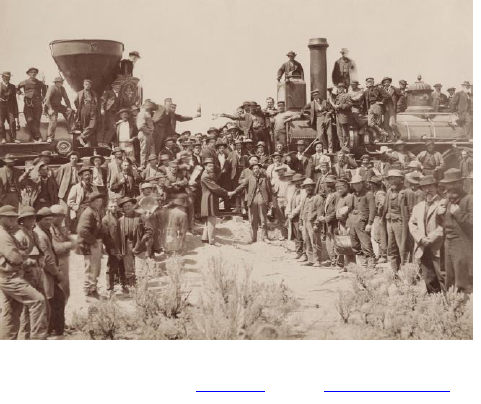
OUR LIVES: AN ETHNIC STUDIES PRIMER 80
After much violence and conflict, Americans
were ready to solidify their discrimination
into legislation. Beginning in the 1860s, many
laws were passed at local and state levels to
prevent Asian immigrants from economic
advancement. This eventually led to the
passage of the Chinese Exclusion Act of
1882, a piece of legislation that would
prevent Chinese immigrants from entering
the US for 10 years unless entering for
temporary stays related to business or
education. The Chinese were also banned
from obtaining naturalized citizenship, a law
that would be challenged later.
Perhaps even more damaging was the Page Act, passed in 1875, which banned Asian women
from entering the country because they were suspected of prostitution. This act had two
ramifications. First, there was the implication that Asian women were suspected of sex work or
corruption of society with promiscuity. Many lawmakers and others argued frequently at the
time that both Asian men and women posed a sexual danger to American society. Secondly, it
was very common for men to immigrate first, then send for the rest of their families. If wives
attempted to enter the country after their husbands settled in the U.S., they faced an additional
obstacle of being suspected of prostitution upon entry. Therefore, families were prevented
from uniting as a result of this act, and Chinese women were blanketed with the label of
promiscuity and sexual deviancy.
The Asians that were already in the country were treated with hostility and suspiciousness. The
first picture identification cards were carried by the Chinese to identify them as foreign. Law
makers in America then wondered, where do the Chinese and other Asians “fit” in society?
Should they be Americanized, assimilated, or educated?
Asian immigrants and Asian Americans tried to fit in, acclimate to American society, and
“become” American in a variety of ways. Methods included learning English, changing clothing
and cultural practices, marrying Americans, and more. Most importantly, Asian Americans
worked within the court systems in the U.S. to assert their civil rights. The following three cases
illustrate some key court battles.
U.S. v. Wong Kim Ark (1898)
Wong Kim Ark was an American born Chinese man. His parents were born in China, but Ark was
from California. In 1894, Ark took a trip to China to visit, and when he attempted to return to
his home in San Francisco, he was denied entry. Officials in California denied his citizenship
"East and West Shaking Hands at the Laying of Last Rail Union Pacific
Railroad Restoration" by Wikimedia is in the Public Domain, CC0
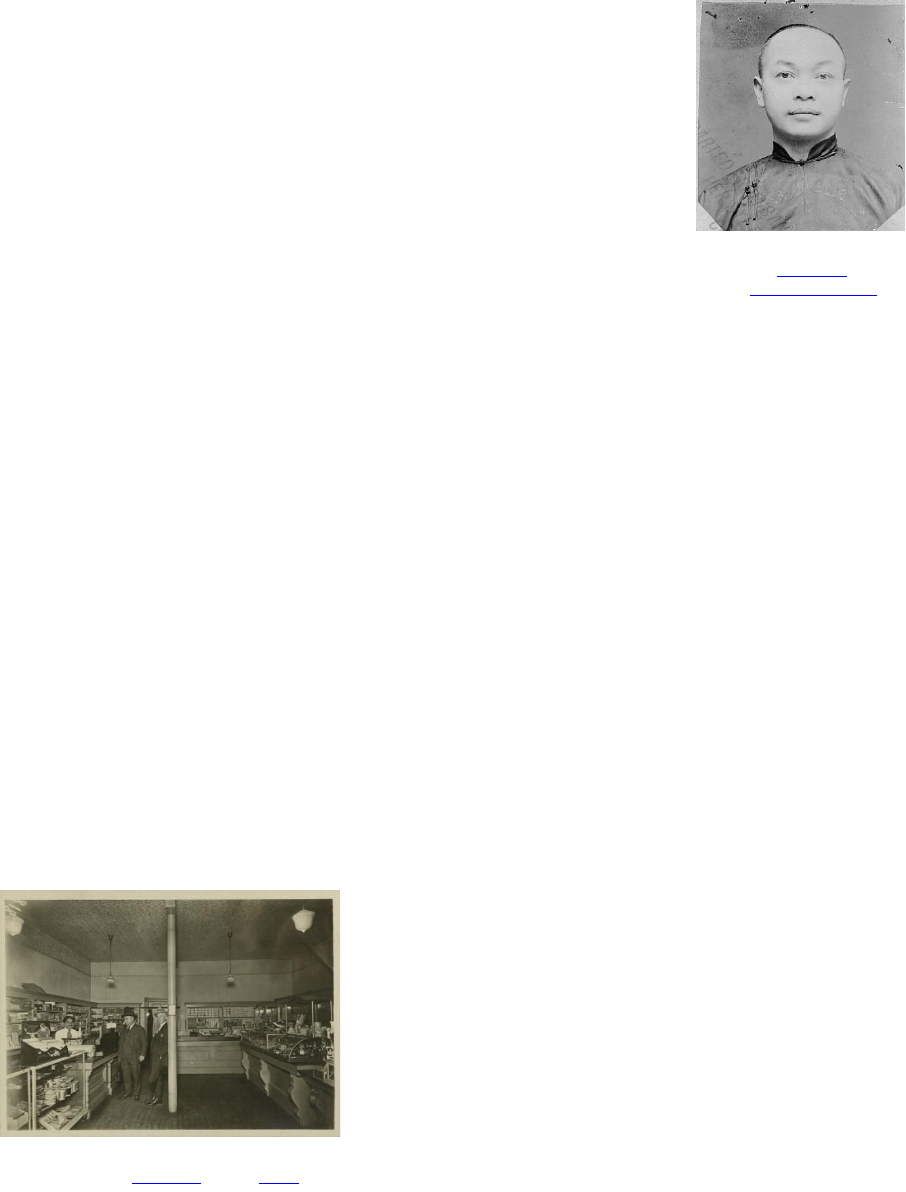
OUR LIVES: AN ETHNIC STUDIES PRIMER 81
because his parents were ineligible for naturalization under Chinese
exclusionary policies. After Ark’s case was tried before the U.S.
Supreme Court, the fourteenth amendment was upheld, granting
Ark birthright citizenship as being a native-born citizen. Ark’s case
was monumental and would serve as a precedent for birthright
citizenship, regardless of race from that point onward.
Ozawa v. U.S. (1922)
In the year 1922, one Japanese man decided to challenge the legality
of Asian immigrants being barred from the naturalization process
and American definitions of race. Takao Ozawa sought to claim his
rights and access to the American dream by attempting naturalization. Ozawa felt entitled to
the right, mainly by the basis of his success, contributions to society, and efforts to
Americanize. The most interesting argument was the color of his skin. It appeared “White” just
like many other American citizens. Ozawa attempted assimilation much like Italians and Irish
had in his recent past. He said, “I am not American, but at heart I am a true American.”
However, the courts declared against him, and the country would not see Japanese immigrants
achieve citizenship for many years after.
Thind v. U.S. (1923)
Bhagat Singh Thind was a high caste Indian man who arrived in America to attend university.
He served in the U.S. army during WWI and attempted to obtain citizenship. His naturalization
process was denied, on the basis of his “Hindu” status, despite the fact that he was Sikh. Thind
sued, on the basis that he was, in fact, Caucasian. This logic follows the anthropological
distinction that classified Thind as Caucasian, since his ancestors descended from the Caucus
mountains. The court ruled against him, and his citizenship was revoked, along with other East
Indians that had previously been granted citizenship.
As a result of this case, many other “non-White” persons
lost their citizenship. One of those men was Vaishno Das
Bagai. He escaped British tyranny in India and established a
successful business in San Francisco. He received his
citizenship in 1921, only later to have it revoked after the
Thind ruling. Bagai took his own life in 1928 and his suicide
note was published in the newspaper.
His words - “I came to America thinking, dreaming and
hoping to make this land my home…But now they come to
me and say, I am no longer an American citizen…Humility
and insults, who is responsible for all this? Myself and the American government. I do not
choose to live the life of an interned person: yes, I am in a free country and can move about
where and when I wish inside the country. Is life worth living in a gilded cage?”
"Wong Kim
Ark" by Wikimedia is in
the Public Domain, CC0
"Vaishno Das Bagai in His Store in San
Francisco" by Wikimedia is in the Public
Domain, CC0

OUR LIVES: AN ETHNIC STUDIES PRIMER 82
These three court cases prove that Asian Americans were continually denied a place in
American society, despite military service, economic status, or willingness to adapt to society.
This precedent continued into the later 20
th
century; even as American society diversified even
further.
GLOBAL CONFLICTS & THE 20
TH
CENTURY
As the U.S. propelled into the new century, so did their involvement in global affairs. We begin
at the turn of the century wherein many industrialized countries were participating in “new
imperialism,” efforts of colonization and imperialism in non-White countries. The U.S. was
involved in armed conflicts in the western hemisphere like the Spanish-American War which
ended in 1898 with U.S. control over Guam, Puerto Rico, and the Philippines. Freedom fighters
led by Filipino nationalist Emilio Aguinaldo rejected U.S. sovereignty having fought side by side
their American allies against the Spanish. This rejection prolonged the war, now fought
between the U.S. and Filipinos until 1902.
Colonization of the Philippines was characterized by President McKinley and other lawmakers
as a boon to Filipinos who were believed to be too uncivilized and savage for self-rule. It was
these same principles that continued to prevail foreign policy throughout most of the first half
of the 20
th
century.
World wars during the 20
th
century brought Americans together with an abundance of national
pride and duty to the country. At times, war also evoked feelings of anxiety and xenophobia to
the nations involved in the conflict. World War II is one of those times.
Just before the winter of 1941, there were about 125,000 people of Japanese descent living in
America, most of them in west coast regions. Pearl Harbor was a U.S. naval station in Hawaii
that was the victim of a surprise attack by the Japanese on December 7, 1941. This attack
resulted in mass American casualties and was too close to the mainland for officials. As a result,
APPLICATION 5.1
SHIFTING PERSPECTIVE: SELF-DETERMINATION
Goal
To appreciate the perspective of the colonized peoples of the Philippines.
Instructions
Read Aguinaldo’s Case against the United States
(http://nationalhumanitiescenter.org/pds/gilded/empire/text9/filipino.pdf). Answer the following questions:
1. What is Aguinaldo’s goal in this document? Is he clear in his message?
2. What reasons does Aguinaldo argue for Philippine self-governance?

OUR LIVES: AN ETHNIC STUDIES PRIMER 83
Americans stepped up their involvement in the war, and
in February of 1942, President Roosevelt issued the
Executive Order 9066. This order authorized the
militarized internment of all “persons of Japanese
ancestry” residing in the western regions of the U.S. The
justification was that Americans suspected that anyone of
Japanese ancestry could still have loyalties to their ethnic
homelands and would practice espionage. There was little
to no evidence to support this concept, nevertheless,
many supported this order and about 110,000 Japanese,
many of them citizens and American born, many of them
children, were put into internment camps.
Forced internment caused almost $2 billion in property loss and even more in income loss for
those interned. Internment lasted until the end of the war, and some even remained in the
camps post-war because they no longer had homes to return to, for they were repossessed by
authorities. It was not until the 1980s when the U.S. government paid restitution to the families
that were affected in the amount of $20,000 per Japanese American families that were
interned.
NEW IMMIGRANTS & EXPANSION OF DIVERSITY
The end of World War II brought the U.S. a new role on the global stage. The use of nuclear
weapons in Hiroshima and Nagasaki to end the war made the U.S. the most powerful country in
the world, while also causing mass death and destruction in the name of democracy. The
paradox of these two concepts conveyed a conflict in American ideology.
In order to maintain the moral high ground, the U.S. passed new immigration policies in 1952,
revising earlier immigration quotas of the 1920s. This act loosened some restrictions on Asian
APPLICATION 5.2
SHIFTING PERSPECTIVE: JAPANESE INTERNMENT
Goal
To realize the perspective of a young Japanese woman during the internment process.
Instructions
Read Aiko Herzig-Yoshinaga on Japanese Internment
(http://www.americanyawp.com/reader/24-world-war-ii/aiko-herzig-yoshinaga-on-japanese-internment-
1942-1994/). Answer the following questions:
1. Define Japanese internment.
2. Describe Herzig-Yoshinaga’s journey to the camp. What is her tone?
3. How would you describe her understanding of internment?
"Japanese American Owned Grocery Store
Oakland California March 1942" by Wikimedia is
in the Public Domain, CC0
OUR LIVES: AN ETHNIC STUDIES PRIMER 84
nations to immigrate to the U.S., and also made naturalization possible for Japanese, Korean,
and Chinese immigrants, but only from these countries of origin.
The next decade brought milestones for racial minorities. These changes included legislation,
social movements, and community activism that remade Asian Americans for the next few
decades.
First, the legislation that passed broadened the definition of Asian American and dramatically
diversified America. This was the Immigration and Naturalization Act of 1965, also referred to
as the Hart-Cellar Act. The act overturned previous legislation that granted entry into the
country based on national origin. Instead, the act created preference for highly skilled
immigrants and ones that already had family in the country. Policymakers did not anticipate
the impact of this legislation. Immigration rates increased dramatically, and many of those
immigrants came from Asian countries.
Next, as the Civil Rights movement propelled equality forward for African Americans, the same
call for equality was inspired in many other groups. Asian Americans took to the streets just as
other racially minoritized groups demanding for equality. Asian Americans like Grace Lee Boggs
participated in marches for equality on behalf of African Americans, then turned to inspire
Asian communities to do the same. Philip Vera Cruz was a Filipino American who was active in
promote fair labor practices for farmers in California and was instrumental in Cesar Chavez’s
protest movements in Delano, California. Asian Americans formed a pan-Asian coalition
nationwide of Asians that would reject discriminatory labels like “Oriental” and “yellow,” and
demand equality on all fronts for Asian Americans. Like many other minoritized groups, in an
effort to reclaim a once derogatory term, supporters of Asian American rights claimed Yellow
Power in their rhetoric.
Although the label of “Oriental” is now largely understood as inappropriate, another more
nefarious label was applied to the Asian community, one that has very complex ramifications.
This is the label of “model minority.” The concept of the model minority characterizes Asians as
obedient, law-abiding, and submissive to authorities (Thrupkaew, 2002). It also uses three types
of Asians, the Chinese, Japanese, and Korean as prime examples of what a successful immigrant
should be. These three groups have had their hardships but have been able to become
successful in the U.S. and statistically held jobs with higher wages and did not rely on
government programs. This concept created much tension between minority groups as well as
within the Asian community itself.
First, the model minority paradigm was created to juxtapose the perceived success of Asians
against the perceived failures of other persons of color like African Americans and Hispanic
Americans who were reliant of government programs and assistance at higher rates. By
upholding the Asian community as “model minorities,” the accusation on other ethnic groups
was a questioning on why they also could not live up to those standards.
OUR LIVES: AN ETHNIC STUDIES PRIMER 85
Secondly, the model minority term created tensions between Asian Americans. Japanese,
Korean, and Chinese immigrants had a longer history of emigrating into the U.S., and as a result
were second and third or more generations of wealth by this point. Additionally, by the 1950s,
preference was given to highly skilled Asians who were of these three groups to enter the
country, providing a solid economic foundation from the start. And lastly, these three groups
reflect a clear bias of colorism, for decedents from these groups tend to be lighter complected
than newer immigrants and refugees post 1965. All of these factors created tension and
resentment between Asians who either benefitted from the label or were disadvantaged as a
model minority.
Although the 1960s brought a push for social change in America, equality continued to be an
uphill battle for Asian Americans. Further social conflicts around the globe like the Vietnam War
and human rights crises brought even more Asians into the U.S., but this time as refugees.
Southeast Asian groups like Vietnamese, Laos, Cambodian, and Hmong immigrants came to the
U.S. and were received with fear and suspicion that heightened tensions in some pockets of the
nation. Waves of new immigrants typically bring fears to Americans who anticipate a strain on
resources that directly affect their livelihoods. These tensions will sometimes erupt in violence
as they did in two separate cases during the 1980s.
The 1980s brought an economic downturn that inflated the sense of limited community
resources and employment. This anxiety is best exemplified with the murder of Vincent Chin, a
Chinese man who lived in Detroit, Michigan. Economic strain was felt in blue collar jobs in this
city, mainly the automobile industry. Chin was coming home from his bachelor party when he
was beaten to death by two White men who claimed he was a “Jap” that was taking jobs away
from Americans. These men plead guilty, but received no jail time, only probation with a $3,000
fine.
In Stockton, California, at the end of the decade, 1989, another heinous act motivated by
racism occurred. This Stockton school shooting marked the deadliest school shooting with the
highest number of fatalities and injuries until Columbine in 1999. A White man used an AK-47
to enter Cleveland Elementary School of predominantly Asian American children and opened
fire. He shot 34 people and killed 5 that were between the ages of 6 and 9. This elementary
school was known to have been attended by mostly Asian students, many of them refugees
from Southeast Asia. Of those children killed, all of them were Asian.
THE RECENT PAST
By the 21
st
century, bias and discrimination continued as a result of the historical racial
discrimination of the previous decades. The model minority myth continues to be the way in
which most Americans view the Asian American community. While there is some truth to the
success of select Asian American groups that reside in the U.S., still many reportedly experience
racial discrimination and hate crimes even to this day.

OUR LIVES: AN ETHNIC STUDIES PRIMER 86
By 2020, a global pandemic made the fears and anxieties of many Americans manifest in
different ways, amplified, and proliferated by the internet and social media. Known as COVID-
19, the virus that is believed to have originated in China has affected the Asian American
community in terrible ways. Since the beginning of the pandemic, Asian American Pacific
Islanders (AAPI) have reported countless acts of violence against Asians every day. These acts of
violence range from calling names, spitting in faces, to physical violence reigned down mostly
on the elderly.
Perhaps one of the more significant acts of violence occurred in Atlanta, Georgia in 2021. This
incident involved a White man entering into a spa and shooting at its occupants. Eight people
were killed, six of them Asian women. The shooting was the alleged result of the shooters
Christian faith at odds with his sex addiction. However, the shooting exemplified another
incident of anti-Asian sentiment following the tensions of the pandemic. The incident sparked
protests in multiple cities against anti-Asian violence that were being reported across the
country.
In the 21
st
century, Asian Americans remain the most ethnically diverse, rapidly growing ethnic
groups in America. The Democratic Presidential nominee campaign of Andrew Yang put a
prominent Asian at the forefront of American politics. A Korean foreign language film, Parasite,
won Best Picture at the Academy Awards with overwhelming praise. These are signals that
Asian Americans are not only active and prominent members of society but have even more
room to grow in the coming years.
BIOGRAPHICAL REFLECTION 5.1
SOUTHEAST ASIAN REFUGEES
When Southeast Asian refugees from Cambodia, Laos, and Vietnam started to flow into American cities starting in
1976 and into the 1980s, most Americans didn’t know who we were, much less what we had gone through before
coming to the United States. In many ways, we were hoping no one would know who we were. Our neighbors
thought we were Chinese or Japanese – after all, all Asians look alike to them, and so we must be the same. “Are
you Chinese? Are you Japanese?” they asked. We knew English enough to know those questions were about who
we were, but we shook our heads, saying, “No, no.” And perhaps we could’ve told our neighbors that we were
Hmong, but it would be too difficult to explain why we came to the United States. Silence was the better choice.
Another generation had to be immersed in the English language and culture before we could tell our story. Our
story of survival and resilience and collaboration with the U.S. to fight communists simply had to wait. Among first-
generation SE Asian college students, we felt the need to capture our own respective lived experiences from our
own lenses rather than waiting for another non-SE Asian person to give us another watered-down version of our
plight. Young scholars from the Cambodian and Vietnamese communities had already documented their own
refugee experiences through various publications in recent years. In my case as a first-generation Hmong college
student and now a professor of political science and ethnic studies, I’m compelled to provide my own version of
the Hmong plight to the U.S. and secondary migration to the Central California.
Community and social dialogues among Hmong elders revealed that the first few Hmong families to move to the
Central Valley, California started in Merced in 1979. From those families, words got around to relatives across the
country – wherever resettlement agencies had scattered us (Massachusetts, Rhode Island, Ohio, Tennessee, or
Oklahoma) – that California’s Central Valley had fertile land for farming, the only method the Hmong had been
familiar with in making a living. We came from the mountainous terrains in Laos but found the flat valley

OUR LIVES: AN ETHNIC STUDIES PRIMER 87
attractive, serving as a magnetic device that continued to pull Hmong families across the country to start their new
lives in Merced and Fresno. This massive secondary migration of Hmong refugees to the Central Valley caused
social workers to accuse the Hmong of taking advantage of the generous California welfare system. In 1985 the
welfare dependency among the Hmong was about 75%. Our big families of 6.9 children in 1986 received more
welfare cash aid than a father working $4.25 an hour minimum wage job.
Though small in number, Southeast Asians in Cambodia, Laos, and Vietnam played a pivotal role in the Cold War,
international political power jostling between the United States and the Soviet Union. For fifteen years from 1960
– 1975, Americans read in newspapers and saw the disaster of the Vietnam War unfolded on television. The
political quagmire that engulfed Southeast Asia expanded over three presidential administrations – Kennedy,
Johnson, and Nixon - became a permanent scar on the American consciousness, a hefty price to pay both in human
lives and money (more than 58,000 dead and over 300,000 wounded and $168 billion - $1 trillion in today’s
money.)
In part this American foreign policy (communist containment) in Southeast Asia was the core of the United States’
response to communist expansion in Asia at large. In 1949, China turned communists with Mao Zedong’s victory
over the Nationalist Chinese forces. A year later with the support of the Soviet Union and China, communist North
Korea invaded democratic South Korea. The conflict ended in an armistice in 1953. In Southeast Asia, the three
French colonies Cambodian, Laos, and Vietnam were vying for their respective independence from France
beginning in 1945. Subsequently, Cambodia and Laos were granted independence in 1953 without military
conflicts. However, France would not relinquish the same to Vietnam until it was militarily defeated at the battle
of Dien Bien Phu by the Vietnamese nationalist Viet Minh in 1954. The United States orchestrated the Geneva
Accord of 1954 to divide Vietnam into two countries – North Vietnam, communist controlled and South Vietnam,
democratic. This strategy of using South Vietnam as a buffer zone to protect Thailand and Burma was part of the
“domino theory” hysteria that if one country fell to communists, then the neighboring one will also fall, and then
the one after.
Peace in Southeast Asia proved fragile as the power vacuum created by the departure of France resulted in the
monarchies in Laos and Cambodia too unstructured to govern. Accusations of corruption and other internal
conflicts ensued, creating ideological factions that could not come to political consensus. The Geneva Accord of
1962, an international agreement to establish Cambodia and Laos as neutral countries, meaning they supported
neither communism nor democracy, and there were to be no foreign troops in Laos or Cambodia. But this
agreement simply proved its own ineffectiveness. The regional powers like China and North Vietnam and the
superpower of the Soviet Union and China never adhered to the terms. North Vietnam infiltrated to Laos and
Cambodia through the Ho Chi Minh Trail that cut through eastern Laos, bordering North Vietnam and South
Vietnam. Under the Kennedy administration, the CIA secretly recruited democratic leaning Hmong, Lao, and other
indigenous hilltribes to fight the North Vietnamese communists on the Trail. Leading this effort was a Hmong man
named Vang Pao, also known as General Vang Pao, who rose to prominence as a freedom loving fighter and
staunch American ally. The primary duties of the Hmong under his command were to: 1) disrupt the flow of
supplies to South Vietnam, 2) rescue downed American pilots, 3) provide strategic intelligence on enemy
operations, and 4) guard satellite installations. The Hmong became the sacrificial lamb in America’s secret war to
contain communists by paying with 10% of its population in Laos – 30,000 dead among 300,000.
The calamity of American foreign policy in Southeast Asia created one of the largest exoduses of refugees out of
Cambodia, Laos, and Vietnam. People who had sided with the American effort were targeted for reprisals by
communist forces after the war. About 200,000 Cambodians fled the terror of their own countrymen, the Khmer
Rouge, which was responsible for killing over 2 million of its own population. In Laos nearly 300,000 Hmong,
lowland Lao, Mien, Khmu, Lahu and other hilltribes made their own escapes to neighboring Thailand. Over a
million Vietnamese fled South Vietnam to the Philippines, Indonesia, and Singapore. This tragedy of constant
refugees fleeing persecution continued into the mid 2000’s, but politically speaking, people who fled Cambodia,
Laos, and Vietnam after 1991 were no longer categorized as refugees.
This story “Southeast Asian Refugees” by Silas Cha is licensed under CC BY NC ND 4.0

OUR LIVES: AN ETHNIC STUDIES PRIMER 88
SUMMARY
Like previously covered groups, people of Asian descent have been present in the Americas
since the 16
th
century. Peoples from Asia have typically been regarded as perpetually foreign,
admired for their exoticism, but devalued as too otherworldly. Asians have struggled to be
accepted amongst American society, despite their contributions of labor, military service, and
wealth. Even when utilizing the justice system to assert their civil rights, Asians were met with
opposition and oppression. Regardless of their rejection, Asian Americans forged a place for
themselves in American society, growing in number and influence as one of the most diverse
and fast-growing groups in the U.S. today.
REVIEW QUESTIONS
1. How did people of Asian descent make their way to the Americas during the colonial
period?
2. How were Asians generally received during the 1800s?
3. Explain some of the ways Asians attempted to assimilate into American society?
4. What political policies of the 20
th
century impact Asian Americans?
5. What kinds of racial discrimination did Asian Americans endure after WWII?
6. How did Asian Americans assert their civil rights during the 1960s and 70s?
TO MY FUTURE SELF
From the module, what information and new knowledge did I find interesting or useful? How
do I plan to use this information and new knowledge in my personal and professional
development and improvement?
REFERENCES
Fadiman, A. (1997). The spirit catches you and you fall down : a Hmong child, her American doctors,
and the collision of two cultures (1st ed.). Farrar, Straus, and Giroux.
Foner, E. (2014). Voices of freedom: A documentary history: Volume 1. (4
th
ed.). W.W. Norton &
Company.
Foner, E. (2014). Voices of freedom: A documentary history: Volume 2. (4
th
ed.). W.W. Norton &
Company.
Hamilton-Merritt, J. (1993). Tragic mountains: the Hmong, the Americans, and the secret wars for
Laos, 1942-1992. Indiana University Press.
Lee, E. (2015). The making of Asian America: A history. Simon & Schuster.

OUR LIVES: AN ETHNIC STUDIES PRIMER 89
Locke, J. & Wright, B. (2019). The American yawp. Stanford University Press.
http://www.americanyawp.com/index.html.
Rothenberg, P. S. (2016). Race, class, and gender in the United States: An integrated study.
(10
th
ed). Macmillan.
60 Minutes. (2015 August 13). Hmong Our Secret Army. [YouTube].
https://www.youtube.com/watch?v=L4U2P7tsOAQ
Takaki, R. (1993). A different mirror: A history of multicultural America. Back Bay Books.
OUR LIVES: AN ETHNIC STUDIES PRIMER 90
MODULE 6. OUR STORY: LATINX AMERICANS
LEARNING OBJECTIVES
At the end of the module, students will be able to:
1. describe the process of exploration, contact, and colonization of Spanish explorers in the Americas.
2. explain Manifest Destiny and the American acquisition of land through war and conflict.
3. explore the role of Latinx peoples in America during WWII and after.
4. describe the contributions of progress of Latinx Americans during the civil rights era
5. explore the issues of the late 20
th
and early 21
st
century and how they have impacted Latinx
Americans
KEY TERMS & CONCEPTS
Adams-Onis Treaty
Bracero program
California Gold Rush
César Chávez
Christopher Columbus
Colonial Caste System
Conquistadors
Farmworkers Movement
Hart-Cellar Act of 1965
Hernandez v. Texas
Iberians
League of United Latin American Citizens
Manifest Destiny
Mendez v. Westminster
Mestizo
Mexican American War
Monroe Doctrine
Mulatto Operation Wetback
Pachuco movement
Reconquista
Roosevelt Corollary
Spanish-American War
Treaty of Guadalupe Hidalgo
Young Lords
Zoot Suit Riots
INTRODUCTION
Latinx Americans have one of the more complex histories of the development of the Americas.
Through contact, colonialization, and further political and social dynamics, the Latinx
population has grown into a sizable and influential part of the United States today.
Like other racial minorities, Latinx Americans have been exploited for their labor, discriminated
by American society, and denied their civil rights despite their contributions to the nation. The
Latinx identity is not considered a ‘race’ in America, but rather an ethnic distinction. Because of
this ambiguous categorization, Latinx Americans have been misunderstood in political and
social standards throughout history.
This is their story.
OUR LIVES: AN ETHNIC STUDIES PRIMER 91
INDIGENOUS PEOPLES & COLONIZATION
In order to understand Latinx history, we have to begin with the indigenous peoples of the
Americas, whose history is inextricably tied to Latinx history. As stated in Module 2, the peoples
of the Americas traveled across the Bering Strait and migrated down the continents to lay their
roots throughout the Americas. Over time, they constructed boats and continued to develop
island civilizations in the Caribbean as well. The peoples of the Americas adapted and thrived in
the environments where they settled, some creating vast and complex civilizations and even
empires.
When Iberians, the Portuguese and Spanish Europeans that lived on the Iberian Peninsula,
started to venture out into the open ocean, they would eventually make their way across the
Atlantic. The Portuguese focused on the formation trading outposts rounding the gold coast, as
well as the colonization of Africa’s western coastal islands, while the Spanish funded a
monumental journey that made landfall in the Caribbean. This was the journey of Genoese
born Christopher Columbus.
After Columbus’s contact with indigenous peoples, more and more explorers made their way
across the Atlantic Ocean. Among those men were Hernan Cortez and Francisco Pizarro.
Through the efforts of political maneuvering, brute warfare, and subsequent disease, Iberian
conquistadors dominated the powerful empires of the Americas. These men were named for
their participation in the Reconquista, or reconquest of Spain which was once ruled by Muslims
during the middle ages. Cortez and Pizarro identified two goals: control the land and establish
colonies for the benefit of the mother country and convert the natives to Christianity. The more
souls they committed to Christianity, the more powerful they became over Muslims. With these
goals in mind, the Americas were changed forever.
As Iberians took over the Americas, some sought alliances with powerful families of the
remnants of the indigenous empires. These alliances were mostly forged through marriage.
Society was further changed by the introduction of African servants and slaves. Over time, the
intermarriage of peoples created a complex and vast Colonial Caste System, or Las castas, that
gave privilege and preference to European blood and ‘white’ skin tone. Categories of Las castas
included mulattos, offspring of a Spaniard and African, or mestizos, a child of a Spaniard and an
indigenous person.
These definitions determined one’s social status and access to opportunities and resources or
lack thereof. Like many other areas of the world, lighter skin tone was preferable and
privileged, while darker skin tones meant inferiority and discrimination. As the years went on,
the Latin American nations such as Mexico, Puerto Rico, and Cuba were formed using these
racial and ethnic distinctions.
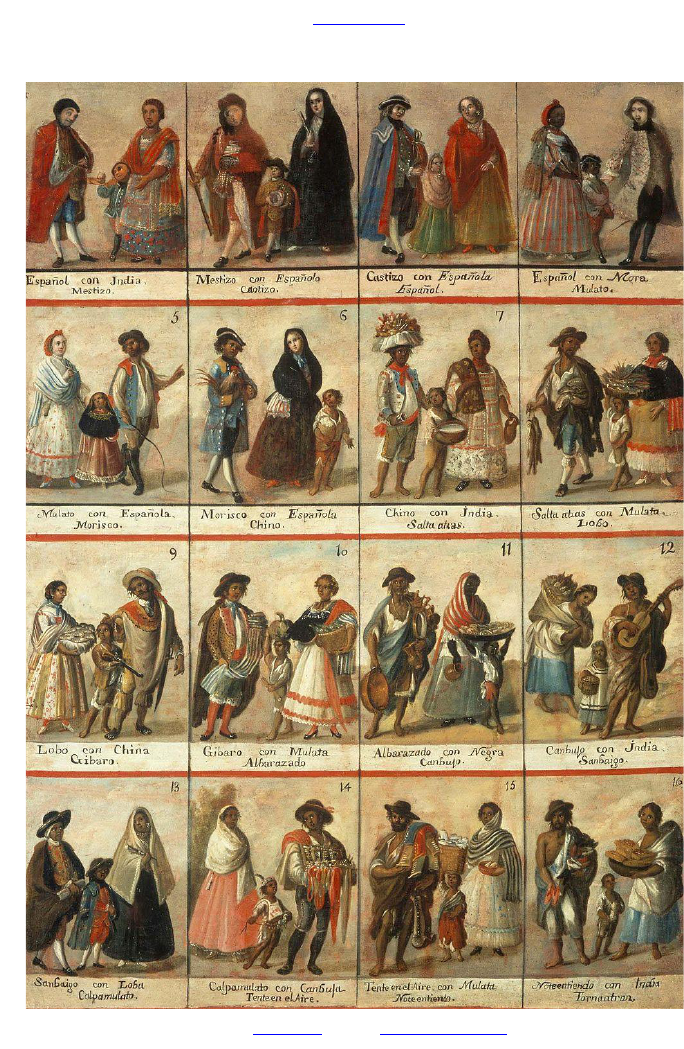
OUR LIVES: AN ETHNIC STUDIES PRIMER 92
Las castas
Casta painting showing 16 racial groupings
18
th
century, Museo Nacional del Virreinato, Tepotzotlán, Mexico
WESTWARD EXPANSION & WARFARE
During the colonial development of the U.S., the Spanish continued to establish settlements
throughout their territories in the Americas. In North America, of the areas that would
eventually become the U.S., the Spanish controlled the west, southwest, and Florida, until
about the early 19
th
century. Spanish speakers were, in fact, some of the earliest settlers of
"Las Castas" by Wikimedia is in the Public Domain, CC0
OUR LIVES: AN ETHNIC STUDIES PRIMER 93
North America, and would remain strongly rooted in those regions throughout this nation’s
history – and even today.
After the American Revolution and the founding of the nation, settlers looked to the west for
more room to develop and grow. The land lust of the American settlers was felt by many
groups, and among those groups perhaps the ones to have been affected most were Native
Americans and Latinx populations. This land lust was justified in the notion of Manifest Destiny,
a term covered in more detail in Module 2.
The control of lands from the Atlantic to the Pacific began first with Florida, which was acquired
by John Quincy Adams through the Adams-Onis Treaty in 1819. The treaty was signed to settle
a border dispute with Spain and an ongoing conflict with General Andrew Jackson and his
invasion of Florida and attack on the Seminole Indians. This military action by Jackson was used
as leverage over the Spanish to demand Minister Onis to control the inhabitants of Florida or
cede the region to the United States. The Seminole tribe was considered disruptive to U.S.
interests because they had a history of harboring fugitive slaves. As discussed in Module 3,
enslaved African Americans were considered property of Americans, and therefore the
Seminoles were in possession of stolen property. The treaty settled differences between the
nations by Spain ceding control of all of Florida and the Pacific Northwest, while the U.S.
recognized Spanish control over the region later known as Texas, clarifying the borders
between New Spain and the United States.
Americans soon after reneged on their promise to respect their western boundaries. By the
1820s, American farmers of the south had continued to press into western regions, growing
and expanding their wealth despite what sovereign nation controlled the land. The year of 1821
was a victorious one for Mexico, for it gained its independence from their Spanish colonial
masters much like Americans did in 1783. However, in forming their new nation, the Mexican
government worried about their northern territories and the American influence that resided in
them. The fledgling nation tightened its grip on their nation by instituting laws that would
weaken the American investment farmers in the north. This legislation included the building of
military forts, increasing taxes on foreigners, the abolition of slavery in 1829, and the barring of
immigration across the northern border in 1830. All these actions were meant to weaken and
dismantle the American influence in northern Mexico, but instead the Americans pushed back.
The path the Americans chose was in line with Manifest Destiny and the American ethos of
resistance. Instead of complying with the Mexican government, Americans allied with the
remnants of Spanish elites and waged a revolution against Mexico. The Texas Revolution lasted
several months, and in the end, Texas gained its independence from Mexico and operated as its
own independent nation from 1836 until the U.S. annexed the region in 1845. The Americans
continued to till their lands with the use of slave labor as an independent territory and into
1860.
After Texas entered the Union, President James K. Polk set his sights towards the west, again in
line with the concept of Manifest Destiny. In November of 1845, a diplomat was sent to Mexico
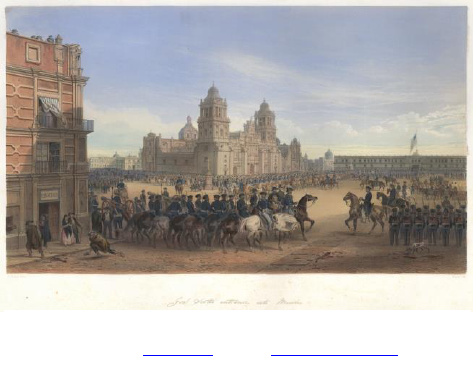
OUR LIVES: AN ETHNIC STUDIES PRIMER 94
to offer to buy the western territories from Mexico, and the offer was denied. But the U.S.
government was relentless, and instead of cutting their losses, they claimed a border dispute to
settle the matters with war. President Polk stationed a military force of 4,000 men at the
disputed border line, and the Mexican government responded with its own military force.
When tensions erupted and shots were fired, Americans were killed. Polk used this opportunity
to declare war on Mexico, and Congress granted his request. The Mexican American war had
begun.
The Mexican American War was a very short-lived war, officially beginning in the fall of 1846
and only lasting about four months. The Americans had the advantage of attacking from both
land and sea and quickly came to occupy the capital city of Mexico. During this occupation of
Mexico City, the Treaty of Guadalupe Hidalgo was signed. This treaty ceded about half of
Mexico territory to the U.S.; territory that would eventually become California, Utah, Nevada,
Arizona, Colorado, and Wyoming. This vast acquisition of land would have thousands of
Mexicans faced a choice of leaving their land and homes to move within the new borders of
their nation or remaining where they were to become Americans. Approximately 30,000
Mexicans would stay and represent the bulk of Latinx Americans for many years, all having to
adapt and mold into American society as many more would do in the years thereafter. In their
efforts to adapt and assimilate into American society, they would find themselves faced with
harsh discrimination, particularly in politically charged territory like California.
After the acquisition of land from Mexico,
Americans had fulfilled their goal of Manifest
Destiny – they now controlled North America
from the Atlantic to Pacific coasts. The
consequences of achieving that goal were
high, for civil war was brewing. One event
that accelerated the coming war came with
the process of settlement of new territories,
namely the state that would become
California. When the precious metal known
as gold was discovered in California, a rush of
eager migrants flooded into the territory
during the California Gold Rush to extract
the wealth that the land had to offer. As countless migrants descended on the land, a certain
lawlessness was experienced by those settlers, provoking a need for structure, government,
and order. Lawmakers identified a need for order and rushed into annexation and statehood.
However, the delicate balance of free and slave states needed to be maintained, so a political
compromise settled matters, formally called the Compromise of 1850. This negotiation
contained several different concessions to satisfy differing political interests, including
California accepted as a free state into the Union.
During the Gold Rush beginning in 1848, and the establishment of a California state
government, most non-White residents were given little consideration and rights. Generally,
"Nebel Mexican War 12 Scott in Mexico City Adolphe Jean-Baptiste
bayot" by Wikimedia is in the Public Domain, CC0
OUR LIVES: AN ETHNIC STUDIES PRIMER 95
white California residents treated once Mexican citizens with disdain as they would treat most
racially minoritized groups in California like the Chinese and the Native Americans.
As the American Civil War raged on through the 1860s, many of society’s issues were put on
hold, including Latinx American labor issues and gold rush conflicts in California. From the time
of land acquisition to the 20
th
century, the southern border remained relatively open, and
migrants openly crossed to look for work when needed. Spanish speakers from Latin America
were welcomed with the same xenophobia as many other migrants of the late 19
th
century, but
many only stayed for temporarily for work, and returned home.
After the War of 1812, the U.S. had beaten the British a second time, and established itself as a
fully formed nation on a global stage. Just a few years after, James Monroe issued the Monroe
Doctrine, a U.S. policy that took a stand against any attempts at European colonialism in the
Americas – North, Central, or South. Later, Theodore Roosevelt upheld this same policy, and
reiterated the U.S. strongarm on the Western Hemisphere and the defense of any Latin
American country. This policy was called the Roosevelt Corollary; and using this policy, the U.S.
government intervened in many foreign affairs in countries like Venezuela, Panama, and Cuba.
Under the guise of these policies, the U.S. intervened in various political conflicts throughout
Latin America in the 19
th
and 20
th
centuries. As some of these Latin American regions
attempted to assert their independence from their colonial oppressors, regions like Cuba found
support from their American counterparts. The Cuban Liberation Movement in Cuba was
supported by a newly formed Cuban Solidarity Movement in the U.S. This movement identified
the themes of liberation in Cuba similar to the abolition of slavery. (Ortiz 2018). Through their
efforts, the plight of Cubans gained more awareness in America, leading to U.S. intervention in
1898.
The Spanish-American War of 1898 found the U.S. involved in an armed conflict that eventually
helped Cuba gain its independence from Spain. This was a short-fought conflict that ended with
the signing of the Treaty of Paris, wherein Spain ceded control of several territories including
Puerto Rico, Guam, and the Philippines. To this day, Guam and Puerto Rico are unincorporated
territories of the U.S., meaning residents of the countries are American citizens but do not pay
federal taxes or have voting representatives in Congress.
By the 1910s, Mexico was suffering national strife during the Mexican Revolution. This conflict
brought many Mexican nationals across the border looking for safety and opportunity, much
like other migrants in the previous decades. This was an unwelcome shift for Americans that
were used to temporary migrant laborers of the past. These settlers looking for permanent
residences were met with harsh xenophobia. Many of the new migrants settled down in the
southwest and California to work in expanding agricultural territories of Arizona, California, and
Texas. This huge influx of migrants spawned a need for border control, which began in 1924.
As a counterweight to the racial discrimination of the 1920s, an organization was founded to
defend Latinx peoples from institutional discrimination. LULAC, or the League of United Latin

OUR LIVES: AN ETHNIC STUDIES PRIMER 96
American Citizens, was formed in Texas and sought to end discrimination against Latinx
Americans. In a LULAC newsletter, the writer blamed “ignorance” for the treatment of Latinx
communities. For example, one of their earliest high-profile cases was to sue a school district in
1930 for segregation of Mexican children; however, the case did not rule in their favor. This
case would serve as an important steppingstone for a similar lawsuit in the 1950s.
LABOR & CIVIL RIGHTS
World War II opened new avenues of opportunity for ethnic minoritized groups like Latinx
Americans. Approximately 400,000 to 500,000 Hispanic and Latinx Americans fought in the war.
This number varies by the source because of misrepresentation or underrepresentation of
groups like Afro-Latinos. Like most veterans that are people of color, they were treated badly
upon return. Many were not allowed the benefits of the GI Bill, and others returned to
hometowns that enforced segregation, despite service to their country.
Like many minoritized groups during this era, like women and Blacks, Hispanics and Latinx
Americans found new employment opportunities due to shifts in the workforce. Better paying
factory jobs drove many racial minorities into cities. Some gained employment in industrialized
jobs making uniforms, bullets, planes, etc.
The shifts in the labor force also created a desperate need for agricultural workers. In solidarity
during wartime, the U.S. government and the Mexican government signed a deal called the
Bracero program. The program was used to bring Mexican agricultural laborers into the U.S. for
work while guaranteeing them fair wages, adequate shelter, and food. This initial agreement
was meant for wartime but was extended until 1964. The agreement sounded great on paper,
but in practice had many issues. There
were many accounts of “adequate” living
conditions that were substandard at best,
and numerous accounts of racial
discrimination. Wage discrepancies,
withheld pay, or inconsistent pay were
common among Bracero workers. The
workers had no say in the negotiations of
labor contracts and were virtually
powerless in the process from the
beginning. Furthermore, even though the
program was extended several years,
Bracero workers were never given a pathway to citizenship. The whole program was
inconsistent, unfair, and at times outright abusive. In 1954, after the director of the INS became
alarmed by the presence of Mexican laborers in southern California, he initiated “Operation
Wetback,” a program to deport illegal immigrants to Mexico. This initiative ignored the fact
that many of these farmworkers came legally under the Bracero program, and some of those
deported were American citizens.
"An Official Examines a Bracero's Teeth and Mouth with a
Flashlight" by Wikimedia is in the Public Domain, CC0
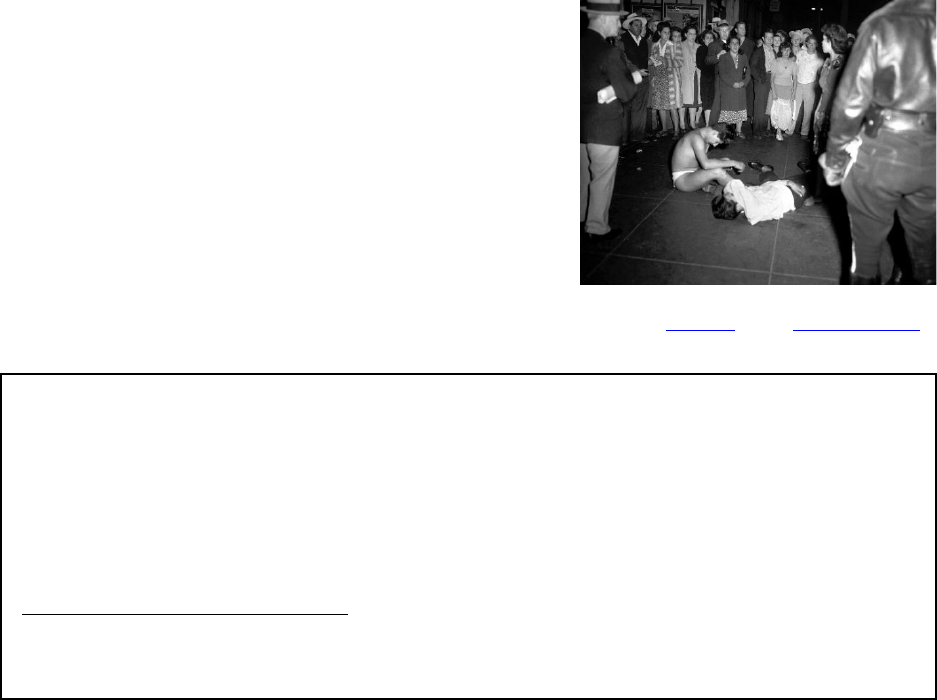
OUR LIVES: AN ETHNIC STUDIES PRIMER 97
Meanwhile, as the Bracero workers were being mistreated in the west and southwest, Los
Angles found itself in an incident of racial conflict during the Zoot Suit Riots. WWII was a global
conflict that had vast effects on the home front in America, including stoking racial tensions in
areas like southern California. Discrimination against Latinx communities is a concept that was
common in the region even before it was a state. This all came to a head because of rationing
during the war.
A Zoot Suit was a type of suit that was popularized during the Harlem Renaissance. The suit
included an oversized jacket with coat tails, large voluminous pants with pegged ankles,
sometimes a watch chain and two-toned shoes. This look was later co-opted by the Mexican
youth of the Los Angeles area. This youth culture was called the Pachuco movement.
Both young men and women participated. However, to wear a zoot suit during war time and
rationing was frowned upon because of its excessive fabric; and this, coupled with rising racial
tensions in the area soon erupted into violence. Although many Pachucos wearing zoot suits did
not fabricate or purchase them during wartime, thereby
violating rationing laws, they were still targeted as being
unpatriotic and un-American.
The origin of the riots is hard to pinpoint, but the initial
act was connected to some young Pachucos and navy
servicemen in Los Angles. Because the city had a military
base nearby, there were often military servicemen
present. The initial altercation sparked a reaction of
vengeance by those in the area, and havoc was set upon
anyone in a zoot suit or who appeared to be part of this
Pachuco culture.
Men, many of them enlisted men, packed into cars to descend upon the Latinx barrios of Los
Angles to hunt down Zoot Suiters. The attackers used bats, chains, and other weapons to assail
these young Pachucos. When the police were called, the ones put in jail were often the victims
APPLICATION 6.1
SHIFTING PERSPECTIVE: ZOOT SUIT RIOTS
Goal
To view the riots from the perspective of the Latinx community.
Instructions
Read We’re Looking for Zoot-Suits to Burn”: Mexican Americans and the Zoot Suit Riots
(http://historymatters.gmu.edu/d/5156/). Answer the following questions:
1. What reasons did authorities give for the treatment and arrest of the young men?
2. Why did authorities behave the way they did? Were their actions justified?
"Victims of the Zoot Suit Riots” by Harold P.
Matosian, Wikimedia is in the Public Domain, CC0
OUR LIVES: AN ETHNIC STUDIES PRIMER 98
of the violence, the young Latinx men. The attacks lasted for six days in the summer of 1943,
and would be repeated in several other major cities, each targeting Latinx youth.
After the conflicts of the WWII era, Latinx Americans, like other racial minorities questioned
their value in American society. Cold War political policies sought to defend peoples abroad,
but many minorities were unable to access civil rights at home. The first significant target of
racial discrimination was the education system. Before the Brown v. Board decision, there was
another case that challenged segregation in schools, and this was the case of Sylvia Mendez.
Mendez v. Westminster (1947)
In 1947, the case of Mendez v. Westminster, a class action lawsuit was brought against the city
of Orange County, California for the practice of “Mexican schools.” In the city of Westminster,
schools were established for children of Mexican descent because they were deemed as
“special needs” since they were Spanish speakers. This case was tried in the U.S. Supreme
court, and the practice of “Mexican schools” was deemed unconstitutional, for it was proven to
instill a sense of inferiority amongst Mexican children forced to attend these schools. This case
would pave the way for the monumental Brown v. Board decision that upended the separate
but equal clause based on similar findings.
Hernandez v. Texas (1954)
Later, another monumental case was decided in the U.S. Supreme Court to bring clarity to the
racial definition of Latinx Americans. The case of Hernandez v. Texas was litigated in 1954 by
the first Mexican American lawyers to stand before the U.S. Supreme Court. Peter Hernandez
was a man who was convicted of murdering another man in a fatal shooting outside a bar in
Texas. The legal case was not to dispute the conviction but rather the subject of discrimination
because Hernandez was denied a fair jury of his peers. Historically, Mexicans were
systematically excluded from jury duty due to discrimination. However, defenders of the
practice would argue that since Latinx Americans are racially categorized as ‘White’; therefore
the defense claimed Hernandez was in fact fairly represented. In the end, the court ruled in
favor of Hernandez because they proved that there had never been a member of a Texas jury
that had a Spanish surname. The ruling found that this type of discrimination was
unconstitutional.
Both of these cases found that even though the law distinguished Latinx Americans under the
racial category of White, overt racial discrimination occurred based on national origin or
ethnicity. These cases determined that the Latinx community was afforded protections under
Constitutional law. Although these cases sought to protect Latinx Americans, the end of
segregation and discrimination was a work in progress.
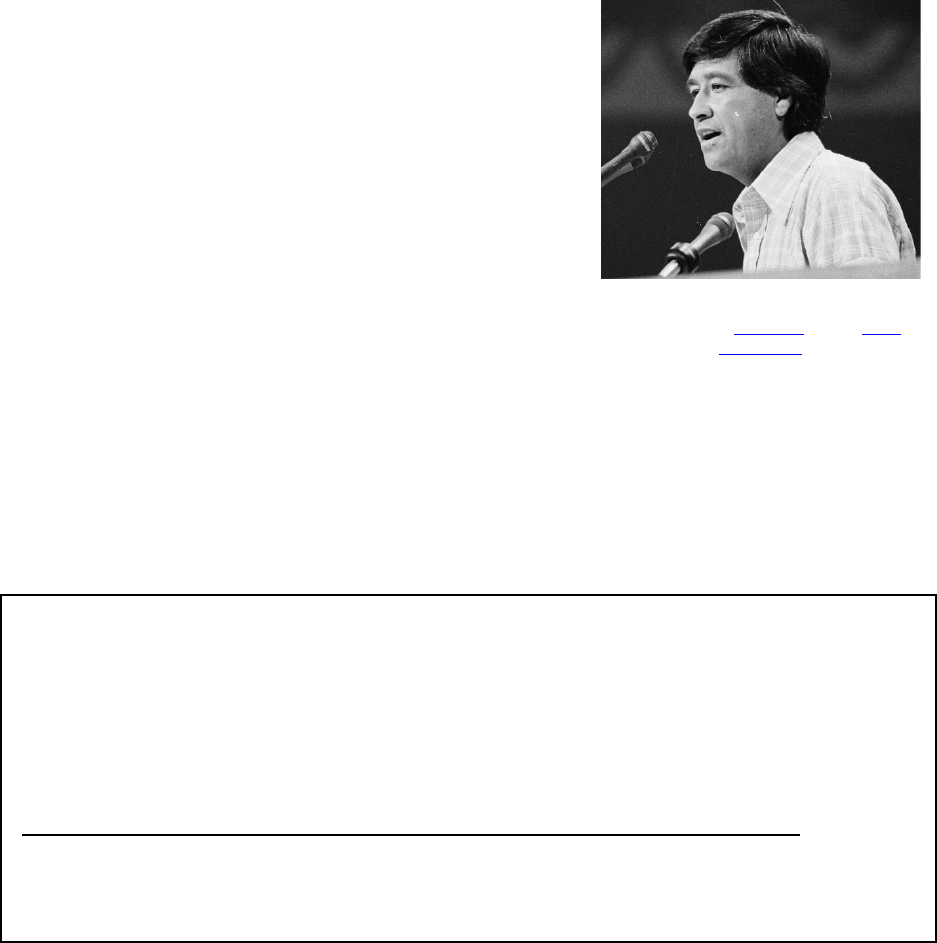
OUR LIVES: AN ETHNIC STUDIES PRIMER 99
On the front of labor issues in the U.S., many issues needed
to be addressed. The abuses of the Bracero program
continued to impact Latinx communities, especially after
the initiation of Operation Wetback and the deportation of
many farm laborers. The work of the Farmworkers
Movement grew out of the valleys of California. The
famous César Chávez, a WWII veteran, rose to prominence
as an activist and organizer of the National Farm Workers
Association, alongside Dolores Huerta and Gilbert Padilla.
This group combined forces with Philip Vera Cruz and the
Agricultural Workers Organizing Committee to protest the
unfair labor practices of California grape growers. Their
primary tactic was a consumer boycott - to refrain from
buying and consuming any products that were derived from these grape farmers. Other forms
of protest by the organizers included marches and Chávez’s fasting. The most notable march
was led by Chávez in 1966, extending 300 miles from Delano, California to the state capital of
Sacramento. In the end, labor contracts were negotiated between the growers and the
farmworkers unions to increase wages and improve working conditions such as limiting the use
of harmful pesticides (Ortiz, 2018).
Latinx Americans continued to participate in the civil rights movements of the 1960s in Chicago
in the name of the Young Lords. This movement was led by young Puerto Ricans but also
involved the participation of other Latinx groups. Their organizing focused on education and
community building. The Young Lords provoked the formation of other chapters active in New
York City and other areas of the eastern seaboard. In NYC, the Young Lords sought to fight
inequities of the conditions of minority neighborhoods in regard to infrastructure and access to
government programs.
Like other civil rights movements of the late 1960s, the Brown Power, or Chicano/a movement
in Southern California demanded recognition and the end of racial discrimination in the U.S.
APPLICATION 6.2
SHIFTING PERSPECTIVE: LABOR & THE STRUGGLE OF MIGRANT FARM WORKERS
Goal
To understand the perspective of Latinx farmworkers.
Instructions
Read Letter from Delano by Cesar Chavez (1969)
(https://libraries.ucsd.edu/farmworkermovement/essays/essays/Letter%20From%20Delano.pdf). Answer the
following questions:
1. How does Chávez describe the farm workers movement?
2. Was he effective in conveying his goals?
"Democratic Convention in New York City
July 14, 1976” by Wikimedia is in the Public
Domain, CC0
OUR LIVES: AN ETHNIC STUDIES PRIMER 100
This was an extension of the farm workers movement in the California Central Valley.
Additionally, the Hart-Cellar Act of 1965 opened immigration to other Latin American
countries, continuing the trend of diversification of American society. Along with other racial
and ethnic minorities, Latinx communities struggled with identity, discrimination, and injustice
into the end of the 20
th
century. Despite these struggles, many achieved progress in education,
gainful employment, and political representation.
THE RECENT PAST
After the tumultuous era of the 60s and 70s, Latinx Americans continued to diversify American
society. However, because of racial categorization, some Latinx Americans struggled with
identity. According to the last 20 years of census data, millions of Latinx Americans chose
“other” as their racial category on the census. Legal precedent puts Latinx individuals under the
umbrella of “White,” but many reject this distinction. To complicate matters more, colorism, or
shades of skin tones also effect how Latinx Americans choose to identify and/or are labeled by
appearance. Other factors such as generation, cultural traits and traditions, and language
complicate Latinx identity even more (Navarro, 2012).
In politics, Latinx Americans are continually confronted with issues immigration and reforms.
DACA, the DREAM Act, and Latin American immigrants have sparked much controversy in
recent years. Both pieces of legislation addressed the segment of Latinx Americans that were
originally brought to the U.S. as children. These children lived the majority of their lives on
American soil, educated in American schools, raised in American culture – making them
American in all ways with the exception of a legal document. Some of these children grow up in
mixed documented families. In the recent past, there have been numerous threats to deport
“undocumented immigrants,” regardless of their participation within and contributions to
American society. To deport any of these children, some now adults, would most likely result in
separation of families and a displacement of individuals who argued that the U.S. was their
rightful home, and they had no say in the original migration into the U.S.
The DREAM Act, Development, Relief, and Education for Alien Minors Act, allowed these
children of immigrants to gain access to education, government funding for education, and
conditional residency. DACA, Deferred Action for Childhood Arrivals Act, was passed under the
Obama administration in 2012, and it allowed for minors to apply for deferment of deportation.
In 2017, the Trump administration rescinded DACA in an attempt to end the program. However,
since then, the act has undergone numerous legal battles that have resulted in the extension of
the act. Currently, there are an approximate 700,000 DACA recipients in the U.S., and
challenges to the program are still on going.
Xenophobia against Latinx communities have instigated much conflict and political debate.
Latinx Americans continually strive to break long held stereotypes and maintain fair
representation in popular culture and media. They do this while still retaining their cultural
heritage and identity, in a complicated and deeply personal expression of individual identity.

OUR LIVES: AN ETHNIC STUDIES PRIMER 101
BIOGRAPHICAL REFLECTION 6.1
A LITTLE GOES A LONG WAY
Before I began my career as a college professor, I was an elementary school teacher. Like most elementary school
teachers, I have many stories to tell, and I will share one very important and special one.
Entering the teaching profession in central California in the 1990s, I found myself in a world where bilingual skills
were in high demand, and bilingual classes were frequently taught and common to find. I was not bilingual, and I
was assigned to a class where most students were native Spanish speakers. I even asked my principal to change my
assignment to English-only. His response was that he would rather have a capable non-Spanish-speaking teacher
teaching a bilingual class that a lesser teacher than did speak Spanish.
If you are thinking “Are you kidding me?” get in line. I thought my principal had lost it. But there I was, in a class
where some of the students knew little English, and others were somewhat resentful that they had an African-
American non-Spanish speaker for a teacher rather than a fluent Latino Spanish speaker. It was not an easy year,
and I really didn’t know what I was doing half the time.
But one thing I did was refuse to do nothing. I enrolled in a beginning Spanish class at West Hills College Lemoore. I
slowly but surely acquired linguistic skills in Spanish. I learned courtesies and “survival” language of course, but at
least, I could give students permission to use the restroom and go to recess, using Spanish words. I took more
Spanish, and even attended a summer Spanish language seminar. Within two years I was well—far from fluent, but
much better off than before.
One day I was sitting in my classroom, and a monolingual Spanish-speaking parent came in my classroom. She said
she needed help with understanding her son’s homework. For the next 15 minutes, I struggled with the Spanish I
knew, but when she walked out, she said “Muchas gracias, Maestro.” I was practically faint from exhausting every
Spanish word I knew, but that was my first successful conversation with a parent. What happened next nearly
electrified me. Standing in front of my desk was a line of non-English speaking students with math books in hand,
asking me for help, in Spanish. None of these students had said more than a few words to me the entire first four
months of school!
When they saw that I could speak some Spanish, that was all they needed to know. The door of communication
had been opened. A very happy conclusion to this awakening happened several years later. One of my former
Spanish-speaking second graders was the valedictorian of her eighth-grade class. During her graduation speech,
she thanked me as her favorite teacher, for of all things - being the only teacher who spoke Spanish to her. Now
that is incredible, considering I was not fluent in Spanish.
To close, a little goes a long way. I am a strong advocate for learning a second language or at least part of a second
language. It opened up doors of communication between my students and myself and gave me a respect and
knowledge of a different culture that I never would have been privileged to know otherwise.
What motivated the writer to learn Spanish? What were some of the rewards for the time invested in learning it?
What does this story tell you about the value of knowing a second language?
This story “A Little Goes a Long Way” by Daryl Johnson is licensed under CC BY NC ND 4.0
SUMMARY
Beginning in the early 16
th
century, Spanish speakers have inhabited North America; they
created settlements and cultivated the land. Because of the complex history of colonization and
intermarriage, Latinx Americans are difficult to define in racial and ethnic categories. After

OUR LIVES: AN ETHNIC STUDIES PRIMER 102
American efforts of westward expansion, many Latinx Americans found themselves citizens of
the United States. Latinx communities continued to thrive in America throughout the 20
th
century, some settling permanently, others migrant workers. By the 1960s, many Latinx
Americans joined civil rights movements, most of them concerned with labor reforms.
Regardless of obstacles and discrimination, Latinx American communities continue to strive
forward, determined to be recognized for their contributions to U.S. history. Like all other racial
and ethnic minorities, their labor helped build this country and continues to demand progress
and equity even today.
REVIEW QUESTIONS
1. What factors motivated Iberians to explore and colonize the Americas in the 16
th
century?
2. How did westward expansion impact Spain and Mexico?
3. Define U.S. foreign policies during the 19
th
century regarding Latin America. How did these
policies impact Latin America?
4. What issues drove the Latinx American civil rights movement of the 1960s?
TO MY FUTURE SELF
From the module, what information and new knowledge did I find interesting or useful? How
do I plan to use this information and new knowledge in my personal and professional
development and improvement?
REFERENCES
Foner, E. (2014). Voices of freedom: A documentary history: Volume 1. (4
th
ed.). W.W. Norton &
Company.
Foner, E. (2014). Voices of freedom: A documentary history: Volume 2. (4
th
ed.). W.W. Norton &
Company.
Locke, J. & Wright, B. (2019). The American yawp. Stanford University Press.
http://www.americanyawp.com/index.html.
Ortiz, P. (2018). An African American and Latinx history of the United States. Beacon Press.
Rothenberg, P. S. (2016). Race, class, and gender in the United States: An integrated study. (10
th
ed). Macmillan.
Takaki, R. (1993). A different mirror: A history of multicultural America. Back Bay Books.
OUR LIVES: AN ETHNIC STUDIES PRIMER 103
MODULE 7. OUR DIVISIONS
LEARNING OBJECTIVES
At the end of the module, students will be able to:
1. explain the implications of culture on social power and hierarchies
2. summarize the mechanisms used by dominant groups to develop and sustain power
3. understand cultural hegemony
4. identify and evaluate prejudice and discrimination
5. discuss types of racism and exploitation
KEY TERMS & CONCEPTS
Acculturation
Affective Form
Assimilation
Authoritarian personality
Cognitive Dissonance
Cognitive Form
Color Blindness
Conative Dimension
Critical Race Theory (CRT)
Cultural Fit
Cultural Hegemony
Cultural Power
Cultural Relativism
Discrimination
Ethnocentrism
Eurocentrism
Fallacies
Ideological Racism
In-group
Individual Discrimination
Institutional Discrimination
Out-group
Overcategorize
Prejudice
Racial Prejudice
Racial Privilege
Racism
Reference Group
Scientific Racism
Social Location
Socialization
Socioeconomic Status
Stereotypes
Symbolic interactionism
White Supremacy
INTRODUCTION
By learning the history and the experiences of African Americans, Asian Americans, Latinx
Americans, and Native Americans, we are better able to understand the racial formation, racial
intolerance, racial and ethnic inequalities these major underrepresented groups have faced in
the United States. The histories and lives of Americans of color show courageous character and
acts of valor in their fight for freedom and equality as promised in the Constitution of the
United States. Ancestors of these racial-ethnic groups represent agents of change and are our
role models in the fight against prejudice, racism, and discrimination.
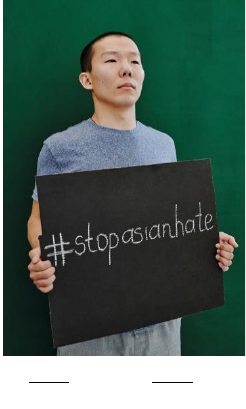
OUR LIVES: AN ETHNIC STUDIES PRIMER 104
CULTURAL HIERARCHIES
All humans are comprised of the same biological structure and matter. The unique distinctions
among us stem from our culture (Kottak & Kozaitis, 2012). The differences in our values, beliefs,
norms, expressive language, practices, and artifacts are which stands us apart from one
another. Being culturally unique projects exclusivity that draws attention to our variations and
differences. People find cultural fit or acceptance from those who share uniqueness or the
same cultural characteristics. Consequently, people may find or experience intolerance or
rejection from those with different cultural traits.
Cultural distinctions make groups unique, but they also provide a social structure for creating
and ranking people based on similarities or differences. A group’s size and strength influence
their power over a region, area, or other groups. Cultural power lends itself to social,
economic, and political power that influences people’s lives by controlling the prevailing norms
or rules and making individuals adhere to the dominant group culture voluntarily or
involuntarily.
Culture is not a direct reflection of the social world (Griswold, 2013).
Humans frame culture to define meaning and interpret the social
world around them. As a result, dominant groups are able to
manipulate, reproduce, and influence culture among the masses or
all Americans. Common culture found in society is actually the
selective transmission of elite-dominated values (Parenti, 2006). This
practice known as cultural hegemony suggests that culture is not
autonomous, it is conditionally dictated, regulated, and controlled
by dominant or powerful groups. The major forces shaping culture
are in the power of elite-dominated interests who render limited
and marginal adjustments to make culture appear changing in
alignment with evolving social values (Parenti, 2006). The
dominating cultural group often sets the standard for living and
governs the distribution of resources.
When social groups have or are in power, they have the ability to discriminate on a large scale.
A dominant group or the ruling class impart their culture in society by passing laws and
informally using culture to spread it. Access to these methods allows hegemonic groups to
institutionalize discrimination. This results in unjust and unequal treatment of people by society
and its institutions. Those who culturally align to the ruling class fair better than those who are
different.
PREJUDICE
Cultural intolerance may arise when individuals or groups confront new or differing values,
beliefs, norms, expressive symbols, practices, or artifacts. Think about a time when you came
across someone who did not fit the cultural “norm” either expressively or behaviorally. How did
Image by ShotPot, Pexels is
licensed under CC BY 4.0

OUR LIVES: AN ETHNIC STUDIES PRIMER 105
the person’s presence make you feel? What type of thoughts ran through your head? Were you
compelled to understand the differences between you and the other person or were you eager
to dismiss, confront, or ignore the other person?
Living in a diverse society requires us to tackle our anxiety of the unknown or unfamiliar. The
discomfort or cognitive dissonance we feel when we are around others who live and think
differently than ourselves makes us alter our thoughts and behaviors towards acceptance or
rejection of the “different” person in order to restore cognitive balance (Festinger, 1957). When
people undergo culture shock or surprise from experiencing new culture or ideas, their minds
undergo dissonance. Similar to a fight or flight response, we choose to learn and understand
each other’s differences or mock and run away from them.
People judge and evaluate each other on a daily basis. Assessing other people and our
surroundings is necessary for interpreting and interacting in the social world. Problems arise
when we judge others using our own cultural standards. As discussed in Module 1, we call the
practice of judging others through our own cultural lens ethnocentrism. This practice is
culturally universal. People everywhere think their culture or way of life is true, moral, proper,
and right (Kottak & Kozaitis, 2012). By its very definition, ethnocentrism creates division and
conflict between social groups whereby mediating differences is challenging when everyone
believes they are culturally superior, and their values, beliefs, norms, expressive language,
practices, and artifacts should be the standard for living.
BIOGRAPHICAL REFLECTION 7.1
NEW HOME & RACE RELATIONS
My family fled communist Laos to find safety and freedom with a kernel of hope that our life in a different country
would be easier. After four years of living in a dilapidated Thailand refugee camp, fenced by barbed wire, my family
resettled in the United States in 1979. Of all places, we ended up in Nashville, home to America’s country music.
How heartland could one get! I get to tell friends and colleagues that my first three words of English were: Yes, No,
and Hee-Haw.
All kidding aside, there were serious racial tensions between the Hmong and our Black neighbors. They had no idea
who we were and vice versa. Granted, most of our Black neighbors were indifferent towards us; some were
friendly and greeted us with a good morning wave; a few, however, found new opportunities to perpetrate their
violence. Three Hmong families – my father’s, my cousin’s, and our brother-in-law’s – with 19 children were
housed in a 4-bedroom and 1 restroom apartment. We were refugees; tight space was not a problem. Soon
enough, though, we discovered we may have escaped the terror of communists, but then only to enmesh in a new
terror on Wharf Avenue in Nashville’s impoverished project, a quicksand that swallowed Hmong refugees into
culture shock and further made us easy crime targets.
While biking around the block, my younger brother, Pao, 9 years-old, was chased and shot on the forehead by a BB
gun, nearly blinding him. The two juvenile Black boys who shot him were never brought to justice. My aunt Blong
had her stack of food stamps stolen from her pocket as she was shoved to the sidewalk. Early one morning my
uncle Nhia Va got robbed and stabbed in the stomach while walking to his car to go to work. He managed to run
two blocks to find help at our apartment while trying to keep his intestines from slipping out more. I was ten years
old; the gruesome image haunted me for years. The police had to be called more times than I can remember. My
older brother, Shua, was the only person who spoke English and made all the calls to the police. One day we heard
a loud bang on our door. We opened the door and found eight angry black men standing outside, yelling and

OUR LIVES: AN ETHNIC STUDIES PRIMER 106
demanding Shua to go outside. Who knew what would have transpired next had we not had a security door.
Quickly, my brother called the police again. The men dispersed when the police came a minute later.
These incidents in turn twisted us, and we learned to hate back, wondering why Black people were so mean. We
spoke ill of them and wished they didn’t exist. The racial tensions were beyond remedy. The only remedy was to
move away, but we could not. We had no money, no way to search for a new place. Where it would be safe, we
could not afford; where we could afford with the little government cash aid we received, there was no vacancy.
Our three congested Hmong families lived in fear and constant harassment for another eight months before our
sponsor found two open apartments on 40
th
Avenue and a house in a quiet White neighborhood, making our
relocation possible. The project on 40
th
Avenue felt different, though our new neighbors were also predominantly
Black. We felt safe sitting outside our front door to relax. The Black kids in the neighborhood were friendly and
invited my two brothers and me to play basketball and football. Sports pulled us together and made us friends. In
basketball these Black friends taught us names like Larry Bird, Magic Johnson, Kareem Abdul Jabbar, and football
Earl Campbell, Steve Bartkowski, Ed “Too Tall” Jones, and Joe Montana. When our family moved to Fresno a year
and half later to join the growing Hmong community in Fresno, my brothers and I truly missed those three Black
friends. At times we reminisced about our childhood playdays with Joe Bert, KK, and Lil. Through those friends, we
learned to judge people by character, not by skin color – reversing our Wharf Avenue nightmare.
Church service was a thing our family, along with other Hmong and White American families, did on Sunday
mornings. White people from the Church of Christ picked us up for service; they dropped us off. But they didn’t
live near us. Occasionally they invited us to their homes across town. We saw how nice, clean, and spacious their
homes were; no broken glass bottles on the street, grass cut, and trees trimmed – a drastic change from what I’ve
seen at our apartment in the project. It was my first glimpse into the economic divide of a deep sociological
(perhaps racial) issue beyond my comprehension.
My first introduction to college was when a church friend, Allen Burris, took us to get some tutorials from his
college friends at David Lipscomb College. On a side conversation, I asked a naïve question to which I learned
something new quickly, “Allen, what’s the name of the principal in your college?” “My principal is Mr. Snow,” I
revealed proudly like I got points for knowing it. Allen responded, “In college we don’t have a principal, but we
have a president.” I remember asking Allen further (with my broken and hesitant English) why Jimmy Carter is the
president, but we have a person in the school called president, too? The conversation morphed into some
additional explanation that Jimmy Carter is the president for the whole United States, but the school president is
only in charge of the college. I knew then I wanted to go to college, not to become a college president but just to
know things.
Fresno’s growing Hmong population provided my parents a sense of belonging - seeing relatives, speaking the
same language, and living near each other in apartment clusters in SE Fresno. They felt they could be Hmong again
after two years of cultural and linguistic isolation in Nashville. Other Hmong people organized cultural festivals to
restage an old practice in a new country, for example, the Hmong New Year celebration became the premier event
to attend. This multifaceted social event attracted friends and relatives from all over the country to meet in
Fresno. Young single people had the opportunity to find a spouse, fulfilling booth vendors and organizers’ dreams
of cash operating schemes. My sisters who were barely in their mid-teens were pressured to get married. Some
conversations among the elderly women – my mother included - were about how to marry off their daughters
before they became “old maids.” Occasionally the conversation drifted off to complain about the inconsistent
welfare amount they received from social services. Both issues horrified and embarrassed me profoundly. I only
wish my sisters were directed towards going to college instead of early marriage; I wish my parents had education
and held jobs, so we didn’t have to rely on welfare. I vowed never to succumb to the social backwardness of my
culture because being Hmong meant uneducated and dependent on welfare.
This story “New Home & Race Relations” by Silas Cha is licensed under CC BY NC ND 4.0

OUR LIVES: AN ETHNIC STUDIES PRIMER 107
The U.S. cultural lens is a product of the country’s founding fathers and early settlers. European
culture and history became the widely accepted view during the colonialization of what we call
“America.” Eurocentrism is a worldview centered on Western civilization derived from the
culture and history of Western Europe and the early colonizers. As the country was conquered
and a government established, native peoples and immigrants (voluntary and involuntary) were
pressured to assimilate and acculturate to European way of life. Through assimilation, minority
groups were forced to assume and absorb the majority (dominant group) culture. Acculturation
occurred as minority groups adapted to the dominant culture while maintaining some cultural
uniqueness such as language, traditions, and dietary customs. Eurocentric ideals continue to be
instilled in America today through socialization of children and youth, and the assimilation and
acculturation of new immigrants.
Eurocentric ideals promote racial-ethnic group dominance of Whites. White supremacy is the
belief that White people are a superior race and must dominate society to the exclusion or
detriment of other racial-ethnic groups. As we have learned, the
concept of race is socially constructed. Scientists working on the
human genome project showed there is no “race” gene (Anderson &
Collins, 2010). The meaning of race stems from social, historical, and
political contexts which nonetheless makes race meaningful and real
in our experiences. Racial framing and classification reflect prevailing
or dominant group views and reinforces the ideological belief that
racial categories and grouping is natural or the norm though scientific
evidence suggests the contrary. Racial categories are the basis for
allocating resources and framing political issues and conflicts
(Anderson & Collins, 2010). For example, the Holocaust was a result
of the social construction of “Jew” as a race in Nazi Germany. Still
today White supremacist groups and White racism typify the “Jewish”
racial category even for people who are seen and live in our society as
“White” (Ferber, 1999).
In contrast to ethnocentric and Eurocentric beliefs and ideas, cultural relativism insinuates
judging a culture by the standards of another is objectionable, unpleasant, and offensive. It
seems reasonable to evaluate a person’s values, beliefs, and practices from their own cultural
standards rather than be judged against the criteria of another (Kottak & Kozaitis, 2012).
Learning to receive cultural differences from a place of empathy and understanding serves as a
foundation for living together despite variances. Like many aspects of human civilization,
culture is not absolute but relative suggesting values, beliefs, and practices are only standards
of living as long as people accept and live by them (Boas, 1887). Developing knowledge about
cultures and cultural groups different from our own allows us to view and evaluate others from
their cultural lens and life experience.
Sometimes people act on ethnocentric thinking and feel justified disregarding cultural
relativism. Overcoming negative attitudes about people who are culturally different from us is
challenging when we believe our culture and thinking are justified. Consider the social issue of
Image by Ketut Subiyanto,
Pexels is licensed under
CC BY 4.0

OUR LIVES: AN ETHNIC STUDIES PRIMER 108
infanticide or the killing of unwanted children after birth. The historical practice in some
societies occurred in times of famine or hardship when resources were scarce to keep non-
productive humans alive. Many people find infanticide a human rights violation regardless of a
person’s cultural traditions and beliefs and think the practice should stop. People often feel
justified condemning the practice of infanticide and the people who believe and practice the
tradition.
Prejudice is an attitude of thoughts and feelings directed
at someone from prejudging or making negative
assumptions. Negative attitudes about another’s culture
are a form of prejudice or bias. Prejudice is a learned
behavior. Prejudicial attitudes can lead to discriminatory
acts and behaviors. Prejudicial attitudes and beliefs stem
from overcategorizing, stereotypes, and fallacies about
people. We are prejudice when we overcategorize people
by exaggerating a group’s belief system, associating the
belief with a certain type of people, and defining the
belief and type of people in a positive or negative way to
justify a favorable or unfavorable prejudice (Farley, 2010). Stereotypes are oversimplified ideas
about groups of people we believe to be true (Griffiths et al., 2015). By stereotyping people, we
infer all members of a group have the same characteristics or abilities. Fallacies are errors in
our reasoning that undermine logical thinking. Fallacies are classified as illegitimate arguments
(inconsistent or inappropriate), irrelevant facts, or unsubstantiated information (Lau & Chan,
2021).
Prejudice occurs in the mind as we process information about people. Our attitudes and beliefs
of others reflect what we think about their characteristics or abilities. There are three
ideological dimensions of prejudicial thinking: cognitive, affective, and conative (Farley, 2010).
A cognitive form of prejudice depicts the beliefs we think are true about others. Affective
forms of prejudice indicate our likes and dislikes of others. Lastly, the conative dimension
signifies the behavior we are likely to display towards others as a result of our prejudice. For
example, thinking the practice of infanticide should stop (cognitive) and those who practice it
malevolent (affective) is prejudicial. Trying to stop the practice (conative) with force is
discriminatory. There are times in the case of human rights issues like this where the fine line
between criticizing with action (ethnocentrism) and understanding with empathy (cultural
relativism) are clear. However, knowing the appropriate context when to judge or be open-
minded is not always evident. Do we allow men to treat women as subordinates if their religion
or faith justifies it? Do we allow people to sacrifice puppies for religious or spiritual purposes?
Do we stop children who do not receive vaccinations from attending school? All of these issues
stem from cultural differences and distinguishing the appropriate response is not always easy
to identify.
Image by RODNAE Productions, Pexels is licensed
under CC BY 4.0

OUR LIVES: AN ETHNIC STUDIES PRIMER 109
Because prejudice is associated with the mind and one’s thinking, it is important to understand
its causes. Social scientists have found three general theories on why people are prejudice. The
first perspective explains that some people have an authoritarian personality that is prone to
prejudice in order to fulfill their own personality needs (Adorno et al., 1950; Freud 1930, 1962).
This theory suggests prejudice is produced by a particular personality pattern or type. The term
“authoritarian” was given to this theory to illuminate that people with this personality pattern
or type are likely to support authoritarian political movements promoting and supporting
prejudice such as White supremacy. According to Brown (1965) the basic characteristics
associated with an authoritarian personality are: 1) adherence to conventional values, 2)
uncritical acceptance of authority, 3) aggressive towards others who do not conform to
authority or the norms, 4) oppose and reject self-analysis, 5) superstitious and stereotypical in
thinking, 6) concerned with power and being tough, 7) display destructive and cynical ideas, 8)
view the world as wild and dangerous, and 9) overly concerned with sex crimes and people
living wild sex lives. An authoritarian personality results in scapegoating or displacing aggression
and projecting emotions or traits a person does not like about one’s self and attributing them
to others. Examples include blaming others for personal failures or a violent person suspecting
others as being harmful.
Several theorists have discovered specific personality patterns and traits associated with
prejudice. Ehrlich (1973) found insecure and people lacking self-esteem are often prejudiced.
They are unable to accept negative aspects of their personalities (Farley, 2010). Adorno,
Frenkel-Brunswick, Levinson, and Sanford (1950) showed prejudiced subjects were highly
concerned about their social status and came from strict homes. Hamilton (1981) uncovered
the need to see the world in oversimplified terms was linked to prejudice. Whereby, Fishbein
(1996) showed the need to deny one’s own shortcomings was linked to prejudicial thinking.
Furthermore, Duckitt (2001) linked the need to obey and respect authority reflected the need
for personal control and security. Lastly, Altemeyer (1998) coined the term “social dominance
orientation” to describe the belief in the importance of social hierarchy or belief that some
people are better than others. The result of this research on personality and prejudice shows
APPLICATION 7.1
THE THINKING BEHIND PREJUDICE
Goal
To understand the psychology of prejudice and discrimination.
Instructions
Watch the Crash Course video Prejudice and Discrimination (https://youtu.be/7P0iP2Zm6a4). Answer the
following questions about prejudicial thinking and acts:
1. Define prejudice.
2. Discuss the influence of social identity (i.e., race, ethnicity, age, gender, sexuality, social class, etc.) on
stereotypical beliefs and prejudicial thinking.
3. Explain the impact stereotypes and prejudice have on behavior and discrimination.
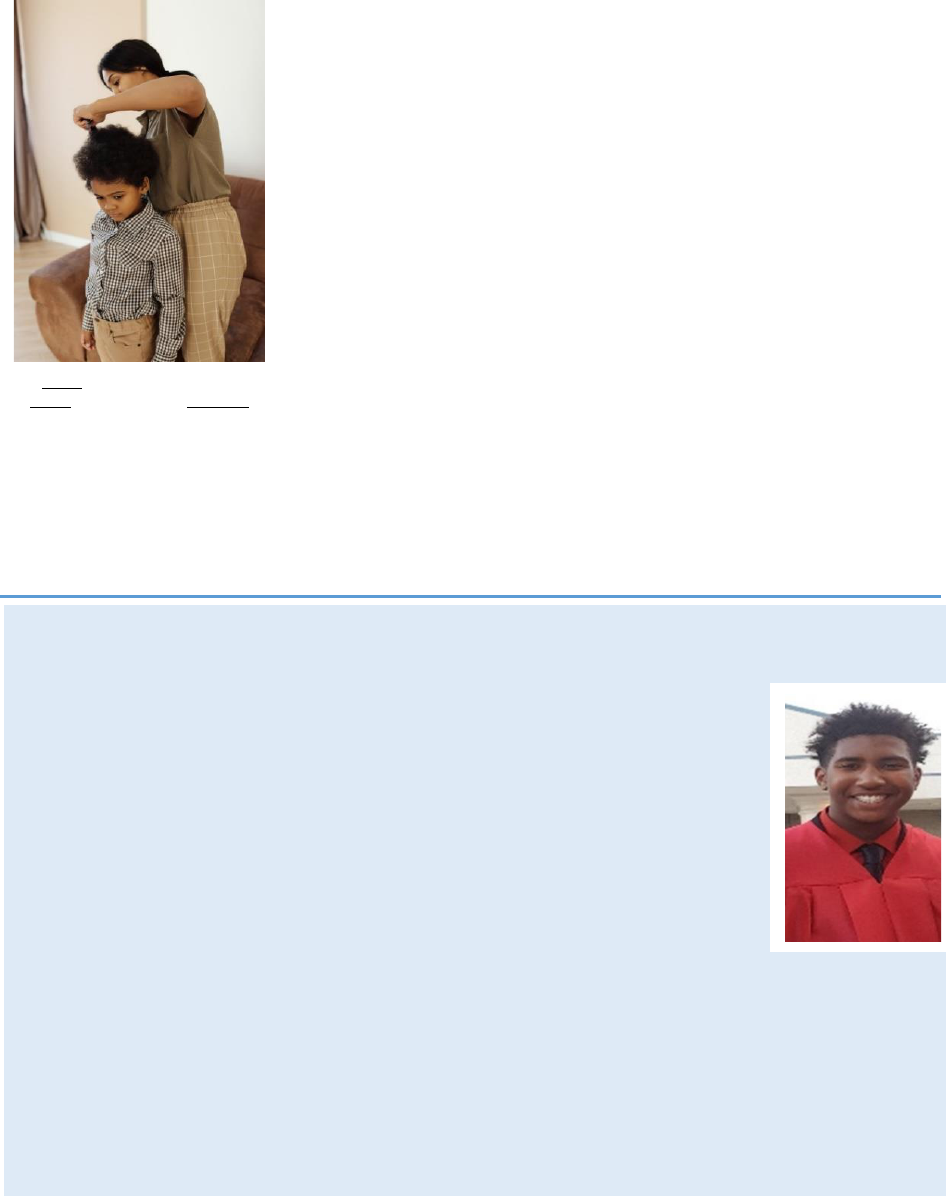
OUR LIVES: AN ETHNIC STUDIES PRIMER 110
that when people feel there is a threat to their social stability or cohesion, the effects of
authoritarianism on personal and social prejudice are greater (Feldman, 2003).
The second perspective suggests people learn or are socialized to
be prejudiced. Socialization occurs throughout the course of life.
Learning the cultural traits and characteristics at certain stages of
life is important in developing self-identity and group acceptance.
Parents and peers with whom a child feels close identification are
especially strong influencers (Kasser et al., 2002; Bandura &
Walters, 1963; Allport, 1954). People learn prejudice through
socialization reinforcing implicit bias and racist ideologies such as
“White is normal.”
Social learning theory (Bandura, 1977) is a form of symbolic
interactionism examining micro-level interactions of thinking and
behavior. Interactionists consider how people interpret meaning
and symbols to understand and navigate the social world.
Individuals create social reality through verbal and non-verbal
interactions. These interactions form thoughts and behaviors in response to others influencing
motivation and decision-making. Hearing or reading a word in a language one understands
develops a mental image and comprehension about information shared or communicated such
as the media message of “the crack mother icon” which is most commonly visualized as a single
mother of color on drugs with multiple children receiving welfare or government assistance.
BIOGRAPHICAL REFLECTION 7.2
THAT IS NOT AN ALTERCATION
Winston is a delightful soul. He is one of my three sons and his smile tells it all. He lives life
out loud, is solid in who he is, and has a bright future. He was about 5’11 in junior high, which
makes him look older, and is an exceptional athlete. He looks predominately African
American although he comes from a multi-racial background as you can see in this photo
from his 8
th
grade graduation.
When he was in junior high school, I received a call from the Dean at the school he attended.
The Dean announced who he was and stated, “Winston has been in an altercation, you need
to come to the school.” My first thoughts are, “Winston in a fight? He has never been in a
fight. He is a highly competitive athlete who I have seen shoved on a court by an opponent,
and he shrugs it off and keeps moving. Fighting is not him. Either way, I raced to the school.
When I arrive, my Winston is in the office and visibly annoyed that I have shown up. He is shaking his head and
tells me this is being blown out of proportion. The Dean tells me that he has video footage of the altercation, but
first he wants Winston to tell me what happened. He tells Winston with an emphatic tone, “Tell your mother what
happened.” Winston says, “We were play fighting on the bus.” The Dean states again in an emphatic tone,
“Winston, I have video footage of what happened, tell your mother the truth.” Winston insists, “We were playing
on the bus mom.” At this point I am annoyed because I raced over from work, now I simply want to see this video.
The video rolls and I see a bus full of rambunctious middle schoolers. The bus driver is visibly agitated at all of the
energy behind him. Finally, the scene of the “altercation.” Winston is sitting across from one of his friends on the
Image by August de Richelieu,
Pexels is licensed under CC BY 4.0

OUR LIVES: AN ETHNIC STUDIES PRIMER 111
bus, an Asian Indian friend. His friend has a ball in his hand and Winston placed his hand underneath his friend’s
hand and slaps up causing the ball to drop on the floor. His friend stands up and punches Winston in the arm a few
times, and Winston starts laughing with him about the matter with his body in a defensive mode saying, “Ok, Ok,
I’m sorry dude.” End of altercation.
In the most diplomatic way possible, I shared with this Dean how I felt that the language he used to describe what
happened was overzealous at best. I asked him "Where is Winston's friend who punched him?" He stated that he
was in the lobby of the administration building. I asked, “Are they ok with each other?” The Dean said, “Yes.” I said,
okay, I need to get back to work.
I wondered if the Dean, being a White man, working at a mainly White school, made his perspective
“whitewashed” to the ways boys’ banter. I was most concerned because the language he used could have caused
Winston to be suspended from school. He insisted that Winston be sent home for the day as a result. I advocated
for him to stay in school as he did nothing wrong from what I observed. As a matter of fact, he was punched
several times. I also stated that the lack of mediation for these types of interactions at school is a problem and as
administrators, there is an expectation that they would try to mitigate situations like this.
I would have many more stories like this where people would see him as a “Big Black Boy,” and use loaded words
to describe him or a situation involving him. The implicit bias of his size and color would be quelled once people
got to know him and realize what a sweet and respectful young man he is. It was and still is heart wrenching as a
mother to remind him to not forget where he is and who he is around.
I wondered what would have happened to Winston along the way if he did not have a parent that was advocating
for him and teaching him how to navigate through a world as a “Big Black Boy.” I would often pray that instead of
seeing altercations, or threats, they would see what I see. I see a young man who embraces the person he was
created to be.
This story “That Is Not an Altercation” by Guadalupe Capozzi is licensed under CC BY NC ND 4.0
Implicit bias or unconscious prejudice reinforced through socialization (e.g., societal messages)
frames positive words and images for in-group members who share interests and identity and
negative ones for out-groups. An in-group is a group toward which one feels particular loyalty
and respect. The traits of in-groups are virtues, whereas traits of out-groups are vices (Henslin,
2011). An out-group is a group toward which one feels antagonism and contempt. Consider
members of a team or club, people on the same team will develop an in-group admiration and
acceptance while viewing members of the opposing team or club as members of their out-
group.
Socialization protects and shelters in-group members with ideologies that instill unconscious
prejudice and animosity toward or competition with out-groups. As in-group members are
socialized they receive selective exposure and modeling to reinforce group homogenity
(similarity) and cohesiveness (belonging). Agents of socialization including family and peers
reward behavior and attitudes that conform to group norms and punish those that do not
(Farley, 2010). Children growing up in prejudicial environments are likely to express prejudice
towards out-groups and internalize prejudicial beliefs and attitudes which lays the foundation
for similar ideas and thinking in adulthood.
Asch (1956) discovered people conform to gain acceptance and learn the rules or norms by
watching and mimicking reference group members. Reference groups are also influential

OUR LIVES: AN ETHNIC STUDIES PRIMER 112
groups in someone’s life. A reference group provides a standard for
judging one’s own attitudes or behaviors within a social setting or
context (Henslin, 2011). People use reference groups as a method for
self-evaluation and social location or status. People commonly use
reference groups by watching and emulating the interactions and
practices of others so, they fit in and garner acceptance by their
associated in-group. Bonilla-Silva & Embrick (2007) learned that
studying neighborhoods where people grow up around White-
centered life socializes them to a life centered on Whites.
The third perspective suggests a correlation between socioeconomic
status and prejudice. Socioeconomic status (SES) is an individual’s
social position or class (Conerly, Holmes, and Tamang, 2021). Marx &
Engels (1967) suggested there is a social class division between the
capitalists who control the means of production and the workers. In 1985, Erik Wright
interjected that people could occupy contradictory class positions throughout their lifetime.
People who have occupied various class positions (e.g., bookkeeper to manager to chief
operating officer) relate to the experiences of others in those positions, and as a result, may
feel internal conflict in handling situations between positions or favoring one over another. Late
in the twentieth century, Dennis Gilbert & Joseph Kahl (1992) updated the three-component
theoretical perspective (class, status, and power) of Max Weber (1922, 1978) by developing a
six-tier model portraying the United States class structure including underclass, working-poor,
working, lower middle, upper middle, and capitalists. The social class model depicts the
distribution of property, prestige, and power among society based on income and education.
Each class lifestyle requires a certain level of wealth in order to acquire the material necessities
and comforts of life (Henslin, 2011). The correlation between the standard of living and quality
of life or life chances (i.e., opportunities and barriers) influences one’s ability to afford food,
shelter, clothing, healthcare, other basic needs, and luxury items. A person’s standards of living
including income, employment, class, and housing effects their cultural identity.
Social class serves as a marker or indication of resources. These markers are noticeable in the
behaviors, customs, and norms of each stratified group (Carl, 2013). People living in
impoverished communities have different cultural norms and practices compared to those with
middle incomes or families of wealth. For example, the urban poor often sleep on cardboard
boxes on the ground or on sidewalks and feed themselves by begging, scavenging, and raiding
garbage (Kottak & Kozaitis, 2012). Middle income and wealth families tend to sleep in housing
structures and nourish themselves with food from supermarkets or restaurants.
Language and fashion also vary among these classes because of educational attainment,
employment, and income. People will use language like “White trash” or “welfare mom” to
marginalize people in the lower class and use distinguished labels to identify the upper class
such as “noble” and “elite.” Sometimes people often engage in conspicuous consumption or
purchase and use certain products (e.g., buy a luxury car or jewelry) to make a social statement
Image by cottonbro, Pexels is
licensed under CC BY 4.0

OUR LIVES: AN ETHNIC STUDIES PRIMER 113
about their status (Henslin, 2011). Nonetheless, the experience of poor people is very different
in comparison to others in the upper and middle classes and the lives of people within each
social class may vary based on intersectionality or their position within other social categories
including age, (dis)ability, gender, race, region, and religion.
Socioeconomic status influences the social position and life
experiences of people. The social structure plays an integral
role in the social location (i.e., place or position) people
occupy in society. Your social location is a result of cultural
values and norms from the time period and place in which
you live. Culture affects personal and social development,
including the way people will think or behave, including ideas
and feelings of prejudice.
Social location influences how people perceive and
understand the world in which we live. People have a
difficult time being objective in all contexts because of their
social location within cultural controls and standards derived
from values and norms. Objective conditions exist without bias because they are measurable
and quantifiable (Carl, 2013). Subjective concerns rely on judgments rather than external facts.
Personal feelings and opinions from a person’s social location drive subjective perspectives and
concerns about others and the world.
Socioeconomic status and other characteristics pertaining to race, age, gender, and education
also influence the location people occupy at any given time. Specifically, Farley (2010) found
education reduces prejudice. Sniderman & Piazza (1993) concluded educated people were
more comfortable with abstract ideas and engaged in complex thinking or thoughtful reflection.
Other researchers showed prejudice is reinforced by teaching ideologies of dominant groups
both formally in the classroom and informally through other agents of socialization such as
family and peers (Jackman and Muha, 1984; Schaefer, 1996). Bonilla-Silva & Forman (2000)
discovered educated people hide their prejudices to avoid being perceived as bad and project
an image of being color-blind. Reaffirming research by Picca & Feagin (2007) showed educated
Whites only express racist views in Whites-only settings.
The reality of an insecure social position feeds prejudicial thinking and behavior. Working class
prejudice arises from whites competing with people of color (Ransford, 1972). Competition
creates a social environment of threats and enemies between racial-ethnic groups. The Klu Klux
Klan (KKK) draws its most support from working-class and poor Whites (Farely, 2010). As the
United States diversifies and the minority population increases, people of color further become
a perceived threat to White’s socioeconomic opportunities and power (King & Weiner ,2007;
Pederson, 1996; Quillian, 1996).
Image by RODNAE Productions, Pexels is
licensed under CC BY 4.0
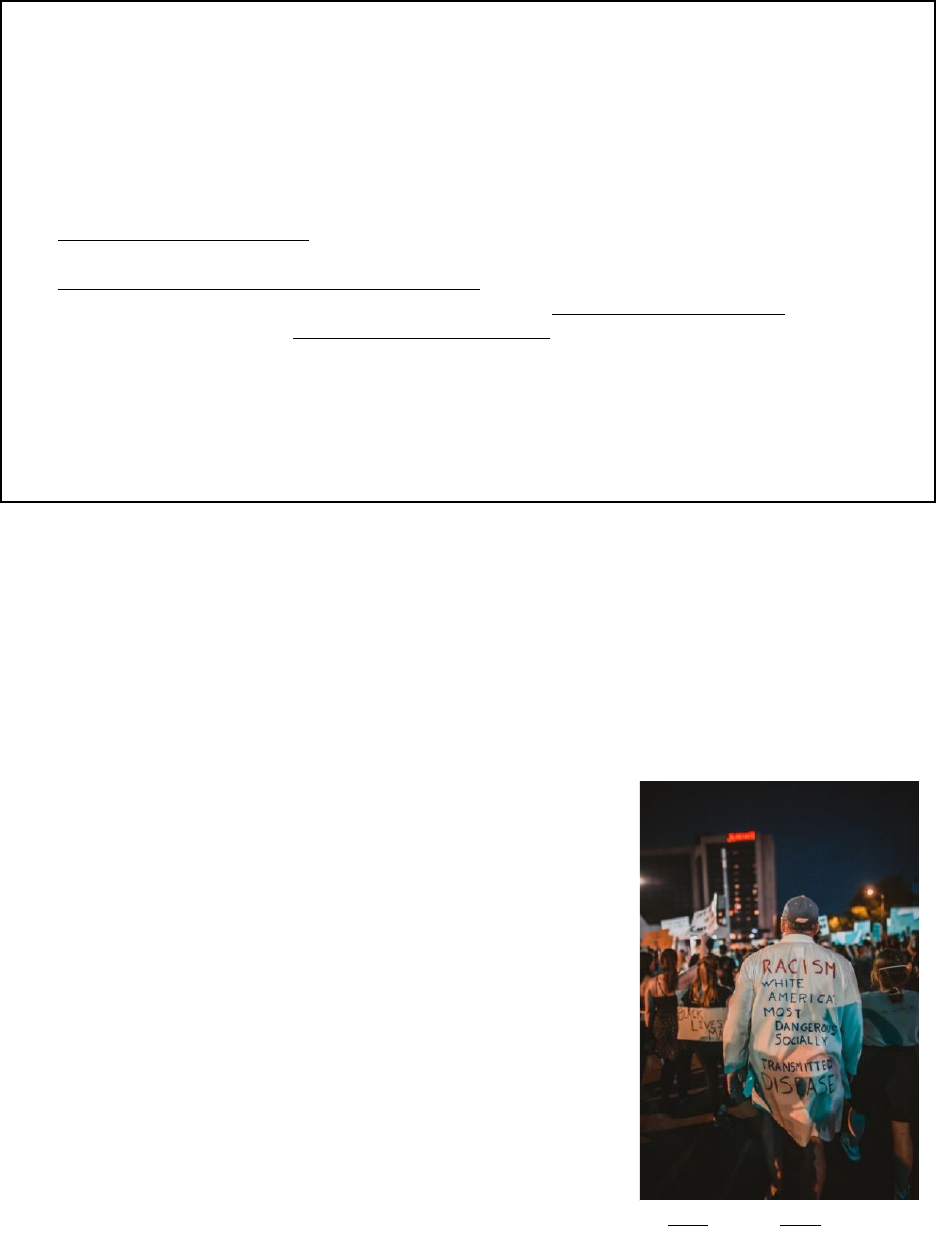
OUR LIVES: AN ETHNIC STUDIES PRIMER 114
RACISM & EXPLOITATION
Race reflects a social stigma or marker of superiority (Kottak & Kozaitis, 2012). Racism is an
attitude, ideology, behavior, or social arrangement (e.g., institution) that benefits and supports
a particular race or ethnic group (i.e., dominant or powerful) over another (minority). Racism is
projected by people in different forms such as racial prejudice, ideological racism, scientific
racism, individual discrimination, and institutional discrimination.
Racial prejudice is the fundamental attitude that favors one
racial-ethnic group over another, lending it to cause unequal
treatment on the basis of race (Farley, 2010). Prejudicial
attitudes derive from people’s thinking and can be overt or
subtle. Overt prejudice manifests into direct dislike or disdain
of a particular racial-ethnic group or its members with the
belief that they are inferior. Subtle prejudice occurs through
the recognition that a particular racial-ethnic group causes
their own problems or is the root of social problems.
Ideological racism is the belief that some people are
biologically, intellectually, and culturally inferior to others
(Farley, 2010). This ideology views racial-ethnic groups as
superior or inferior to one another. Racist ideology has been
substantiated by early publications of scientific theory forming
racist bias in research called scientific racism. Consider, social
Darwinism which argued “survival of the fittest” creating the
APPLICATION 7.2
THE AFFECT OF IMPLICIT BIAS
Goal
To recognize stereotypical beliefs and implicit bias in thinking.
Instructions
1. Watch the TED-Ed video We All Have Implicit Biases presented by Dushaw Hockett
(https://youtu.be/kKHSJHkPeLY).
2. Discover your lens and potential bias by taking the Harvard Implicit Test
(https://implicit.harvard.edu/implicit/takeatest.html).
3. Watch Stereotype Threat: A Conversation with Claude Steele (https://youtu.be/failylROnrY) & Stereotype
Threat Up Close: See It, Fix It (https://youtu.be/7Z63khyCOK4). As you watch the videos, think about how
stereotype threat creates barriers, reduces confidence, and causes people to disengage.
4. As you view the three (3) videos and take the Harvard Implicit Bias test, please make 10 annotations (e.g.,
explanations or comments) to share with your peers. In your 10 annotations or replies:
• react (positively or negatively)
• share connections to your own learning experience
• expand on the strategies presented
Image by Kelly L, Pexels is licensed
under CC BY 4.0

OUR LIVES: AN ETHNIC STUDIES PRIMER 115
socially accepted belief that people with wealth and power are the “most fit.” This ideology was
adopted in colonial America to warrant the domination and support the colonization of the
native peoples of Africa, the Americas, and Asia by White Europeans (Farley, 2010). The use of
scientific theory to justify a racial superiority and inferiority rationalized for many the idea of a
“natural law” advertently served dominant group interests. However, thorough scientific
analysis does not substantiate or validate the biological, intellectual, cultural superiority of any
racial-ethnic group (UNESCO, 2021: Montagu, 1964). True science has discredited the existence
of racial superiority, defines race as a social construct and confirms that race is not sound on a
biological basis. Therefore, ideological and scientific racism are accepted by those who want to
rationalize their domination of other groups or legitimize their superiority.
Discrimination is an action of unfair treatment against someone based on characteristics such
as age, gender, race, religion, etc. When discrimination centers on race, it is racism. There are
two types of racial discrimination: individual and institutional. Individual discrimination is
“unfair treatment directed against someone” (Henslin, 2011, p. 218). Whereas institutional
discrimination is negative systemic treatment of individuals by society through education,
government, economy, health care, etc. According to Perry (2000), when people focus on
racial-ethnic differences, they engage in the process of identity formation through structural
and institutional norms. As a result, racial-ethnic identity conforms to normative perceptions
people have of race and ethnicity reinforcing the structural order without challenging the socio-
cultural arrangement of society. Maintaining racial-ethnic norms reinforces differences, creates
tension, and disputes between racial-ethnic groups sustaining the status quo and reasserting
the dominant groups position and hierarchy in society.
Upon the establishment of the United States, White legislators and leaders limited the roles of
racial-ethnic minorities and made them subordinate to those of White Europeans (Konradi &
Schmidt 2004). This structure systematically created governmental and social disadvantages for
minority groups and people of color. It has taken over 200 years to ensure civil rights and equal
APPLICATION 7.3
LITTLE ACTS OF DISCRIMINATION
Goal
To identify and distinguish indirect, subtle, or unintentional acts of discrimination.
Instructions
1. Read the article from Psychology Today (2010) by Dr. wing Sue called Microaggressions in Everyday Life
(https://www.psychologytoday.com/us/blog/microaggressions-in-everyday-life/201010/racial-
microaggressions-in-everyday-life).
2. Listen to an NPR interview of Dr. Wing Sue explaining the concept Microaggressions: Be Careful What You
Say (https://www.npr.org/2014/04/03/298736678/microaggressions-be-careful-what-you-say).
3. Watch Implicit Bias and Microaggressions: The Macro Impact of Small Acts presented by Dr. Wing Sue
(https://youtu.be/Nrw6Bf5weTM).
4. Summarize the social and personal impact of microaggressions.
5. Share a personal experience related to implicit bias and microaggressions.

OUR LIVES: AN ETHNIC STUDIES PRIMER 116
treatment of all people in the United States; however, discriminatory practices continue
because of policies, precedents, and practices historically embedded in U.S. institutions and
individuals behaving from ideas of racial stereotypes. Think about the differences people have
in employment qualifications, compensation, obtaining home loans, getting into college, toxic
waste dumping. What racial and ethnic stereotypes persist about different racial and ethnic
groups in these areas of life?
Whites in the United States rarely experience racial discrimination making them unaware of the
importance of race in their own and others’ thinking as compared to Americans of color or
ethnic minorities (Konradi & Schmidt, 2004). Some Whites argue racial discrimination is
outdated and feel uncomfortable with the blame, guilt, and accountability of individual acts and
institutional discrimination. These ideas and feelings have prompted many White Americans to
protest Critical Race Theory in schools.
Critical Race Theory (CRT) is a socio-intellectual movement of civil rights scholars and activists
who challenge approaches to racial justice in U.S. laws. A key concept of CRT is intersectionality
and how forms of inequality and identity are affected by race, class, gender, and disability. CRT
emphasizes critical thinking about race, views race as a social construct, uses storytelling to
explore lived experiences, and argues the idea of race advances the interests of Whites at the
expense of people of color. CRT challenges the idea that U.S. law is neutral and color-blind. The
movement began in the 1960s, but in 2020 became the focus of U.S. conservative lawmakers to
ban and restrict the instruction of CRT and anti-racism education in primary and secondary
schools in response to White grievance, guilt, and shame. Those opposed to CRT have
misrepresented its principles and significance. CRT has not been part of the U.S. primary and
secondary school curriculum. Its study and writings have historically been examined in higher
education. Banning or restricting the work of CRT silences discussions about the history of race,
racism, equality, and social justice.
APPLICATION 7.4
RECOGNIZING WHITE PRIVILEGE
Goal
To appraise and detect racial privilege in our lived experience.
Instructions
1. Read the article White Privilege: Unpacking the Invisible Knapsack (1989) by Peggy McIntosh
(https://psychology.umbc.edu/files/2016/10/White-Privilege_McIntosh-1989.pdf).
2. Watch I Grew Up in Poverty. Here’s Why I Recognize My White Privilege presented by Tom Reitz
(https://youtu.be/xp8YYVxIeVQ).
3. Reflect on why it is important to share your story with others and listen to the story of others.
4. Why is it important to have conversations with people who are different from you? How might sharing
stories transform our lives, our stories, and the society we live in?

OUR LIVES: AN ETHNIC STUDIES PRIMER 117
By redirecting attention or ignoring race, White people believe they are practicing racial
equality by being color blind, and it will eliminate racist atmospheres (Konradi & Schmidt,
2004). They do not realize the experience of not “seeing” race itself is racial privilege. Research
shows the distribution of resources and opportunities are not equal among racial and ethnic
categories, and White groups do better than other groups and Blacks are predominantly among
the underclass (Konradi & Schmidt, 2004). Regardless of social perception, in reality, there are
institutional and cultural differences in government, education, criminal justice, and media and
racial-ethnic minorities received subordinate roles and treatment in society.
SUMMARY
In Module 7, we examined socio-cultural hierarchies and power in the United States. We
learned the dominating cultural group sets the standard for living and governs resources. Next,
we explored the causes and types of prejudice. You were asked to recognize and think about
your implicit bias. We also discovered the origins and promotion of Eurocentric thinking and
behavior as a mechanism to promote racial-ethnic group dominance of Whites. And lastly, we
considered how racism is projected by people in different forms including racial prejudice,
ideological racism, scientific racism, individual discrimination, and institutional discrimination.
REVIEW QUESTIONS
1. Discuss how culture influences social power and hierarchies in the United States.
2. Explain how cultural hegemony affects race and ethnic relations.
3. Analyze the causes and types of prejudice in society. Include your understanding or
interpretation about why prejudice exists.
4. Assess the possible motivations behind racist ideologies.
5. Examine how racist ideas make it possible to maintain racist policies.
TO MY FUTURE SELF
From the module, what information and new knowledge did I find interesting or useful? How
do I plan to use this information and new knowledge in my personal and professional
development and improvement?

OUR LIVES: AN ETHNIC STUDIES PRIMER 118
APPLICATION 7.5
VISUAL ETHNOGRAPHY PART 1
Goal
To compare and contrast our personal life to others around the world and make connections within diverse
populations.
Background
Ethnographers study people and cultures by using qualitative methods. Ethnography or ethnographic research
is the firsthand, field-based study of a particular culture by spending at least one year living with people and
learning their customs and practices (Kottak and Kozaitis, 2012). In the field, ethnographers are participant
observers and a participant of the group or society of study. Participant observers face challenges in remaining
objective, non-bias, and ensuring their participation does not lead or influence others of the group in a specific
direction (Kennedy, Norwood, and Jendian, 2017). This research approach expects ethnographers to eliminate
the risk of contaminating data with interference or bias interpretations as much as humanly possible.
Some researchers choose to study their own culture. These practitioners refer to themselves as native
anthropologists. Many native anthropologists have experience studying other cultures prior to researching
their own (Kottak and Kozaitis, 2012). The practice of learning how to study other cultures gives practitioners
the skills and knowledge they need to study their own culture more objectively. In addition, by studying other
cultures then one’s own, native anthropologists are able to compare and analyze similarities and differences in
cultural perceptions and practices.
Visual ethnography is a qualitative research method of photographic images with socio-cultural
representations. The experience of producing and discussing visual images or texts develops ethnographic
knowledge and provides sociological insight into how people live. For this exercise we will use a visual
ethnographic research method to learn about ourselves and others.
Instructions
You will use pictures from your living spaces to connect with others from around the world. Consider teaming
up to support visually impaired learners. In your home or place you live, take a photo of the following items:
1. The street you live on
2. Your home
3. Front door of your home
4. Your family
5. The living room
6. The ceiling
7. Your sofa or seating
8. Lamps or lighting
9. The stove
10. The kitchen sink
11. Your cutlery drawer
12. Pantry or where you store food
13. The toilet
14. The shower or bathing area
15. Your toothbrush
16. Your bedroom
17. Your wardrobe
18. Your shoes
19. Children’s toys (if applicable)
20. Children’s playground (if applicable)
21. Your pets
22. Your car or method of transportation
Source
Kennedy, V. (2018). Beyond race: Cultural influences on human social life. West Hills College Lemoore.

OUR LIVES: AN ETHNIC STUDIES PRIMER 119
REFERENCES
Adorno, T. W., Frenkel-Brunswick, E., Levinson, D. J., & Sanford, R. N. (1950). The authoritarian
personality. Harper & Row.
Allport, G. W. (1954). The nature of prejudice. Addison-Wesley.
Altemeyer, B. (1998). The other authoritarian personality. Advances in Experimental Social
Psychology, 30, 47-92.
Anderson, M. L. & Collins, P. H. (2010). Race, class, & gender: An anthology. (7th ed.).
Wadsworth.
Asch, S. E. (1956). Studies of independence and conformity: a minority of one against a
unanimous majority. Psychological Monographs, 70(416), 1-12.
Bandura, A. (1977). Self-efficacy: Toward a unifying theory of behavioral change. Psychological
Review, 84(2), 191–215.
APPLICATION 7.6
VISUAL ETHNOGRAPHY PART 2
Goal
To compare and contrast our personal life to others around the world and make connections within diverse
populations.
Instructions
1. Watch the video See How the Rest of the World Lives, Organized by Income presented by Anna Rosling
Ronnlund
(https://www.ted.com/talks/anna_rosling_ronnlund_see_how_the_rest_of_the_world_lives_organized_b
y_income?utm_campaign=tedspread&utm_medium=referral&utm_source=tedcomshare)
2. Next visit the website Dollar Street located at https://www.gapminder.org/dollar-street
3. Once you have accessed the Dollar Street website, take the Quick Tour for a tutorial on how to use the
site. If the Quick Tour does not appear when you click the site link, click the menu on the right-hand top
corner and select Quick Guide, which will open the Quick Tour window.
4. After completing the Quick Tour, access your visual ethnography photos and compare your photographs
with other people throughout the world.
5. For your analysis, explain the differences and similarities based on income and country. Specifically,
describe what the poorest conditions are for each item as well as the richest conditions and what cultural
similarities and/or differences exist in comparison to your items with your assigned learning team.
6. Share the similarities and/or differences between your photographs and those on the website with the
class.
Source
Kennedy, V. (2018). Beyond race: Cultural influences on human social life. West Hills College Lemoore.

OUR LIVES: AN ETHNIC STUDIES PRIMER 120
Bandura, A. & Walters, R. H. (1963). Social learning and personality development. Holt, Rinehart
& Winston.
Boas, F. (1887). Museums of ethnology and their classification. Science, 9, 589.
Bonilla-Silva, E. & Embrick, D. G. (2007). Every place has a ghetto: The significance of Whites’
social and residential segregation. Symbolic Interaction, 30, 323-345.
Bonilla-Silva, E. & Forman, T. A. (2000). “I’m not a racist, but: Mapping White college students’
racial ideology in the U.S.A.” Discourse and Society, 11, 51-86.
Brown, R. (1965). Social Psychology. Free Press.
Carl, J. D. (2013). Think social problems. (2
nd
ed.). Pearson Education, Inc.
Conerly, T. R., Holmes, K., & Tamang, A. L. (2021). Introduction to sociology 3e. OpenStax.
Duckitt, J. (2001). A dual process cognitive-motivational theory of ideology and prejudice.
Advances in Experimental Social Psychology, 33, 41-113.
Ehrlich, H. J. (1973). The social psychology of prejudice. Wiley Interscience.
Fadiman, A. (1997). The spirit catches you and you fall down : a Hmong child, her American doctors,
and the collision of two cultures (1st ed.). Farrar, Straus, and Giroux.
Farley, J. E. (2010). Majority-minority relations. (6th ed.). Prentice Hall.
Feldman, S. (2003). Enforcing social conformity: A theory of authoritarianism. Political
Psychology, 24, 41-74.
Ferber, A. L. (1999). What White supremacists taught a Jewish scholar about identity. The
Chronicle of Higher Education, B6-B7.
Festinger, L. (1957). A theory of cognitive dissonance. Stanford University Press.
Fishbein, H. D. (1996). Peer prejudice and discrimination: Evolutionary, cultural, and
developmental dynamics. Westview Press.
Gilbert, D. & Kahal, J. A. (1992). American class structure. (4
th
ed.). Wadsworth Company.
Griffiths, H., Keirns, N., Strayer, E., Cody-Rydzewsk, S., Scaramuzzo, G., Sadler, T., Vyain, S., Byer,
J., and Jones, F. (2015). Introduction to sociology 2e. OpenStax College.
Griswold, W. (2013). Cultures and societies in a changing world. (4
th
ed.). Sage Publications, Inc.

OUR LIVES: AN ETHNIC STUDIES PRIMER 121
Hamilton, D. L. (1981). Cognitive processes in stereotyping and intergroup behavior Hillsdale.
Erlbaum.
Hamilton-Merritt, J. (1993). Tragic mountains: the Hmong, the Americans, and the secret wars for
Laos, 1942-1992. Indiana University Press.
Henslin, J. M. (2011). Essentials of sociology: A down-to-earth approach. (11
th
ed.). Pearson.
Jackman, M. R. & Muha, M. J. (1984). Education and intergroup attitudes: Moral enlightenment,
superficial democratic commitment, or ideological refinement? American Sociological
Review, 49, 751-769.
Kasser, T., Koestner, R., & Natasha L. (2002). Early family experiences and adult values: A 26-
year prospective longitudinal study. Personality and Social Psychology Bulletin, 28, 826-
835.
Kennedy, V. (2018). Beyond race: Cultural influences on human social life. West Hills College
Lemoore.
Kennedy, V., Norwood R., & Jendian, M. (2017). Critical thinking about social problems. Kendall
Hunt Publishing Company.
King, R. D. & Weiner, M. F. (2007). Group position, collective threat, and american anti-
semitism. Social Problems, 54,47-77.
Konradi, A. & Schmidt, M. (2004). Reading between the lines: Toward an understanding of
current social problems. (3rd ed.). McGraw-Hill.
Kottak, C. P. & Kozaitis, K. A. (2012). On being different: Diversity and multiculturalism in the
north American mainstream. (4th ed.). McGraw-Hill Companies, Inc.
Lau, J. & Chan, J. (2021). Critical Thinking Web. University of Hong Kong.
https://philosophy.hku.hk/think/fallacy/fallacy.php
Marx, K. & Engels, F. (1967). Communist manifesto. Pantheon.
Montagu, M. F. A. (1964). Man’s most dangerous myth: The fallacy of race. (4th ed.). World.
Parenti, M. (2006). The culture struggle. Seven Stories Press.
Pederson, W. (1996). Working class boys at the margin: ethnic prejudice, cultural capital, and
gender. Acta Sociologica, 39,257-79.
Perry, B. (2000). Beyond Black and White. Sociology of Crime, Law and Deviance, 2, 301-323.

OUR LIVES: AN ETHNIC STUDIES PRIMER 122
Picca, L. H. & Feagin, J. R. (2000). Two-faced racism: Whites in the backstage and frontstage.
Routledge.
Quillian, L. (1996). Group threat and regional change in attitudes toward African Americans.
American Journal of Sociology, 102, 816-860.
Ransford, H. E. (1972). Blue-collar anger: Reactions to student and Black protest. American
Sociological Review, 37, 333-346.
Schaefer, R. T. (1996). Education and prejudice: Unraveling the relationship. Sociological
Quarterly, 37, 1-16.
60 Minutes. (2015 August 13). Hmong Our Secret Army. [YouTube].
https://www.youtube.com/watch?v=L4U2P7tsOAQ
Sniderman, P. M. & Piazza, T. (1993). The scar of race. Belknap Press and Harvard University
Press.
UNESCO. (2021). Anti-Racism: UNESCO’s Early Mental Engineering. The UNESCO Courier.
https://en.unesco.org/courier/lrsl-lrqmy/anti-racism-unescos-early-mental-engineering
Weber, M. (1922, 1978). Economy and society. University of California Press.
Wright, E. O. (1985). Class. Verso.
OUR LIVES: AN ETHNIC STUDIES PRIMER 123
MODULE 8. OUR WAY FORWARD
LEARNING OBJECTIVES
At the end of the module, students will be able to:
1. evaluate responses and strategies to coping with subordinate or minority status
2. explain racial and social justice practices and social movements
3. explain the importance of race and ethnicity in the creation of cultural expressions, social
developments, progress, and change
4. summarize the process for creating cultural awareness and building cultural intelligence
5. demonstrate methods and approaches for working with others in a culturally diverse
society
6. describe and apply anti-racist and anti-colonial practices
KEY TERMS & CONCEPTS
Acceptance
Adaptive Responses
Alternative Movements
Anti-Racist & Anti-Colonial Tools
Approaches to Reducing Prejudice
Assertiveness
Assimilation
Avoidance
Change Agents
Change-Oriented Responses
Conflict Prevention Strategies
Conflict Reduction Techniques
Conflict Resolution
Conspiracy of Silence
Contact Hypothesis
Cooperativeness
Cross-cultural Conflict
Cultural Bias
Cultural Intelligence
Cultural Realities
Displaced Aggression
Dynamics of Power
Education
Experiential Exercise
Global Consciousness
Individual & Group Therapy
Interpersonal Conflict
Persuasive Communication
Race-Based Traumatic Stress
Reform Movements
Reframing
Religious or Redemptive Movements
Resistance Movements
Resocializaton
Revolutionary Movements
Social Movement
Socio-Cultural Lenses
Toxic Stress
Truthfulness
Types of Ignorance

OUR LIVES: AN ETHNIC STUDIES PRIMER 124
INTRODUCTION
The fight for equality and humanitarian treatment in the United States has been difficult and
often absent for racial-ethnic groups throughout our history. Today, many Americans remain
blind or apathetic in acknowledging and correcting the transgressions of our past. Fulfilling the
promises created by the founders of this nation is attainable and may be realized if people act,
hold each other accountable, and live by the words pledge and vowed in the Constitution by its
citizenry.
RACIAL & SOCIAL JUSTICE
At the beginning of our story, we asked if someone had ever misrepresented or taken
advantage of you. We asked these questions to invoke an emotional frame of reference for you
to begin to empathize and develop understanding about the impact of the United States and its
history on people of color. It is difficult to comprehend another person’s pain, particularly if we
have never experienced it ourselves, so we began with generalizations to help you build a
mental bridge about the feelings that are invoked when you have been wronged or treated
unfairly by others.
Racism and discrimination inflate race-based
traumatic stress. Stress is a physiological and cognitive
reaction to situations of perceived threats or
challenges (Resler, 2019). Day-to-day stress is tolerable
with coping skills and supportive relationships;
however, exposure to adverse experiences over a long
period of time can become harmful and toxic.
Individuals experience toxic stress when they must
maintain a level of hyper-vigilance to unpredictable or
dangerous environments. Being a racial minority leads
to greater stress because of the prevalence of systemic
racism and racial discrimination (Resler, 2019). Racial minorities are in a constant state of red
alert from having to anticipate racial events and interactions and being cognitively aware of
how to respond appropriately for survival. Racial trauma can result in psychological affliction,
behavioral exhaustion, and physiological distress (Comas-Diaz and Jacobsen, 2001).
When we are confronted by pain or trauma inflicted by others, we either develop adaptive
strategies or change-oriented strategies to cope. Depending on the social conditions, our
responses to such social and psychological distress vary. Minority groups, as a whole, function
the same way by adapting to or changing the status quo.
There are four common adaptive responses to subordinate or minority status: acceptance,
displaced aggression, avoidance, and assimilation (Farley, 2010). Each adaptive response
consents to having unequal status and attempts to adjust or live within the social system.
Acceptance involves the greatest degree of giving into a subordinate position. Some minorities
Image by Malcolm Garret, Pexels is licensed
under CC BY 4.0

OUR LIVES: AN ETHNIC STUDIES PRIMER 125
accept inferior status because they are convinced the ideology of the dominant group is
superior, others believe they cannot change their situation and become apathetic, and several
pretend to accept their status by playing on dominant group prejudices such as acting dumb to
fool the majority and navigate social contexts (Farley, 2010).
Displaced aggression is another adaptive response to subordinate status. In social systems
where people are powerless, frustration and hopelessness are directed towards each other
rather than the dominant group. Because minorities are oppressed by the dominant group and
the power structure does not permit a mechanism for them to retaliate or strike back, they
displace their emotions and aggression onto each other (Farley, 2010). Examples are seen in
communities of color where minority group members commit violent acts on one another. In a
state of displaced aggression, it is common for minorities to scapegoat or blame each other for
their lack of power and lower status. Fighting each other releases the pain of being powerless
while also inflating the misnomer of having more power than their minority group
counterparts.
Another common method for adapting to subordinate status is avoidance. Some minority
group members avoid contact with the dominant group to cope with the state of being
powerless. By avoiding contact with the dominant group, minorities are able to forget or ignore
their subordinate status (Farley, 2010). As a way of avoiding their inferior reality, other minority
group members attempt to escape by using drugs and alcohol.
Lastly, assimilation is a way minority group members adapt to subordinate status. Assimilation
necessitates minority group members to become part of or accepted by the majority or
dominant group. This response relies heavily on socially and culturally transforming one’s
position or role in society (Farley, 2010). To become part of the majority group or be accepted
by the group, minorities must pass or fit into the dominant white culture. In an effort to
assimilate, minority group members practice code switching where they alternate between
their native or indigenous self into an assimilated and acculturated self.
BIOGRAPHICAL REFLECTION 8.1
THE BLUE MORNINGS
As a child, one of my earliest memories was of the “blue mornings.” That time before the sun rises when the night
is almost gone. When I was about six-years-old, I used to wake up afraid because my three other siblings and I
were in a strange place, waiting for my mom to come home from wherever she was. I worried about her never
coming back.
My childhood had many blue mornings of fear and sadness. My grandmother was from Mexico, and she embodied
everything that a Mexican grandmother could be. She died around this time, and suddenly, my 26-year-old
mother, who was addicted to heroin, and had four children that she was not used to taking care of, was now
motherless, and we were motherless as well as my grandmother had become our mother.
On the next blue morning I remember, my mother was arrested, and we had to go live in a foster home with
relatives. I woke up to a year of blue mornings without her because she was in prison for a year. I worried about

OUR LIVES: AN ETHNIC STUDIES PRIMER 126
her and wondered whether she was safe. I was so excited to get mail from her which usually had beautiful
drawings.
When she was released from prison, it seemed like we were all going to be together, and we were for about a
year. She and my stepfather were both on parole, and we had parole agents visiting our home. That “family
chapter” would come to a screeching halt when my stepfather was shot and killed in front of our home later that
summer. We moved immediately to stay with my grandfather for a few weeks.
My mother found a boyfriend soon after and left us to move to Los Angeles with him. These blue mornings were
packed with fear. We went back to a foster home to live with relatives until she got a place and could come and
get us. She eventually did, about two years later, and we lived with her for a few months.
We came home from school one day, while living in Los Angeles, to a packed-up home. My mother announced that
we were leaving to go back to Fresno. We were on a Greyhound bus headed back to Fresno to live in a migrant
camp for a few weeks, then back to the foster home. These blue mornings were ones of exhaustion. We stayed
there for two years until we got to high school.
Throughout the blue mornings of moving, grief, loss, trauma, fear, abandonment, and more loss, God was there.
Even if we were the poorest people I knew, even if we moved every school year, even if my mother was lost and
was not paying attention to God…he was paying attention to us, we were protected.
The most profound blue morning was a blessing that came at age 21. I committed to a life of faith that included
forgiveness and hope for a future. My blue mornings were times that I prayed and spent time with God in the
process of building a different life. This helped me develop a life that was not defined by my upbringing, but
instead, redefined. I realized the gift of being born in a country where I had resources and the ability to get
educated as a woman of color. Refined in the understanding that I was given many tools to help me step up and
out of this life. I also recognized that not everyone is given the same. Because of those blessings, I did well in
school and ultimately became a parole agent myself. I recently retired from that career after 25 years and am now
a professor of Criminal Justice at a local junior college. God did that. There were so many jobs I was not qualified
for, so many instances when the answer should have been no, but it was yes.
In the thousands of blue mornings that I spent with Him…He healed me…He helped me…He restored me…He
defined me.
He transformed the blue mornings from a time of sadness trauma to a time of gratitude and hope. Now, the blue
mornings are a time that I walk and take in the new day with so much hope. They are the times that I pray and cry
out in appreciation for what I get to wake up to every day. The blue mornings no longer represent fear, trauma,
loss, and rejection, but represent my special time with God. The time that he reminds me, it’s always bluest before
daybreak. It is the best time.
This story “The Blue Mornings” by Guadalupe Capozzi is licensed under CC BY NC ND 4.0
Rather than adapt or accept subordinate status, some minority groups focus on change-
oriented responses. Change-oriented responses focus on altering majority-minority relations
and transforming the role of the minority group in the social structure and system (Farley,
2010). The goal is to increase the political, social, and economic power of the group while
preserving its culture. Change-oriented responses are realized and implemented through social
movements. A social movement is an organized effort to bring about social change. Social
movements can develop on the local, national, or global level (Conerly, Holmes, & Tamang,
2021).

OUR LIVES: AN ETHNIC STUDIES PRIMER 127
David Aberle (1966) observed and categorized six types of social
movements. The first are reform movements which concentrate on
modifying a part of social structure or system. Black Lives Matter is
a reform movement motivated to stop police brutality by
pressuring elected officials and law enforcement agencies to
change policing practices. The second are revolutionary
movements that center on changing society. The Civil Rights
movement in the 1950s and 1960s worked to gain equality rights
under the law for Black Americans in the United States. Religious or
redemptive movements converge to provoke spiritual growth or
change in people. American Indian Residential Schools of the mid-
17
th
through early 21
st
centuries forced Native American children to
give up their culture, language, and religion in an effort to
assimilate them into Euro-American ideologies and beliefs.
Alternative movements focus on self-improvement both in
transforming personal beliefs and behaviors. Anti-Racist practices and support for Critical Race
Theory are spreading throughout the United States specifically among White Americans. This
alternative movement is grounded in the premise that race is socially constructed and used to
oppress and exploit people of color in the United States. Finally, resistance movements strive
for preventing change to existing social structures or systems. White supremacy groups
involving the American Front, Klu Klux Klan, Proud Boys, and Christian Identity are participating
in resistance movements throughout the United States. In California alone, there 72 active
white nationalist hate groups supporting resistance (Southern Poverty Law Center, 2020).
Awareness leads people to start a social movement for change or resistance. An effective social
movement must have an organized course of action to achieve a goal, a method to create
interest or promote the movement, a message to communicate the significance for change or
resistance, and a large number of unified and committed people supporting the cause. Social
movements develop and evolve in five stages: (1) initial unrest and
agitation, (2) mobilization, (3) organization, (4) institutionalization,
and (5) organizational decline and possible resurgence (Henslin,
2011). The longevity of a social movement and its effectiveness
strongly depend on the ability to maintain involvement of a large
group of people over time.
Other social and environmental factors influence the effectiveness of
a social movement to create or resist change. The physical
environment affects the development of organizations including
social movements. People organize their activities and way of life
relative to weather conditions. A second factor of success is the
political organization or structure of a society (i.e., democratic,
authoritarian, etc.). Political authorities have the power to mobilize a community and political
agencies can strongly affect the course of development and action in a society. Culture is
another stimulating factor of efficacy. Social change requires transformation of social and
Image by Eric M.V. (ROWDY),
Pexels is licensed under CC BY
4.0
Image by Michael Anthony,
Pexels is licensed under CC BY
4.0
OUR LIVES: AN ETHNIC STUDIES PRIMER 128
cultural institutions religion, communication systems, and leadership. If society is not prepared
for change, then it will resist so a social movement’s success depends on the cultural climate of
the community. Lastly, the mass media serves as a gatekeeper for social change by either
spreading information supporting or contradicting a movement’s message (Henslin, 2011). If
social movements are unable to reach a large number of people, they cannot form an organized
course of action.
REDUCING PREJUDICE
In Module 6, we examined three types of prejudice: cognitive (formulated by beliefs), affective
(framed by disdain), and conative (expressed through discrimination). These and other forms of
prejudice develop from a multitude of causes including personality, socialization, and
historically fixed foundations in our social structure and institutions (Farley, 2010). Because the
causes of prejudice are diverse and multi-dimensional, identifying a single solution to reduce
societal bigotry is impossible.
The best approaches to reducing prejudice vary by person and context. For some, education
and contact with minorities may improve understanding and compassion. Others may need a
change in their social setting or environment to escape conformity and the peer pressure of
intolerance. Certain people might require therapy to address the underlining personality issues
causing narrow-minded thinking and behavior (Smith, 2006).
There are five major approaches to reducing prejudice. Each approach must be geared to a
specific individual or situation. The effectiveness of each approach will depend on the
techniques practiced and the type and causes of prejudice being addressed.
Stiff and Mongeau (2003) found persuasive communication such as written, oral, audiovisual,
and other forms of communication effectively influence people’s attitudes, beliefs, and
behaviors. If persuasive communication is directly aimed at reducing prejudice, then results
reduce prejudicial thinking and behavior. Change occurs when the following conditions are
present (Flowerman, 1947; Hovland et al., 1953; McGuire, 1968, Farley, 2010). First, the
audience or receiver must be attentive, and the communication or message must be heard.
This condition is challenging to overcome because many people have learned to avoid or ignore
persuasive communications including advertising, political messages, and propaganda. Second,
the audience or receiver must understand or comprehend the communication that prejudice is
immoral and harmful. Third, the communication must be received in a positive way or through
a positive experience to reinforce discontinuing prejudice as a good idea. Lastly, the audience
or receiver must internalize and retain the message to eliminate prejudice. According to
Triandis (1971), these conditions are met when those delivering the communication are
credible and respected, the content and dissemination of the message are conveyed
appropriately at the right time, place, and setting, and the characteristics of the audience are
open to the idea of reducing prejudice because prejudice has no psychological or emotional
function for them. Therefore, persuasive communication is most effective for people who are
unprejudiced or least prejudiced.

OUR LIVES: AN ETHNIC STUDIES PRIMER 129
Education is an enlightening experience focused on human
development. Learning either formally in school or
informally enhances growth, development, and
understanding by such activities as reading, viewing, and
reflection. Education facilitates learning by teaching
information including rights, duties, and moral obligations of
humanity. Schooling and instruction about intergroup
relations helps people breakdown stereotypes and reduces
prejudice through simulation and experiential exercises
(Lewin, 1948; Fineberg, 1949; Farley, 2010). For example,
role-playing activities help students view situations from another person’s perspective, building
empathy and understanding about the injustices and inequalities some people confront or face.
Intergroup learning occurs best with impartial teachers, the inclusion of minority role models,
non-discriminatory practices, and curriculum free of stereotypical portrayals of minorities
(Lessing and Clarke, 1976; Farley, 2010). Dovidio and Gaertner (1999) found educational
programs are effective in reducing prejudice when they provide wide-ranging information
about minority groups and their members. Some common techniques that address prejudice
are teaching facts about race and ethnic relations, imparting tolerance, interactive activities
that replicate experiences and evoke real world situations, and intergroup contact.
The contact hypothesis suggests intergroup contact reduces prejudice by exposing people to
minority group members. Intergroup contact allows people to discover the inaccuracies or
errors in their thinking and understanding about others. Pettigrew (1998) found intergroup
contact reduces prejudice by learning about the out-group and in-group, liking people in the
out-group, and altering behavior.
Integrated social settings help people see that their
stereotypes or fears about out-groups are unfounded
(Farley, 2010). Intergroup contact is most effective in
reducing prejudice when people involved share similar
status and power, and no one can exercise dominance or
authority over another. Additionally, contact should be
noncompetitive and nonthreatening while inspiring
interdependence and cooperation. It is important for
contact to go beyond the superficial and work towards
effectively changing the attitude regardless of situation or
setting (Hewstone, Rubin, and Willis, 2002). When participants engage in intergroup contact,
they develop appreciation for each other by listening and learning from each other, engage
oneself to speak freely and discuss tough issues or subjects with others, critically self-reflect
about power and privilege differences group members experiences, and build alliances to
reduce intergroup inequalities (Nagda, 2006).
For some people, prejudice serves as a way to handle personal feelings of insecurity or low self-
esteem (Farley, 2010). Individual and group therapy is the best approach to resolve personality
Image by August de Richelieu, Pexels is
licensed under CC BY 4.0
Image by Ketut Subiyanto, Pexels is licensed
under CC BY 4.0

OUR LIVES: AN ETHNIC STUDIES PRIMER 130
problems leading to prejudice. Individual therapy centers on discovering unaddressed
psychological issues of prejudice; however, group therapy is the most commonly used to
reduce prejudice because it takes less time to create change in more people (Allport, 1954;
Smith, 2006; Farley, 2010). Cognitive-behavioral therapy changes personality patterns to reduce
prejudice. Rational-emotive therapy helps people develop social relationships by reducing
anger and hostility. Researchers have found these forms of therapy include methods that work
towards increasing self-acceptance decrease prejudice (Grossarth-Maticek, Eysenck, and
Vetter, 1998; Ellis, 1992; Fishbein, 1996; Farley, 2010).
As mentioned previously, experiential exercises including simulation activities are helpful in
reducing prejudice. Experiential exercises, like the Privilege and Life Chances activity in Module
7, provide an opportunity for a learner to be exposed to a new condition or a wrong behavior
(Armstrong, 1977). To reduce prejudice, these exercises are designed to simulate discrimination
to inform people about the irrationality, psychological effects, and emotional consequences of
prejudice and discrimination. This approach is often combined with others including education,
intergroup contact, and therapy.
Experiential exercises are most effective with thorough discussion, debriefing, and reflection
(Fishbein, 1996). Facilitation of the structured exercise centers the learner’s experience and
ways to bring about change. This approach is valuable for reducing affective prejudice such as
liking or disliking, reducing implicit bias, and encouraging people to take change-oriented action
to address intergroup conflict and inequality (Lopez, Gurin, and Nagda, 1998; Farley, 210).
BIOGRAPHICAL REFLECTION 8.2
MY TURN, WHY ENDING RACIAL PREJUDICE IS NOT A HOPELESS CAUSE
I am an African-American man who has never really understood how a person is wired to have prejudicial feelings
toward someone simply because of color. I wasn’t brought up that way, and I’ve never bought into the idea that
history or tradition is an excuse to behave that way.
Maybe it is because I was raised in a fairly sheltered environment growing up as an African-American child of the
60s; I somehow escaped having the “N” word tossed my way all the way through seventh grade. Maybe I owe it to
my private Catholic school education, which kept me effectively cloistered from severe racial slurring incidents.
Don’t get me wrong, I was well aware that I was Black, and I instinctively sensed that there were parts of my
hometown that I needed to avoid, on account that I didn’t look like others from those parts. So, I did. And before
seventh grade was over, I transferred to a new school where I was very harshly introduced to the ‘N’ word and was
reminded of it many times thereafter.
It seems we all cope with racial prejudice in our own way. Some of us deal with it politically, some spiritually, and
others rather ignore it as something that hopefully “other people” will have to deal with, but certainly not “me.”
Some people retaliate against racial slurs with violence as it seems the only way to show both the offender and
onlookers that the offense is intolerable and will not be tolerated, period. But what if the bigot is bigger and
stronger than the subject of the bigotry? Then “whipping his a--” may not be an option to solve the issue. And no,
putting a bullet between the offender’s eyes is not the answer either! It just doesn’t seem logical to serve a life
sentence behind bars when you were the offended person to begin with.

OUR LIVES: AN ETHNIC STUDIES PRIMER 131
Since my name is Daryl, not Dwayne Johnson, nor am I interested in shooting anyone, my way of dealing with this
issue of race is to write about it, and hopefully you, will see that this racial prejudice business should be just as
intolerable for anyone else as for me.
Truthfully, I don’t know if racial prejudice will ever totally be resolved. But I do know that it can be much reduced if
the following things occur with increasing frequency:
1. Racial slurs of any kind, against any race, or even within the same race should never occur, ever at any time.
The idea of Blacks using the “N” word ourselves was apparently meant to diffuse the power of said word, but
it was an ineffective strategy. It served only to confirm for many that we have a less than lofty view of
ourselves ironically - for using the same word meant to offend us. As a former U.S. Air Force officer, I
remember an occasion when I was stationed at a new base. Shortly after my arrival, one of my young black
subordinates said to me “Hey, N______, it’s about time you showed up.” That did not occur again of course
but looking back I can only roll my eyes in bewilderment and wonder. If Caucasians called each other
“Honkeys,” it would seem no less absurd to me.
2. We need to minimize telling racial jokes either openly or behind the backs of the race being joked about. This
is a big one, and not an easy one for some people to let go of. But when everyone agrees that racial “jokes”
are neither funny nor in good taste, we’ll take a big step toward racial harmony. When minorities are
defended when no minority is present in the room, then a big step will have been taken toward cultural
sensitivity. But as long as the practice of ethnic “jokes” continues, there will always be a secret discontent
between races, each one secretly wondering if the other can really be trusted to have mutual respect behind
closed doors.
3. Schools need to continue taking active steps to promote diversity instruction that teaches accurate history
about human trafficking and slavery that occurred over the years, and how that behavior led to where we
stand now. There isn’t a single race, not one, that has not made grievous errors historically when it comes to
treatment of even its own.
4. Finally, we need honest, open discussions where young people feel safe sharing their thoughts regarding
aspects of other cultures that they don’t understand, including differing facial features, skin color, language,
personal expression, dress and music. But it can’t simply end there. The resultant bridging should be an
understanding that different races celebrate and appreciate each other’s differences, not simply their own.
To close, this is not intended to be “Solving Racial Prejudice for Dummies,” nor “The End of Racial Prejudice 101”.
And Heaven knows the four areas noted above will not be easy for some of us to do. And I know that some
individuals will stubbornly put their foot down and refuse to budge because staying separate from people different
from them is more comfortable for them, and it seems to make more sense to them. But in the long run, is it really
better, or does it just seem to be?
Racial prejudice won’t end by attrition alone - maintaining a laissez-faire approach to this social problem, in
essence waiting until all bigoted people somehow change or die, one by one. If that’s the case, I need to be
cryogenically put to sleep for several hundred years. When I wake up, no doubt some of them will still be here
waiting for me.
At the end of the day, it’s safe to say that many people of all races are simply weary of racial separatism, and long
for a nation where there is a widespread commonality in being just fine with the fact that we are all different. I
hope this affirms for many that there is truly hope that one day we will all - or at least most of us, bond together in
unity. Our country is worth it.
This story “My Turn” by Daryl Johnson is licensed under CC BY NC ND 4.0

OUR LIVES: AN ETHNIC STUDIES PRIMER 132
BUILDING COMMUNITY
Racial equity requires change agents or people who are willing to initiate and manage struggles
over injustice, inclusion, and unequal relations of power. Building an equitable society involves
altering our social arrangements and behaviors (Bruhn and Rebach, 2007). Transforming society
away from prejudice and discrimination means constructing a new social structure where all
people have equal rights, liberties, and status.
Meaningful social change starts with each of us. Ending racial prejudice and inequality is
everyone’s responsibility. Ivey-Colson and Turner (2020) and the UOTeaching Community
(2020) offer some anti-racist and anti-colonial tools from the works of Dr. Ibram X. Kendi, Dr.
Robin DiAngelo, Dr. Leilani Sabzalian, Dr. Gloria Jean Watkins (Bell Hooks), and other academic
experts. These tools require daily practice to counter racial prejudice and discrimination,
systemic racism, and oppression of minority racial and ethnic groups. The following tools serve
as a model to 1) inform people about lesser-known facts, 2) confront and address past shame,
anger, and blame, and 3) develop empathy (Ivey-Colson and Turner, 2020).
Table 4. Anti-Racist & Anti-Colonial Practices
Education
Enact cultural and linguistic dexterity by harvesting knowledge and facts about racial-
ethnic minorities
Mindful awareness
Be present in the daily practice of being anti-racist, anti-colonial, and anti-oppressive
Courage
Show compassion and vulnerability even when it’s uncomfortable
Individuality
Acknowledge the quality and character of an individual rather than perpetuate myths
and stereotypes
Humankind
Recognize and value the diverse range of human experiences that exists in each of our
lives and act as all humans are worthy of compassion or benevolence
Anti-colonial literacy
Cultivate egalitarian partnerships and sharing with tribal nations to enhance
indigenous education and survivance
Anti-racist work
Act and express anti-racists ideas
Equality
Engage in treating all humans as equals and promote equity
Empathy
Share, think, and care about others
Allyship
Take risks and share your privilege to support marginalized groups and people of color
Love
Spread love and healing over fear and oppression - Mix care, affection, recognition,
respect, commitment, and trust as well as honest and open communication
Source: Adapted from Ivey-Colson, K. & Turner, L. (2020). 10 keys to everyday anti-racism. Greater Good
Magazine. https://greatergood.berkeley.edu/article/item/ten_keys_to_everyday_anti_racism
and UOTeaching Community. (2020). Anticolonial pedagogy. University of Oregon.
https://blogs.uoregon.edu/uoteachingcommunity/about/anti-oppressive-pedagogy-study-
circle/anticolonialism-pedagogy/
Cultural Intelligence
In a racial-ethnic diverse society, it is becoming increasingly important to be able to interact
effectively with others. Our ability to communicate and interact with each other plays an
integral role in the successful development of our relationships for personal and social
prosperity. Building cultural intelligence requires active awareness of self, others, and context

OUR LIVES: AN ETHNIC STUDIES PRIMER 133
(Bucher, 2008). Self-awareness requires an understanding of our personal identity including
intrinsic or extrinsic bias we have about others and social categories of people. Cultural
background greatly influences perception and understanding, and how we identify ourselves
reflects on how we communicate and get along with others. It is easier to adjust and change
our interactions if we are able to recognize our own uniqueness, broaden our percepts, and
respect others (Bucher, 2008). We must be aware of our identity including any multiple or
changing identities we take on in different contexts as well as those we keep hidden or hide to
avoid marginalization or recognition.
Active awareness of others requires us to use new socio-cultural
lenses. We must learn to recognize and appreciate commonalities in
our lives and cultures not just differences. This practice develops
understanding of each other’s divergent needs, values, behaviors,
interactions, and approach to teamwork (Bucher, 2008).
Understanding others involves evaluating assumptions and truths. Our
personal socio-cultural lens filters our perceptions of others and
conditions us to view the world and others in one way blinding us
from what we have to offer or how we complement each other
(Bucher, 2008). Active awareness of others broadens one’s
perspective to see the world and others through a different lens and
understand diverse viewpoints that ultimately helps us interact and
work together effectively.
Today’s workplace requires us to have a global consciousness that encompasses awareness,
understanding, and skills to work with people of diverse backgrounds and cultures (Bucher,
2008). Working with diverse racial-ethnic groups involves us learning about others to manage
complex and uncertain social situations and contexts. What may be socially or culturally
appropriate in one setting may not apply in another. This means we must develop an
understanding of not only differences and similarities, but those of social and cultural
significance as well to identify which interactions fit certain situations or settings.
As we come into contact with racial-ethnic diverse
people, one of our greatest challenges will be managing
cross-cultural conflict. When people have opposing
values, beliefs, norms, or practices, they tend to create a
mindset of division or the “us vs. them” perspective. This
act of loyalty to one side or another displays tribalism
and creates an ethnocentric and scapegoating
environment where people judge and blame each other
for any issues or problems. Everyone attaches some
importance to what one values and believes. As a result,
people from different cultures might attach greater or
lesser importance to family and work. If people are arguing over the roles and commitment of
women and men in the family and workplace, their personal values and beliefs are likely to
Image by Brett Sayles, Pexels is licensed under
CC BY 4.0
Image by Artem Podrez,
Pexels is licensed under
CC BY 4.0

OUR LIVES: AN ETHNIC STUDIES PRIMER 134
influence their willingness to compromise or listen to one another. Learning to manage conflict
among people from different cultural backgrounds increases our ability to build trust, respect
all parties, deal with people’s behaviors, and assess success (Bucher, 2008). How we deal with
conflict influences productive or destructive results for others and ourselves.
Self-assessment is key to managing cross-cultural conflicts. Having everyone involved in the
conflict assess “self” first and recognize their cultural realities of personal history and
experience will help individuals see where they may clash or conflict with others. If someone
comes from the perspective of white men should lead, their interactions with others will display
women and people of color in low regard or subordinate positions to white men. Recognizing
our cultural reality will help us identify how we might be stereotyping and treating others and
give us cause to adapt and avoid conflict with those with differing realities.
BIOGRAPHICAL REFLECTION 8.3
RELIGIOUS & CULTURAL CONFLICTS
The cultural pressure from relatives in Fresno made my father return to his shaman practice. He never really fit in
the church to begin with. While in Nashville, he attended church services with us children to “make the church like
us.” The church donated clothing, sofas, kitchen items, and sometimes food to our family. He probably felt the
need to reciprocate by attending church service. In retrospect, I remember him always being very respectful of all
the church services. He sat in church quietly, but he would tell us children afterwards not to take church seriously.
Our family’s church attendance subsequently led to my conversion to Christianity at the tender age of 13,
fascinated by concepts of the soul and immortality over sexual curiosity. With the Bible as my guiding principles, I
devoted my teen years to serving God and intended on becoming a minister. This mission was short lived when I
entered my second year in college at UC Berkeley. As I watched my father lay dying in his hospital bed, I discovered
the limitations and hypocrisy of the church. I saw the cultural divide of Hmong clan structure and church practice.
Relatives came to visit my father with reverence, telling him what he had meant to them. The church just wanted
to know if my father would repent before he died. The cross-cultural misunderstandings, religious conflicts, and
differences of being Hmong and American were beyond fixing.
Nevertheless, shortly before my father died, he and I were able to reconcile on the purpose of religion in human
life. He was a highly consulted shaman; I was a “prodigal son” so to speak, having returned from a “Jesus freak”
journey. There were six of us sons, but I knew he wanted all of us to master a Hmong cultural practice rather than
ministering for the Christians. He also noticed I had left the church in disappointment, confusion, and sharp
spiritual pain. When a spiritual core is absent – whether it’s taken away or one chose to do away with it (as in my
case) – life can seem gloomy, meaningless, void, and even suicidal. For me, an identity crisis ensued from this
divergence from Christianity – a mental breakdown that sent me into a spiritual whirlwind of what seemed
incurable by man or God. I found a little solace reading “Why I Am Not A Christian,” and “A Freeman’s Worship” by
Bertrand Russell. My grades suffered, but I may have begun to find myself.
The Hmong community in the Central Valley has had its share of issues in relations with American mainstream.
Some of these challenges included educational gaps, income, racism, domestic violence, social justice, and
religious and cross-cultural conflicts. While these issues had been worked on and some progress had been made,
they remain critical points to our community as we continue to define our culture, identity, and relations with
others racial groups.
This story “Religious & Cultural Conflicts” by Silas Cha is licensed under CC BY NC ND 4.0
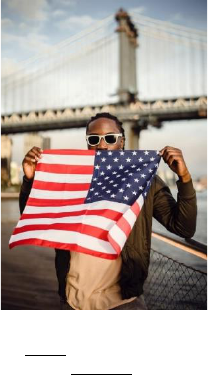
OUR LIVES: AN ETHNIC STUDIES PRIMER 135
Some form of cultural bias is evident in everyone (Bucher, 2008). Whether you have
preferences based on race, ethnicity, gender, sexuality, (dis)ability, region, social class or all
social categories, they affect your thoughts and interactions with others. Many people believe
women are nurturers and responsible for child rearing, so some do not support men receiving
custody of the children when there is a divorce in the family. Bias serves as the foundation for
stereotyping and prejudice (Bucher, 2008). Many of the ideas we have about others are
ingrained, and we have to unlearn what we know to reduce or manage bias. Removing bias
perspectives requires resocialization through an ongoing conscious effort in recognizing our
bias then making a diligent effort to learn about others to dispel fiction from fact. Dealing with
bias commands personal growth and the biggest obstacles are our fears and complacency to
change.
Additionally, power structures and stratification emerge in cross-cultural conflicts. The
dynamics of power impact each of us (Bucher, 2008). Our assumptions and interactions with
each other are a result of our position and power in a particular context or setting. The social
roles and categories we each fall into effect how and when we respond to each other. A
Hispanic, female, college professor has the position and authority to speak and control conflict
of students in her classroom but may have to show deference and humility when conflict arises
at a faculty meeting she attends. The professor’s position in society is contextual and, in some
situations, she has the privileges of power, but in others, she may be marginalized or
disregarded.
Power affects how others view, relate, and interact with us (Bucher,
2008). Power comes with the ability to change, and when you have
power, you are able to invoke change. For example, the White racial
majority in the United States holds more economic, political, and social
power than other groups in the nation. The dominant group’s power in
the United States allows the group to define social and cultural norms as
well as condemn or contest opposing views and perspectives. This
group has consistently argued the reality of “reverse racism” even
though racism is the practice of the dominant race benefitting off the
oppression of others. Because the dominant group has felt prejudice
and discrimination by others, they want to control the narrative and use
their power to create a reality that further benefits their race by calling
thoughts and actions against the group as “reverse racism.”
However, when you are powerless, you may not have or be given the opportunity to participate
or have a voice. Think about when you are communicating with someone who has more power
than you. What do your tone, word choice, and body language project? Now imagine you are
the person in a position of power. What privilege does your position give you because of your
race, ethnicity, age, gender, or other social category? Power implies authority, respect,
significance, and value. Those of us who do not have a social position of power in a time of
conflict may feel and receive treatment that reinforces our lack of authority, disrespect,
insignificance, and devaluation. Therefore, power reinforces social exclusion of some inflating
Image by Ketut Subiyanto,
Pexels is licensed under
CC BY 4.0

OUR LIVES: AN ETHNIC STUDIES PRIMER 136
cross-cultural conflict (Ryle, 2008). We must assess our social and cultural power as well as
those of others we interact with to develop an inclusive environment that builds on respect and
understanding to deal with conflicts more effectively.
Communication is essential when confronted with cross-cultural conflict (Bucher, 2008).
Conflicts escalate from our inability to express our cultural realities or interact appropriately in
diverse racial-ethnic settings. In order to relate to each other with empathy and understanding,
we must learn to employ use of positive words, phrases, and body language. Rather than
engaging in negative words to take sides (e.g., “Tell your side of the problem” or “How did that
effect you?”), use positive words that describe an experience or feeling. Use open-ended
questions that focus on the situation or concern (e.g., “Could you explain to be sure everyone
understands?” or “Explain how this is important and what needs to be different”) in your
communications with others (Ryle, 2008). In addition, our body language expresses our
emotions and feelings to others. People are able to recognize sadness, fear, and disgust
through the expressions and movements we make. It is important to project expressions,
postures, and positions that are open and inviting even when we feel different or
uncomfortable around others. Remember, words and body language have meaning and set the
tone or atmosphere in our interactions with others. The words and physical expressions we
choose either inflate or deescalate cross-cultural conflicts.
The act of reframing or rephrasing communications is also helpful in managing conflicts
between diverse people. Reframing requires active listening skills and patience to translate
negative and value-laden statements into neutral statements that focus on the actual issue or
concern. This form of transformative mediation integrates neutral language that focuses on
APPLICATION 8.1
CULTURAL INTELLIGENCE RESOURCES
Goal
To recognize methods and approaches for interacting and building relations with diverse populations.
Instructions
1. What role does power play in our ability to collaborate with others and develop understanding?
2. How might power structures be created when one group tries to provide aid to another?
3. Research the Cultural Intelligence Center (https://culturalq.com/) and online videos such as Cultural
Intelligence: A New Way of Thinking by Jeff Thomas
(https://www.youtube.com/watch?v=K3S76gAKp6Q&feature=youtu.be). Describe what information, tools,
and practices are available to improve knowledge and communication skills with others.
4. Provide examples on how to apply the cultural intelligence in the following conditions or situations: (a)
minimize culture shock, (b) recognize ethnocentric attitudes and behaviors, (c) practice cultural relativism,
(d) develop multiple consciousness, and (e) step outside your comfort zone.
Source
Adapted from Kennedy, V. (2018). Beyond race: Cultural influences on human social life. West Hills College
Lemoore.

OUR LIVES: AN ETHNIC STUDIES PRIMER 137
changing the message delivery, syntax or working, meaning, and context or situation to resolve
destructive conflict. For example, reframe “That’s a stupid idea” to “I hear you would like to
consider all possible options.” Conversely, reframe a direct verbal attack, “She lied! Why do you
want to be friends with her?” to “I’m hearing that confidentiality and trust are important to
you.” There are four steps to reframing: 1) actively listen to the statement; 2) identify the
feelings, message, and interests in communications; 3) remove toxic language; and 4) re-state
the issue or concern (Ryle, 2008). These tips for resolving conflict help us hear and identify the
underlying interests and cultural realities.
Conflict Resolution Strategies & Practices
Interpersonal conflict involves situations when a person or group blocks expectations, ideas, or
goals of another person or group. Conflict develops when people or groups desire different
outcomes, opinions, offend one another, or simply do not get along (Black, et al., 2019). People
tend to assume conflict is bad and must be eradicated. However, a moderate amount of conflict
can be helpful in some cases. For example, conflict can lead people to discover new ideas and
new ways of identifying solutions to problems or conditions and is often the very mechanism to
inspire innovation and change. It can also facilitate motivation among groups, communities,
and organizations to excel and push themselves in order to meet outcomes and objectives
(Black et al., 2019). According to Coser (1956), conflict is likely to have stabilizing and unifying
functions for a relationship in its pursuit for resolution. People and social systems readjust their
structures to eliminate dissatisfaction to re-establish unity.
The appropriate conflict resolution approach depends on the situation and the goals of the
people involved. According to Thomas (1977), each faction or party involved in the conflict
must decide the extent to which it is interested in satisfying its own concerns categorized
as assertiveness and satisfying their opponent’s concerns known as cooperativeness (Black et
al., 2019). Assertiveness can range on a continuum from assertive to unassertive, and
cooperativeness can range on a continuum from uncooperative to cooperative. Once the
people involved in the conflict have determined their level of assertiveness and
cooperativeness, a resolution strategy emerges.
In the conflict resolution process, competing individuals or groups
determine the extent to which a satisfactory resolution or outcome
might be achieved. If someone does not feel satisfied or feels only
partially satisfied with a resolution, discontent can lead to future
conflict. An unresolved conflict can easily set the stage for a second
confrontational episode (Black et al., 2019).
Anti-racist allies can use several techniques to help prevent or reduce
conflict. Actions directed at conflict prevention are often easier to
implement than those directed at reducing conflict (Black et al., 2019).
Common conflict prevention strategies include emphasizing
collaborative goals, constructing structured tasks, facilitating
Image by Ficky, Pexels is
licensed under CC BY 4.0

OUR LIVES: AN ETHNIC STUDIES PRIMER 138
intergroup communications, and avoiding win-lose situations. Focusing on collaborative goals
and objectives prevents goal conflict (Black et al., 2019). Emphasis on primary goals help clients
and community members see the big picture and work together. This approach separates
people from the problem by maintaining focus on shared interests (Fisher and Ury, 1981). The
overarching goal is to work together to address the structure of the overarching social concern
or issue.
Table 5. Five Modes of Resolving Conflict
Conflict-Handling Modes
Appropriate Situations
Competing
(Assertive-Uncooperative)
1. When quick, decisive action is vital—e.g., emergencies
2. On important issues where unpopular actions need implementing—
e.g., cost cutting, enforcing unpopular rules, discipline
3. On issues vital to company welfare when you know you’re right
4. Against people who take advantage of noncompetitive behavior
Collaborating
(Assertive-Cooperative)
1. When trying to find an integrative solution when both sets of concerns
are too important to be compromised
2. When your objective is to learn
3. When merging insights from people with different perspectives
4. When gaining commitment by incorporating concerns into a consensus
5. When working through feelings that interfered with a relationship
Compromising
1. When goals are important but not worth the effort or potential
disruption of more assertive modes
2. When opponents with equal power are committed to mutual goals
3. When attempting to achieve temporary settlements to complex issues
4. When arriving at expedient solutions under time pressure
5. As a backup when collaboration or competition is unsuccessful
Avoiding
(Unassertive-
Uncooperative)
1. When an issue is trivial or when more important issues are pressing
2. When you perceive no chance of satisfying your concerns
3. When potential disruption outweighs the benefits of resolution
4. When letting people cool down and regain perspective
5. When gathering information supersedes immediate decision
6. When others can resolve the conflict more effectively
7. When issues seem tangential or symptomatic of other issues
Accommodating
(Unassertive-Cooperative)
1. When you find you are wrong—to allow a better position to be heard,
to learn, and to show your reasonableness
2. When issues are more important to others than yourself—to satisfy
others and maintain cooperation
3. When building social credits for later issues
4. When minimizing loss when you are outmatched and losing
5. When harmony and stability are especially important
6. When allowing subordinates to develop by learning from mistakes
Source: Adapted from Thomas, Kenneth W. 1977. “Toward Multidimensional Values in Teaching: The Example
of Conflict Behaviors.” Academy of Management Review 2:487.
Attribution: Copyright Rice University, OpenStax, under CC BY-NC-SA 4.0 license

OUR LIVES: AN ETHNIC STUDIES PRIMER 139
When collaborative partners clearly define, understand, and accept tasks and activities aimed
at shared goals, conflict is less likely to occur (Black et al., 2019). Conflict is most likely to occur
when there is uncertainty and ambiguity in the roles and tasks of groups and community
members. Dialogue and information sharing among collaborative partners is imperative and
eliminates conflict. Understanding others’ thinking is helpful in collaborative problem solving.
Through dialogue, people are better able to develop empathy, avoid speculation or
misinterpreting intentions, and escape blaming others for situations and problems which leads
to defensive behavior and counter attacks (Fisher and Ury, 1981). Sharing information about
the state, progress, and setbacks helps eliminate conflict or suspicions about problems or issues
when they arise.
As groups and community partners become familiar with each other, trust and teamwork
develop. Giving people time to interact and get to know each other helps foster and build
effective working relationships (Fisher and Ury, 1981). It is important for collaborative members
to think of themselves as partners in a side-by-side effort to be effective in their anti-racist work
and accomplish shared goals. Avoiding win-lose situations among collaborative partners also
weakens the potential for conflict (Black et al., 2019). Rewards and solutions must focus on
shared benefits resulting in win-win scenarios.
Conflict can have a negative impact on teams or collaborative work groups and individuals in
achieving their goals and solving social issues. People cannot always avoid or protect
themselves or others from conflict when working collaboratively. However, there are actions
everyone can take to reduce or solve dysfunctional conflict.
When conflict arises, you may employ two general approaches by either targeting changes in
attitudes and/or behaviors. Changes in attitudes result in fundamental changes in how groups
get along, whereas changes in behavior reduce open conflict but not internal perceptions
maintaining separation between groups (Black et at., 2019). There are several ways to help
APPLICATION 8.2
CONFLICT REDUCTION IN ACTION
Goal
To choose, connect, and reframe our approaches to conflict.
Instructions
1. Watch Finding Confidence with Conflict presented by Kwame Christian (https://youtu.be/F6Zg65eK9XU).
2. Identify a time or event in your life when you experienced racial-ethnic conflict.
3. Share how you responded. Did you fight, flee, or freeze? Explain how your lived experience influenced
your response.
4. Do you find it difficult to stand up for yourself or others in difficult conversations? Do you agree with
others when you personal disagree? Do you avoid conflicts all together?
5. For personal and professional success, you must be willing to engage in conflict. How can you build new
habits to feel confident with conflict and manage confrontations in a productive way?

OUR LIVES: AN ETHNIC STUDIES PRIMER 140
reduce conflict between groups and individuals that either address attitudinal and/or
behavioral changes. The nine conflict reduction techniques in Table 6 operate on a continuum,
ranging from approaches that concentrate on changing behaviors at the top of the scale to
tactics that focus on changing attitudes on the bottom of the scale.
Table 6. Conflict Reduction Techniques
Technique
Description
Target of Change
Physical separation
Separate conflicting groups when
collaboration or interaction is not
needed for completing tasks and
activities
Behavior
Use rules
Introduce specific rules,
regulations, and procedures that
impose particular processes,
approaches, and methods for
working together
Behavior
Limit intergroup interactions
Limit interactions to issues
involving common goals
Behavior
Use diplomats
Identify individuals who will be
responsible for maintaining
boundaries between groups or
individuals through diplomacy
Behavior
Confrontation and negotiation
Bring conflicting parties together to
discuss areas of disagreement and
identify win-win solutions for all
Attitude and behavior
Third-party consultation
Bring in outside practitioners or
consultants to speak more directly
to the issues from a neutral or
outsider vantage point to help
facilitate a resolution
Attitude and behavior
Rotation of members
Rotate individuals from one group
to another to help understand
frame of reference, values, and
attitudes of others
Attitude and behavior
Identify interdependent tasks and
common goals
Establish goals that require groups
and individuals to work together
Attitude and behavior
Use of intergroup training
Long-term, ongoing training aimed
at helping groups develop methods
for working together
Attitude and behavior
Source: Adapted from Black, J. Stewart, David S. Bright, Donald G. Gardner, Eva Hartmann, Jason Lambert, Laura
M. Leduc, Joy Leopold, James S. O’Rourke, Jon L. Pierce, Richard M. Steers, Siri Terjesen, and Joseph Weiss.
2019. Organizational Behavior. Houston, TX: OpenStax College.
Attribution: Copyright Rice University, OpenStax, under CC BY-NC-SA 4.0 license
Truth Telling & Social Discourse
An unequal part of systems of power is the way discourse operates. Social justice advocates and
allies become attuned to bias and exclusion for the stand they take towards speaking the truth
about White authority and privilege (Burbules, 2018). In the face of truth, the dominant group

OUR LIVES: AN ETHNIC STUDIES PRIMER 141
creates a context that shields any claims of scrutiny upon Whites and reinforces the
unquestionable naturalness or normality of their status and power.
Truthfulness involves accuracy aiming at the facts and sincerity to speak about reality with
honest motives in the truth we speak (Williams, 2002). There are many aspects to contemplate
in truth telling including awareness of context, history, personal experiences, equity, and justice
in the United States. The implication and responsibility for Whites in a racist society centers on
the framework of truthfulness; however, various degrees of ignorance about racial-ethnic
minorities is problematic making the idea of “truth” relative in the eyes of Whites. Burbules
(2018) identified five types of ignorance that influence the racial-ethnic empathy of Whites.
Table 7. Types of Ignorance
Type
Characteristics
Forgivable
Could not expect to know
Lethargic
A lack of effort to find out
Apathetic
Should have made the effort to find out
Willful
Refuse to acknowledge
Suppressed or unconscious
Unable or unwilling to fully acknowledge though aware
Source: Adapted from Burbules, N. C. (2018). The role of truth in social justice education . . . and elsewhere.
Philosophy of Education Society.
The conspiracy of silence has long been the tactic used by the White race to outwardly ignore
the mistreatment and injustices bestowed on people of color in the United States (Zerubavel,
2006). Silence is practiced by never publicly discussing or mentioning open secrets such as the
sexual assaults and exploitations of slaves by masters in the antebellum South. White
conspirators become silent witnesses by keeping the uncomfortable truth hidden in plain sight
and perpetuating a sociology of denial including the murder, torture, rape, theft, and other
inhumane and unlawful treat to people of color by Whites in the United States (Krugman,
2002).
According to Zerubavel (2006), denial arises from a need to
avoid discomfort and pain. To avoid psychological distress,
people may choose to block disturbing information from
consciousness. The psychological feelings of fear and
embarrassment also reinforce denial. It is challenging for
some people to talk about issues or conditions that
frighten or shame them. The conspiracy of silence has
allowed Whites to actively avoid and deliberately refrain
from noticing and refusing to acknowledge their presence
in the oppression of indigenous and people of color in the
United States (Zerubavel, 2006).
Image by Brett Sayles, Pexels is licensed under
CC BY 4.0

OUR LIVES: AN ETHNIC STUDIES PRIMER 142
Both normative pressure and political constraint maintain conspiracies of silence among the
dominant group. The power and status of Whites imparts their control on the scope of
attention on racial-ethnic group relations through formal censorship to informal distraction
tactics using formal agenda-setting procedures and informal codes of silence (Zerubavel, 2006).
As the demographic changes in the United States, it threatens the power, privilege, and status
of the White race, pain, fear, and embarrassment grow among the dominant group. The White
race is now faced with shifts in society and culture, and the need to reconcile White thought,
beliefs, attitudes, and behaviors with racial-ethnic minority groups is overdue.
SUMMARY
In Module 8, we examined the impact of racism and discrimination on race-based trauma and
stress. We learned about the diverse coping mechanisms people of color develop including the
adaptive and change-oriented strategies they utilize. You were asked to explore the Native
American experience in the United States, and to think about anti-racist and anti-colonial
practices to improve your relationships with diverse groups and people. We also explored the
five major approaches to reducing prejudice. And lastly, we reviewed the strategies and
methods for building community and making connections with diverse populations.
REVIEW QUESTIONS
1. Discuss the strategies people of color use to cope with their subordinate or minority status.
2. Describe anti-racist, anti-colonial practices, ways to reduce prejudice in our society.
3. Illustrate ways to resolve and reduce cross-cultural conflict.
4. Reflecting on the history and experiences of major underrepresented racial groups
including African Americans, Asian Americans, Latinx Americans, and Native Americans,
explain the significance of race and ethnicity on the development and progress of the
United States.
TO MY FUTURE SELF
From the module, what information and new knowledge did I find interesting or useful? How
do I plan to use this information and new knowledge in my personal and professional
development and improvement?

OUR LIVES: AN ETHNIC STUDIES PRIMER 143
APPLICATION 8.3
FOSTERING CONNECTIONS
Goal
To share our social and cultural experiences with others in our community to make connections within diverse
populations.
Instructions
1. For this activity, interview another student in class. Record the student’s responses to the following:
CULTURAL EXPRESSIONS
• What are typical foods served in the culture?
• Are there any typical styles of dress?
• What do people do for recreation?
• How is space used (e.g., How close should two people who are social acquaintances stand next to
one another when they are having a conversation?)
• How is public space used? For example, do people tend to “hang out” on the street, or are they in
public because they are going from one place to the next?
STANDARD BEHAVIORS
• How do people greet one another?
• Describe how a significant holiday is celebrated.
• How would a visitor be welcomed into a family member’s home?
• What are the norms around weddings? Births? Deaths?
SPECIFIC BELIEFS
• How important is hierarchy or social status?
• How are gender roles perceived?
• How do people view obligations toward one another?
• What personal activities are seen as public? What activities are seen as private?
• What are the cultural attitudes toward aging and the elderly?
ENTRENCHED IDEOLOGIES
• How important is the individual in the culture? How important is the group?
• How is time understood and measured? (e.g., How late can you be to class, work, family event, or
appointment before you are considered rude?)
• Is change considered positive or negative?
• What are the criteria for individual success?
• What is the relationship between humans and nature? (e.g., Do humans dominate nature? does
nature dominate humans? Do the two live in harmony?)
• What is considered humorous or funny?
• How do individuals “know” things? (e.g., Are people encouraged to question things?
Are they encouraged to master accepted wisdom?)
• Are people encouraged to be more action-oriented (i.e., doers) or to be contemplative (i.e., thinkers)?
• What is the role of luck in people’s lives?
• How is divine power or spirituality viewed?
2. With your partner or pair for this activity, develop a presentation to share your responses and insights
about each other with the class.
Source
Adapted from Kennedy, V. (2018). Beyond race: Cultural influences on human social life. West Hills College
Lemoore.

OUR LIVES: AN ETHNIC STUDIES PRIMER 144
REFERENCES
Aberle, D. (1966). The peyote religion among the Navaho. Aldine.
Allport, G. W. (1954). The nature of prejudice. Addison-Wesley.
Armstrong, J. S. (1977). Designing and using experiential exercises. University of Pennsylvania
ScholarlyCommons. https://repository.upenn.edu/marketing_papers/26
Black, J. S., Bright, D. S., Gardner, D. G., Hartmann, E., Lambert, J., Leduc, L. M., Leopold, J.,
O’Rourke, J. S., Pierce, J. L., Steers, R. M., Terjesen, S., & Weiss, J. (2019). Organizational
behavior. OpenStax College.
Bruhn, J. G. & Rebach, H. M. (2007). Sociological practice: Intervention and social change. (2
nd
ed). Springer.
Bucher, R. D. (2008). Building cultural intelligence (CQ): 9 megaskills. Prentice Hall.
Burbules, N. C. (2018). The role of truth in social justice education . . . and elsewhere.
Philosophy of Education Society.
Comas-Diaz, L. & Jacobsen, F. (2001). Ethnocultural allodynia. Journal of Psychotherapy Practice
and Research, 10(4), 246-252.
Conerly, T. R., Holmes, K. & Tamang, A. L. (2021). Introduction to sociology 3e. OpenStax
College.
Coser, L. A. (1956). The functions of social conflict. Free Press.
Dovidio, J. F. & Gaertner, J. D. (1999). Reducing prejudice: Combatting intergroup biases.
Current Directions in Psychological Science, 8(4), 101-105.
Ellis, A. (1992). Rational-emotive approaches to peace. Journal of Cognitive Psychotherapy, 6(2),
79-104.
Fadiman, A. (1997). The spirit catches you and you fall down : a Hmong child, her American doctors,
and the collision of two cultures (1st ed.). Farrar, Straus, and Giroux.
Farley, J. E. (2010.) Majority-minority relations. (6
th
ed.). Prentice Hall.
Fineberg, S. A. (1949). Punishment without crime. Doubleday.
Fishbein, H. D. (1996). Peer prejudice and discrimination: Evolutionary, cultural, and
developmental dynamics. Westview Press.

OUR LIVES: AN ETHNIC STUDIES PRIMER 145
Fisher, R. & Ury, W. (1981). Getting to yes negotiating agreement without giving in. Penguin
Group.
Flowerman, S. H. (1947). Mass propaganda in the war against bigotry. Journal of Abnormal and
Social Psychology, 42, 429-439.
Grossarth-Maticek, R., Eysenck, H. J., & Vetter, H. (1998). The causes and cures of prejudice: An
empirical study of the frustration-aggression hypothesis. Personality and Individuals
Differences, 10, 547-549.
Hamilton-Merritt, J. (1993). Tragic mountains: the Hmong, the Americans, and the secret wars for
Laos, 1942-1992. Indiana University Press.
Henslin, J. M. (2011). Essentials of sociology: A down-to-earth approach. (11
th
ed.). Pearson.
Hewstone, M., Rubin, M., & Willis, H. (2002). Intergroup bias. Annual Review of Psychology, 53,
575-604.
Hovland, C. I. Janis, I. L., & Kelley, H. H. (1953). Communication and persuasion. Yale University
Press.
Ivey-Colson, K. & Turner, L. (2020). 10 keys to everyday anti-racism. Greater Good Magazine.
https://greatergood.berkeley.edu/article/item/ten_keys_to_everyday_anti_racism
Kennedy, V. (2018). Beyond race: Cultural influences on human social life. West Hills College
Lemoore.
Krugman, P. (2000, December). Gotta have faith. New York Times, A35.
Lessing, E. E. & Clarke, C. C. (1976). An attempt to reduce ethnic prejudice and assess its
correlates in a junior high school sample. Educational Research Quarterly, 1(2), 3-16.
Lewin, K. (1948). Resolving social conflicts. Harper & Row.
Lopez, G. E., Gurin, P., & Nagda, B. A. (1998). Education and understanding structural causes for
group inequalities. Journal of Political Psychology, 19, 305-329.
McGuire, W. J. (1968). Personality and susceptibility to social influence. In E. F. Borgatta & W.
W. Lambert (Eds.), Handbook of personality theory and research (pp. 1130-87). Rand
McNally.
Nagda, B. A. (2006). Breaking barriers, crossing borders, building bridges: Communication
processes in intergroup dialogues. Journal of Social Issues, 62, 553-576.

OUR LIVES: AN ETHNIC STUDIES PRIMER 146
Pettigrew, T. F. (1998). Intergroup contact theory. Annual Review of Psychology, 49, 65-85.
Resler, M. (2019). Systems of trauma: Racial trauma. Family & Children’s Trust Fund of Virginia.
https://www.fact.virginia.gov/wp-content/uploads/2019/05/Racial-Trauma-Issue-
Brief.pdf
Ryle, J. L. (2008). All I want is a little peace. Central California Writers Press.
60 Minutes. (2015 August 13). Hmong Our Secret Army. [YouTube].
https://www.youtube.com/watch?v=L4U2P7tsOAQ
Smith, H. (2006). Invisible racism. Psychoanalytic Quarterly, 75, 3-19.
Southern Poverty Law Center. (2020). White nationalist. The Southern Poverty Law Center.
https://www.splcenter.org/fighting-hate/extremist-files/ideology/white-nationalist
Stiff, J. B. & Mongeau, P. A. (2003). Persuasive communication. (2
nd
ed). Guilford Press.
Thomas, K. W. (1977). Toward multidimensional values in teaching: The example of conflict
behaviors. Academy of Management Review, 2,487.
Triandis, H. C. (1971). Attitude and attitude change. Wiley.
Williams, B. (2002). Truth and truthfulness: An essay in genealogy. Princeton University Press,
246.
Zerubavel, Eviatar. (2006). The elephant in the room: Silence and denial in everyday life. Oxford
University Press.
